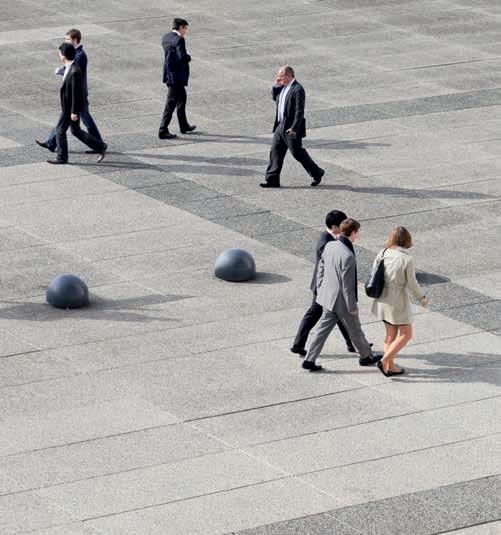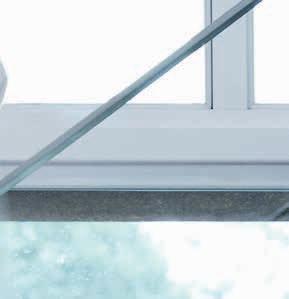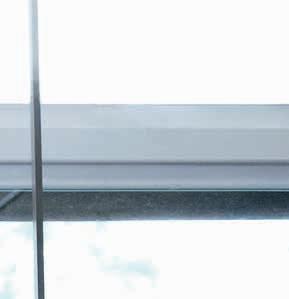TIMELESS INSPIRATION


TIMELESS INSPIRATION

Talks a life in film and taking a cinematic approach to his family wine estate, Mas des Infermières
STANLEY TUCCI | PARIS OLYMPICS SPECIAL | 2024 WEALTH REPORT
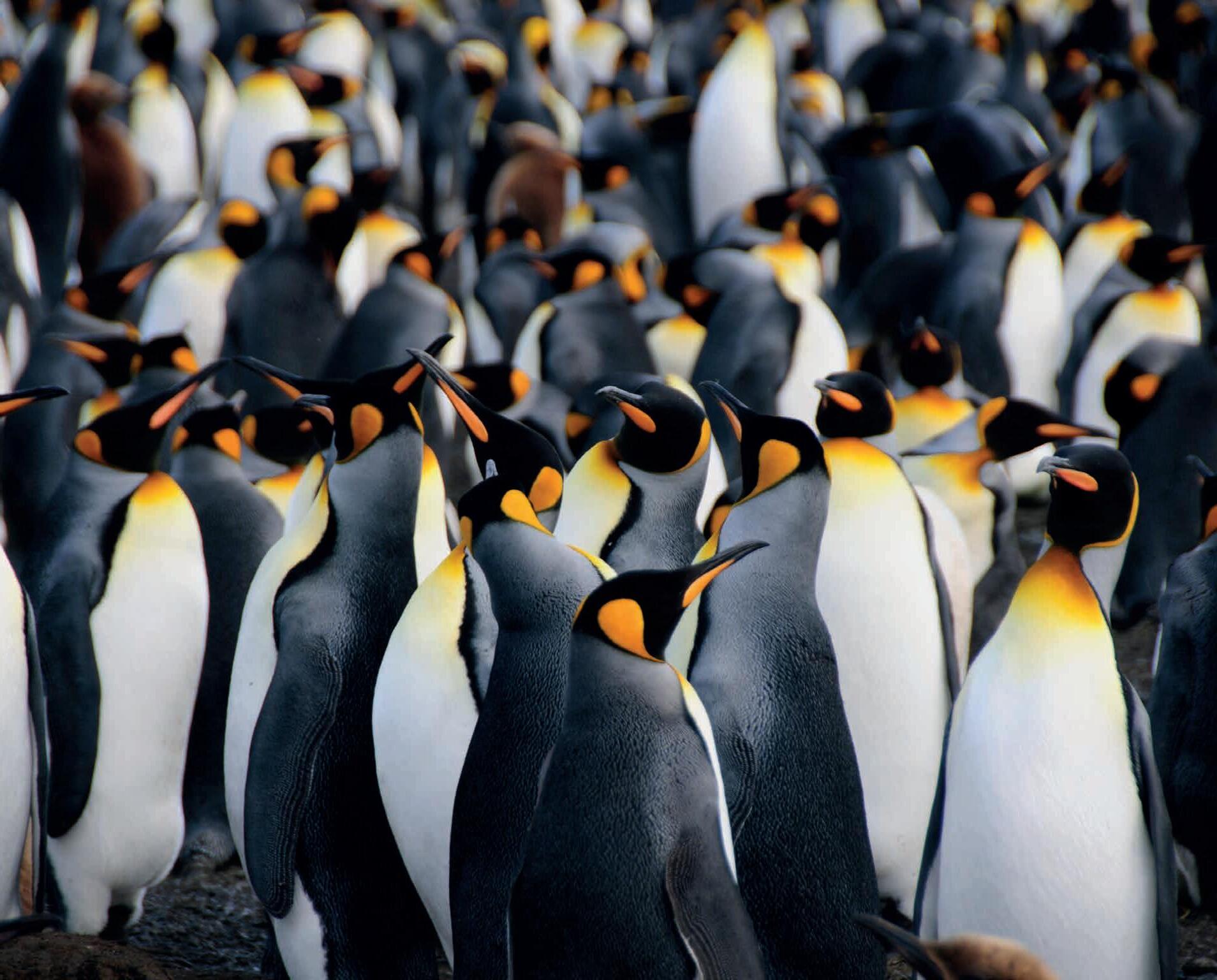

Life’s too short to follow the crowd, to only see things one way. We’re here for those who carve their own path, for those who have the courage to think big. The explorers and the curious, the doers of dreams, the seekers of maximised moments; the lovers of beauty, of magic and of wonder; the investors in emotional wealth.
We’re here for them. We’re here for you.




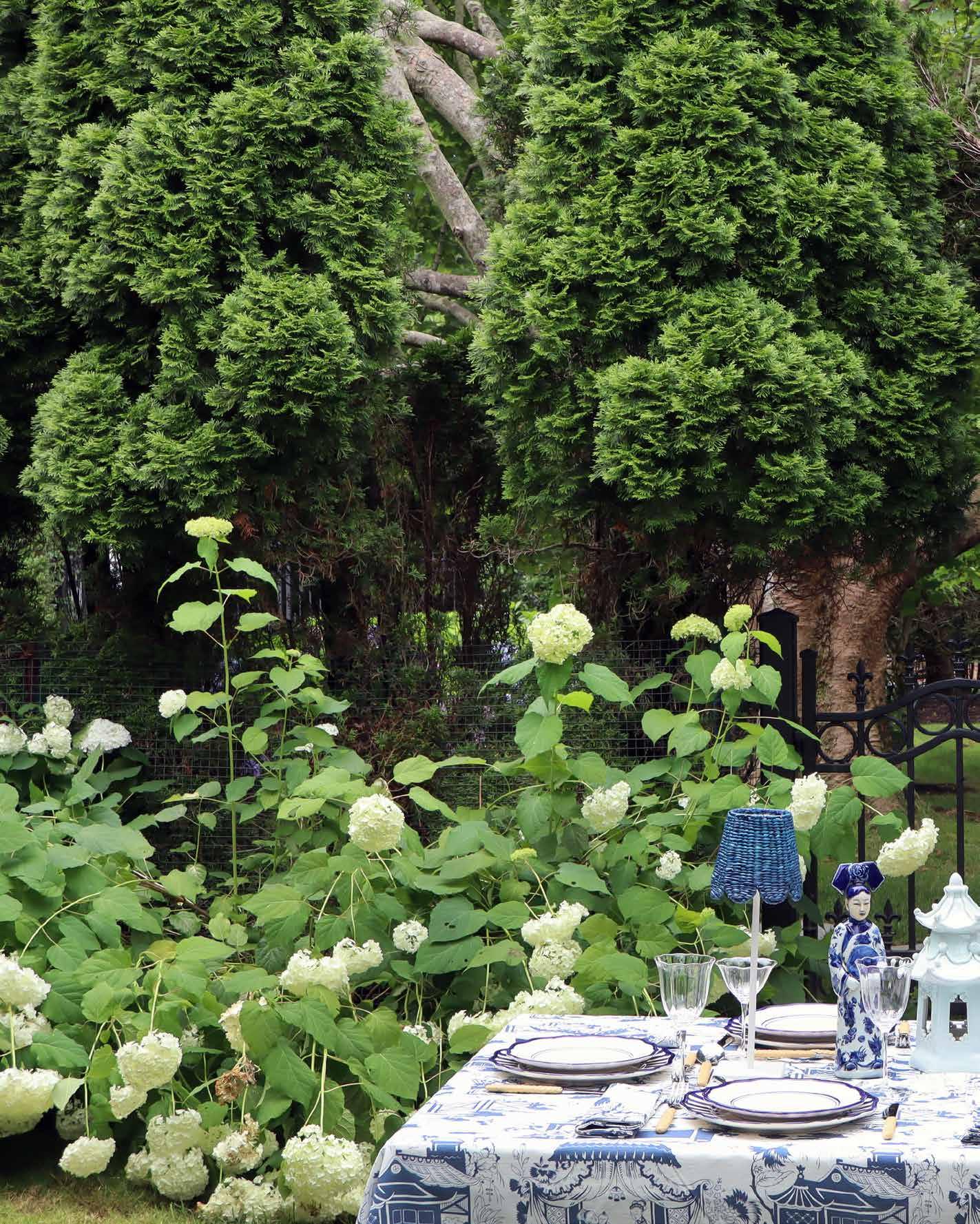


Whether you’re a devoted sports fan or a fair-weather supporter, there’s no escaping the athletic euphoria sweeping Europe during this year’s mighty summer of sport. There have already been some stand out moments from tournaments including UEFA Euro 2024, Formula 1 and Wimbledon, but the event dominating headlines is, of course, the Olympic Games Paris 2024.
With the French capital hosting the Olympic and Paralympic Games for the third time in its history, there is a distinct air of competition and celebration as the world’s best athletes push themselves to the limit on the global stage. Read more about our favourite events and athletes to watch in our special feature on page 54.
But the beauty of the Olympic and Paralympic Games is not just the skill of the remarkable athletes at the centre of the event but how they inspire and motivate us in everyday life. Add to that how many star athletes are vocal advocates for others: US gymnast Simone Biles’s mental health advocacy, UK diver Tom Daley OBE’s work for LGTBQ+ charity Switchboard and Comic Relief, or Paralympic fencer Bebe Vio’s academy to promote accessible sport, to name just a few.
It’s no wonder the Games are so uplifting to both
fans and casual viewers alike. That mix of dedication to reach the highest level of your field, discipline to train relentlessly and resilience to rise again if you don’t succeed – all underpinned by strong values – is truly a winning combination from which we can all draw inspiration.
Similarly, when I first met our cover star, Gladiator II director Sir Ridley Scott, in Paris to learn more about his family wine estate Mas des Infermières, he revealed his own winning method for dealing with the ups and downs of his 60+ year career in film: “My motto is: ‘Just do it – but do it the best you can’.” Read the full interview on page 36.
Inspired by these global success stories, Tempus’s summer edition is packed with motivating stories, from interviews with new Chaumet CEO Charles Yeung (26) and Coldplay’s Guy Berryman (82) to the enduring magic of the historic Mille Miglia (30) and the next giant leap for space tourism (46). Find out how Necker Island is leading the pack for regenerative travel (74), step inside the world’s most fashionable watch manufactory (90), discover how to future-proof your finances (96) and much more.
Enjoy the issue.

Michelle Johnson Editor-in-chief Tempus
THE BEAUTY OF THE OLYMPIC AND PARALYMPIC GAMES IS NOT JUST THE SKILL OF THE REMARKABLE ATHLETES, BUT HOW THEY INSPIRE AND MOTIVATE US IN EVERYDAY LIFE





Judy Cogan
Say “bonjour” to Paris as Judy heads to the French capital in the year of the Olympic Games on page 66, and takes the phrase “jetting off” to a new level with Halo Space (46)
Editor-in-chief
Michelle Johnson michelle@tempusmagazine.co.uk
Creative Director Ross Forbes ross@tempusmagazine.co.uk
Digital Editor
Shivani Dubey shivani@tempusmagazine.co.uk
Wealth Editor
Lysanne Currie
Motoring Editor Rory FH Smith
Stephanie Gavan
Contemporary art expert and writer Stephanie heads to this year’s Venice Biennale art fair, where she discovers the best exhibitions and creatives at the global extravaganza (18)
Oliver Gregson
The region head for the UK, Channel Islands & Ireland at J.P. Morgan Private Bank looks to the future of finance in our latest wealth report (96) –and the investment trends to watch
Chief Sub-Editor
Dominique Dinse
COMMERCIAL
Head of Partnerships
Dan Scudder
dan@tempusmagazine.co.uk
+44 (0) 203 519 1005
VANTAGE MEDIA
Chairman Floyd Woodrow
Managing Director Peter Malmstrom
COVER IMAGE
Filmmaker Sir Ridley Scott
Credit: ©Austin Hargrave/AUGUST Article on page: 36
Rory FH Smith
Tempus motoring expert Rory joins racing royalty at the Mille Miglia (30), before highlighting the world’s most exciting athletes to watch at the Olympic and Paralympic Games Paris 2024 (54)
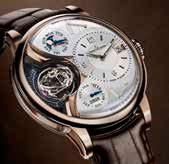


10 The Luxe List Our essential guide to this season’s finest gifts and most exciting new launches
14 Shaking things up Actor Stanley Tucci shares his passion for cocktails – and love of London’s food scene
18 Beautiful strangers We head to the Venice Biennale for the best of this year’s global art extravaganza
26 Passing the torch Chaumet CEO Charles Leung shares his fine jewellery philosophy
30 A race through time Discover the enduring magic of the Mille Miglia
36 Exclusive: Source of inspiration How filmmaker Sir Ridley Scott is taking a cinematic approach to winemaking
42 Western charm Cowboys, cocktails and culture in the ‘New West’ of Scottsdale, Arizona
46 Space to explore Could Halo redefine space tourism with its new Aurora capsule experience?
50 Exclusive: Hyper horology Roger Dubuis CMO Sadry Keiser on the watchmaker’s tribute to the tourbillon
54 Summer of sport Tempus pays tribute to the Olympic and Paralympic Games Paris 2024
64 Views from the finish line Olympic sprinter-turned-broadcaster Jeanette Kwakye on the evolving world of women’s sports
66 Paris, je t’aime Celebrate the City of Lights with our essential guide to the French capital
70 Joy by the glass Superstar sommelier Henna Zinzuwadia is putting the spotlight on world food and wine
74 The wild isle How Sir Richard Branson’s Necker Island has become a beacon of impactful regenerative travel
80 Carefree castaway These private island resorts are the epitome of exclusive and tranquil luxury
82 ’Fit for purpose Coldplay’s Guy Berryman on the challenges and triumphs of his clothing label, Applied Art Forms
86 Wonderful world We explore the best novelties from this year’s Watches & Wonders horology fair
90 Journey into savoir faire Step inside La Fabrique du Temps Louis Vuitton with the brand’s new Escale colletion
96 Future-proof finance J.P. Morgan’s Oliver Gregson shares the investment trends to watch
100 Banking on creativity The fascinating reason why the UK’s biggest financial institutions are getting creative
103 RE:VIEW Alex and Emma Watson on their family fine gin brand, plus our pick of the season’s theatre, exhibitions and more
108 Save the date The finest events of the season
112 Prep yourself Tempus style columnist Rikesh Chauhan delivers Pitti Uomi’s greatest preppy hits

Our essential guide to the most exciting new launches and finest seasonal gifts


Baker Brothers Summer of Colour Collection
Celebrate the bold and beautiful colours of summer with the Baker Brothers’ stunning range of rings, necklaces, earrings and more. The bespoke jewellery specialists handpick each colourful gemstone – from vivid emerald, fiery ruby or delicate aquamarine – to craft unique pieces to suit every preference, ensuring you find the perfect stone to reflect your creativity, individuality and style. Find out more about the Summer of Colour collection on page 24
bakerbrothersdiamonds.com

Ulysse Nardin Diver Atoll
At first glance, this 100-piece limited-edition timepiece (left) may appear more traditional than Ulysse Nardin’s groundbreaking Freak collection, but look closer and the 39mm timepiece Diver Atoll is bursting with technical brilliance. Water resistant to 300m, the watch showcases a unique chrysocolla stone-cut dial reflecting tropical ocean, 80% recycled stainless steel case and a uni-directional rotating bezel set with 40 diamonds (a further 11 diamonds mark the hour indexes) for a total of 0.92ct. Inside, the watch is powered by an in-house movement and Ulysse Nardin’s silicon escapement technology, ensuring stylish ocean vibes at all hours.
ulysse-nardin.com

Playseat Formula Instinct - F1 Edition
Bring the thrills of Formula 1 straight to your living room with this exceptional racing simulator (left). Created in collaboration with Formula 1, this simulator not only provides an excitingly realistic and immersive racing experience, but Playseat’s lightweight cockpit perfectly replicates the authentic racing position of superstar drivers including Max Verstappen and Oscar Piastri. The
Brora 44-Year-Old Untold Depths
Restored highland distillery Brora celebrated a landmark moment this summer, as its first new batch of fine scotch whisky in 40 years came of age. To celebrate this milestone, Brora has released a second distillery exclusive bottling in the Brora 44-Year-Old Untold Depths (right). The 150 limited edition Untold Depths honours the distillery’s ‘age of peat’ with a single cask bottling from 1977 – bottled from cask number 2637, Warehouse No 1 – and priced at £10,000. Slàinte Mhath! »
diageo.com


6
Holland & Holland Invitation in Colour
Fine gunmakers Holland & Holland have released a stunning new bespoke offering bursting with colour – just in time for the Glorious Twelfth. Elevating the brand’s already impressive legacy of artistic engraving, this innovative technical process allows for industryleading shading and blending in full colour, for the first time in its 200-year history (right). Holland & Holland artisans were inspired by techniques found in jewellery and watchmaking, and their developments bring colourful natural scenes to life to add to the owner’s unique story. Available for all guns in Holland & Holland’s Royal collection, this luxurious addition is right on target.
hollandandholland.com
Co-Lab 369 Cavort West
Whether you’re an art-lover or looking for an extraordinary accessory for that finishing twist to your outfit, look no further than CoLab 369’s latest made-to-order limited edition silk wrap, Cavort West (left). Part of the collaborative capsule collection with artist Kate MccGwire, this is a timeless piece that resonates on a deeper level. An aesthetic fusion of art, nature and fashion, this distinctive easy-to-wear wrap embodies the essence of luxury, with Co-Lab 369’s commitment to uncompromising quality and exquisite sustainable materials – all beautifully hand-finished by artisans in Como, Italy.
colab369.com


SPONSORED CONTENT
7
Private Client by Bupa Premium private health insurance that goes beyond health cover, designed for your total wellbeing and designed to be used. You’ll be covered by our Ultimate Global Health Plan, our most extensive worldwide protection. Giving you access to leading international experts and facilities, worldwide. You’ll have a dedicated Lifecare Concierge Manager, a single point of contact to proactively manage your health journey. We’re here not only to return you to health, but to keep you in good health, whether that’s through annual health checks, cryotherapy, vitamin infusions or one of our various preventive treatments. More than healthcare, this is lifecare.
bupaprivateclient.com

Within 51/49
These perfect new summer fragrances from newly launched parfumier Within 51/49 have been created with wellness in mind. Seven unique scents make up ‘The Temple’, with natural ingredients enhanced by their own signature sound frequencies to maximise their mindful effects, effectively using sound as an ingredient to harmonise the scent. The first three perfumes focus on ‘emotional fusion’ – Pachamama combines violet leaf, lentisque and turmeric for inner strength; Jana fuses fig accord, sandalwood, cedarwood and turmeric for happiness; and Heavenly (right) promotes peace through neroli, orris and turmeric. A treat for the senses.
within5149.com
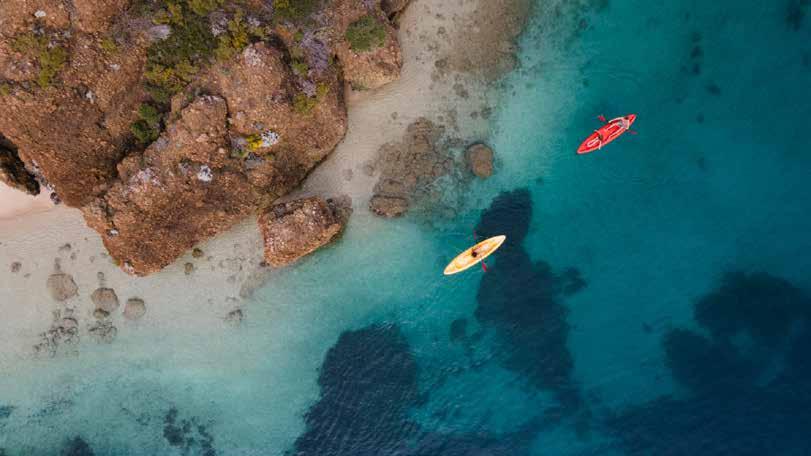
EnoDirect Roma
Elevate your home bar, cellar or event space with the elegant new Roma dispenser series (left) from Enomatic. Available as a four or eight bottle unit, the dual temperature dispensers can be programmed for service of both red and white wines. Temperature controls between 6˚C and 18˚C, and three configurable pour volumes for each bottle position. The Roma combines elegance, innovation and – most importantly – preservation of up to 21 days for your wine pairings. A high tech yet elegant way to enjoy your wines by the glass.
enodirect.co.uk

Steppes Travel
Wellness travel has never felt so good thanks to Steppes Travel’s range of bespoke travel experiences. Become immersed in ancient history with a cultural escape, get back to nature with a tiger safari or gorilla trek, visit the Galapagos in fine style with a private charter, or give back with one of the brand’s Positive Impact experiences. Steppes concierges can also provide private tours and exclusive access to many sites and museums, providing guests with an adventure like no other. Find out more about the wellness benefits of travel on page 74 steppestravel.com
Stanley Tucci shares his passion for cocktails and cooking – and tells us why London’s food scene is firmly on his radar
Words: Michelle Johnson
Actor Stanley Tucci is one of Hollywood’s favourite character actors, playing a variety of personalities on film and TV – from villainous to vaudevillian, heartbreaking to hilarious. But the American star’s fame shot to new heights when he began sharing his passion for cocktails and cooking on social media just a few years ago.
Now, Stanley (pictured) compliments his acting with award-nominated food documentaries, his own luxury cookware range and, of course, his latest partnership with Tanqueray No Ten.
“I like to work,” he says, with understatement.
“These are all things that I’ve always been really interested in: playing different characters, cocktails, food. So, for me, it’s been a question of how can I take that love I have and turn it into something that, ultimately, ends up being a form of entertainment?
“But it also enhances my life and lets me explore all those things I’m interested in, in a deeper way,” he adds. “If you love something, people see that.”
And this is certainly true of Stanley’s growing reputation as a cocktail connoisseur.
“I’ve always loved cocktails and I love the idea of promoting cocktail culture,” says Stanley, who has held the role of global ambassador for Tanqueray No Ten since 2021. “I’ve always loved Tanqueray. It’s this ubiquitous spirit; it’s been around forever. I remember my parents enjoying Tanqueray and tonic with my aunts and uncles in the summer.”
In April, The Lovely Bones and Spotlight actor teamed up with the fine gin-makers to launch a new series of cocktails residencies, starting with director of mixology Ago Perrone at London’s The Connaught Bar. Together, Stanley and Ago – who first met when the actor attended a ‘guest shift’ to learn from the martini master – have collaborated
to create a cocktail experience at the London bar that includes a bespoke Tanqueray No Ten cocktail, inspired by the negroni and the martini, and which can be adapted to guest’s individual preferences.
“It’s been a really exciting project,” says Stanley. “Our cocktail can be tailored to guests’ personal tastes. It’s important because some gins or some scotches, they are what they are, and you can’t play around with them a lot. A really peaty scotch, for example. I happen to not really care for really peaty scotches, and it’s the same with some gin, which, to me, can be a little too harsh or juniper-forward.
“Tanqueray No Ten is so sophisticated and its flavours are really malleable. I really like it on its own, but you can also play with it a lot and do so many different things with it. It can be whatever you want it to be,” he says, before revealing his favourite serve: “I love a very simple dry martini, straight up. That’s all I need.” »
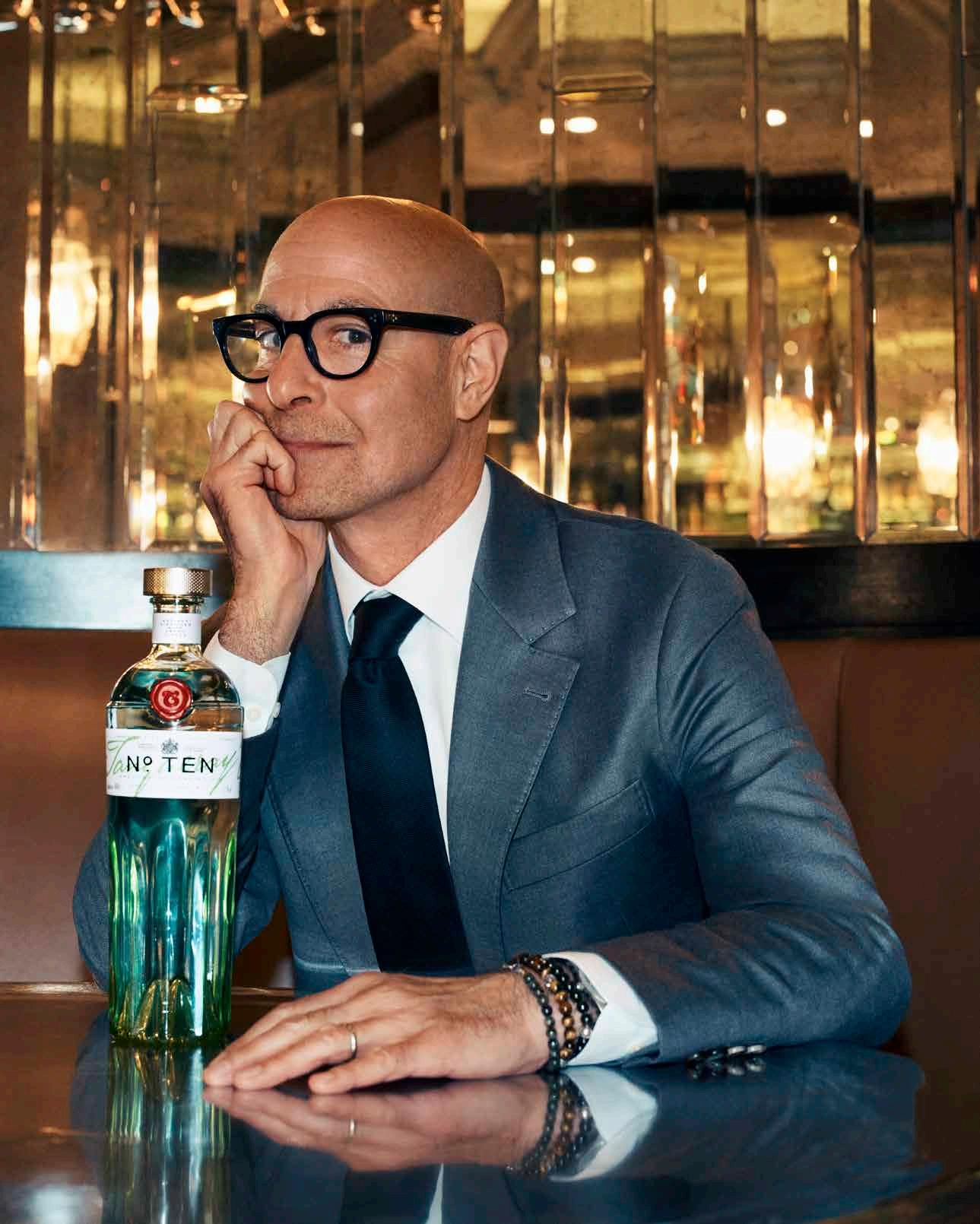


Cocktail culture: Stanley Tucci partners with mixologist Ago Perrone for Tanqueray No Ten
Stanley credits his love of cocktails and food to his family. Born to parents Joan and Stanley Sr in 1960, the actor grew up in Westchester County, New York, with a family that celebrated their Calabrian Italian heritage.
“Food is just everything to my family – as with many Italian families,” he says. “But I have to say, I’ve eaten in a lot of Italian homes and none of them have compared to what I ate in my own home or in my grandparents’ homes. I could say: ‘Oh, it’s because of the people’, but that’s not true. It’s actually because of the taste. The people help, but it’s really because of the taste.

“Growing up in the 1960s, things were more formal – it was only later that [society] started to become more casual – and so my father, when he was an art teacher, he went to school in a suit and tie every day and had a cocktail when he came home. Those were still the traditions that you stuck to,” he says.
“I also grew up watching a lot of old movies when I was young – movies from the ’30s, ’40s, ’50s – and I loved the elegance in the way people dressed, the way they talked. And I loved the way they had cocktails. I thought it was so cool; it was glamorous, exciting. You were poised and sophisticated – or at least you thought you were – if you had a martini in your hand.”
Stanley celebrated his love of Italian food in the 2021-2022 Emmy-winning documentary Stanley Tucci: Searching for Italy. In the hit series, Stanley travelled across the country to discover the delights of its variety of regional delicacies. But if the world were his oyster, are there any other global gastronomic destinations that he would love to explore?
“You know, because I’m in London, I’ve become really interested in British cuisine,” he says of his adopted home – Stanley’s wife, Felicity Blunt, is an English literary agent (and the sister of his The Devil Wears Prada co-star, Emily Blunt). “London has become a food mecca – it might be the most exciting place for world cuisines.”
This may seem a surprising answer when one considers the less-than-favourable reputation that British cuisine has long held among our European peers, but as Stanley expounds upon the capital’s distinct and unique history in relation to the British Empire, which reached its peak of power and influence between 18151915, the impressive gastronomic influences that underpin today’s food scene become clear.
“English cuisine is so interesting to me. Many major cities, certainly western cities, don’t have
such a varied food history. But London’s is so varied because of the many colonies [of the British Empire].” he says. “When you consider that most countries have the food they do because of the countries that invaded them – I think that Italy is an amalgam of Greek, African, Middle Eastern, Austrian, French and Spanish cuisine – but English cuisine is an amalgam of the world, because Britain invaded other countries, and took [cuisines] back home. And then, of course, those people from former colonies came [to the UK] and set up shop, as it were.
“Today, if you look at the food scene and the cocktail scene in London, there’s nothing like it. It’s come on in leaps and bounds even since I moved here – certainly since I first came here over 20 years ago,” he says. “Cocktails fell out of favour for a while, but now they’re back with a vengeance – and I’m glad because, I think, it’s just so cool.”
Future projects on the agenda for the multitalented actor include a new docuseries, which will see Stanley return to Italy, and filming the second series of spy thriller Citadel for Amazon Prime Video. After that, Stanley says, “I don’t know what will happen”.
“There are movies I want to do, but I never want to be pigeonholed, especially now that I’m older and I’ve proven that I can do different things. I like making independent movies as well as the big Hollywood movies,” he says. “To me, it’s interesting to just shake things up all the time. You know, you enter into a world of acting or filmmaking because you don’t want a nineto-five job – you want to be creative. So, if you were to go into this profession and just end up doing the same thing over and over again, it’s like, what’s the point?”
One area that Stanley is keen to explore is theatre. “I’d like to direct theatre again. I’m really yearning to do that – I just have to find the right time and play. I’ve been talking to some people and would like to do that next year [2025],” he says. “Of course, every time you do something like that, you have to go and do something else that will make money. But that’s the way it’s always been.
“I’ll do an independent movie because I love it, and it’s fine that you’re going to lose money to do it, because you’re telling a story that you want to tell… but then you have to balance it with a blockbuster,” he laughs.
tanqueray.com



We head to the Venice Biennale to discover the foreign affairs and celebration of global diaspora infusing the global art spectacle
Words: Stephanie Gavan
Every two years, Venice becomes a stage for the contemporary art world. Countries come together – not just to showcase the work of their best and brightest – but to grapple with pressing current affairs. This year’s La Biennale Arte show, titled Stranieri Ovunque – which translates to ‘Foreigners Everywhere’ –marks the 60th edition of the global art fair and seeks to explore issues of belonging, borders, dislocation and displacement.
“Wherever you go and wherever you are you will always meet foreigners… you too are – or have been – foreign to something or someone,” says Adriano Pedrosa, this year’s guest curator, who is breaking records not only with his unconventional curatorial approach but also by virtue of being the first Latin American curator in the international exhibition’s 129-year-long history.
Split across two main city sites – the Giardini and Arsenale – and comprising more than 75 national pavilions as well as a central themed exhibition, the show runs until 24 November. Here, we take a look at this year’s must-see works and collateral exhibitions to keep you in the frame. »


Inspired by the Palermo collective Claire Fontaine, the Biennale’s central exhibition asks: In a world of increasing displacement and shifting identities, what does it mean to be a foreigner?
The exhibition is split into halves; the Nucleo Storico and the Nucleo Contemporaneo. The former highlights the work of 20th-century artists from Latin America, Africa, the Middle East and Asia and, in doing so, challenges the Eurocentric narrative of the modernist movement.
Rooms of salon-style glass displays show abstract art and portraiture from artists whose work – by way of geography – has often been excluded from the art historical canon. In the portraits section, look out for Bhupen Khakhar’s oil painting ‘Fishermen in Goa’, which was one of the first Indian paintings to address societal attitudes to homosexuality.


WHEREVER YOU GO AND WHEREVER YOU ARE YOU WILL ALWAYS MEET FOREIGNERS… YOU TOO ARE – OR HAVE BEEN –FOREIGN TO SOMEONE
– Adriano Pedrosa, Curator




Meanwhile, in Abstractions, Ione Saldanha’s ‘Bambus’ features a herd of painted bamboo trunks that dangle from the ceiling to form a meditative melody of colour. In a third room dedicated to the global Italian diaspora of the 20th-century, make a beeline for Domenico Gnoli’s ‘Sous la Chaussure’ – a painting of a shoe made strange through enlargement –which despite being painted in 1967, remains refreshingly contemporary.
In the Nucleo Contemporaneo, River Claure’s magical-realist photographs reimagine French author Antoine de Saint-Exupéry’s novella The Little Prince as an Aymara fairy tale, while Pablo Delano’s ‘The Museum of the Old Colony’ tells the tale of Puerto Rico’s complex social and economic history through documentary-style films, archive photos and objects. Louis Fratino’s neo-cubist paintings are some of the most tender pieces in this section, portraying quiet scenes of queer domesticity.
But curator Adriano also uses this opportunity to spotlight living artists working outside of the institutional art world. One stellar example is Bordadoras de Isla Negra, a Chilean sewing collective, whose expansive and intricate embroidered tapestry depicting life in a Chilean coastal town disappeared in 1973, after the Pinochet dictatorship had taken over the building it was housed in, and was not returned until 2019. »
There’s a lot to celebrate this year in what may well be the Biennale’s most diverse edition to date but, as many of the included works seem to stress, there’s still significant progress to be made.
This year’s Golden Lion Award (a prestigious award for the best national participation) goes to Archie Moore, who is representing Australia with his touching memorial-installation Kith and Kin (right). In a dark room, chalk rises up the walls and across the ceiling, tracing the trajectory of his First Nation relations over a 65,000-year span. Beneath them, stacks of redacted coronial reports, documenting the Indigenous Australians who have died in police and prison custody.
Expect queues at the German pavilion, where Ersan Mondtag re-stages the life of his Turkish grandfather – an immigrant in Germany who died from asbestos poisoning as a result of poor working conditions – through a series of intensely claustrophobic, dust-carpeted rooms.
But, despite the serious subject matter, not all exhibitions are quite so sombre.
Denmark uses its pavilion to host Greenlandic artist Inuuteq Storch, whose evocative photos offer insight into the country’s unique way of life, and the nuanced lives of young people living here – snapshots of boredom, rebellion, longing and despair.
The Irish pavilion is another highlight, represented by Eimear Walshe, who muddles visual cues (gimp masks, peasant garments, smart phones and building sites) to mine the country’s complicated – and, as Eimear points out, often intertwined – relationship to sexuality, property and state.
In the French pavilion, Julien Cruzet’s under-the-sea sculptures recall his childhood on the beaches of Martinique while, across the way, Japan’s Yuko Mohri presents a bricolage of playful kinetic sculptures fashioned from domestic objects – both worthy of a visit. Don’t miss Wael Shawky’s operatic parable in the Egyptian pavilion, either, which tells a story of anti-colonial uprising in the style of a surreal musical.



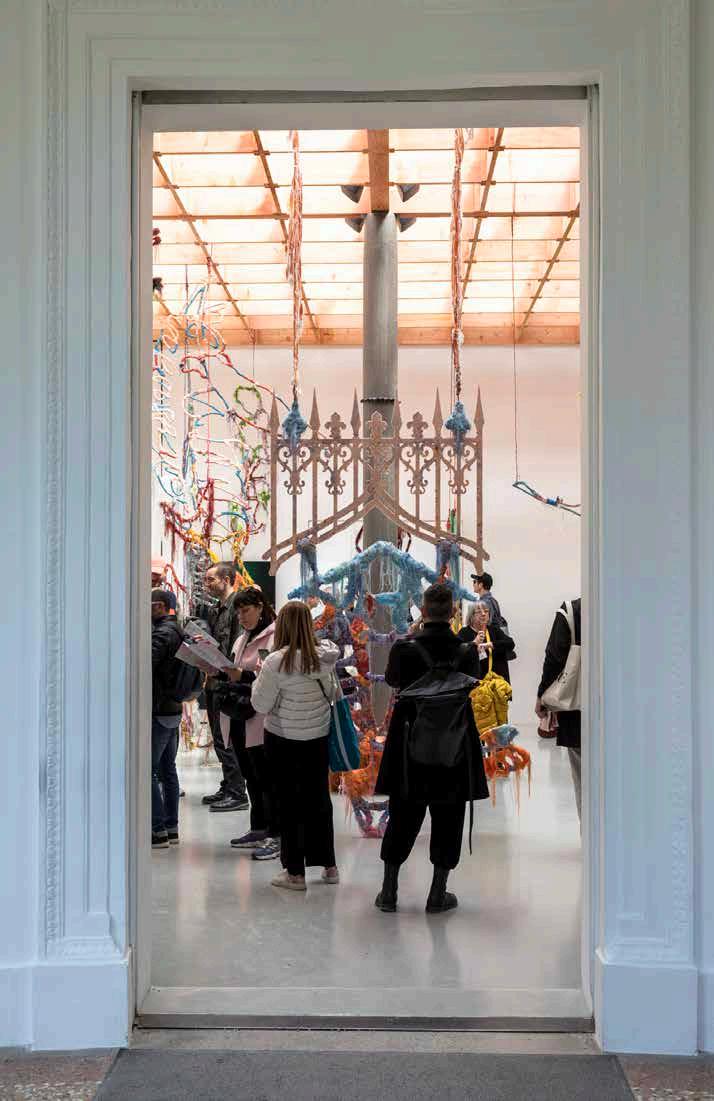

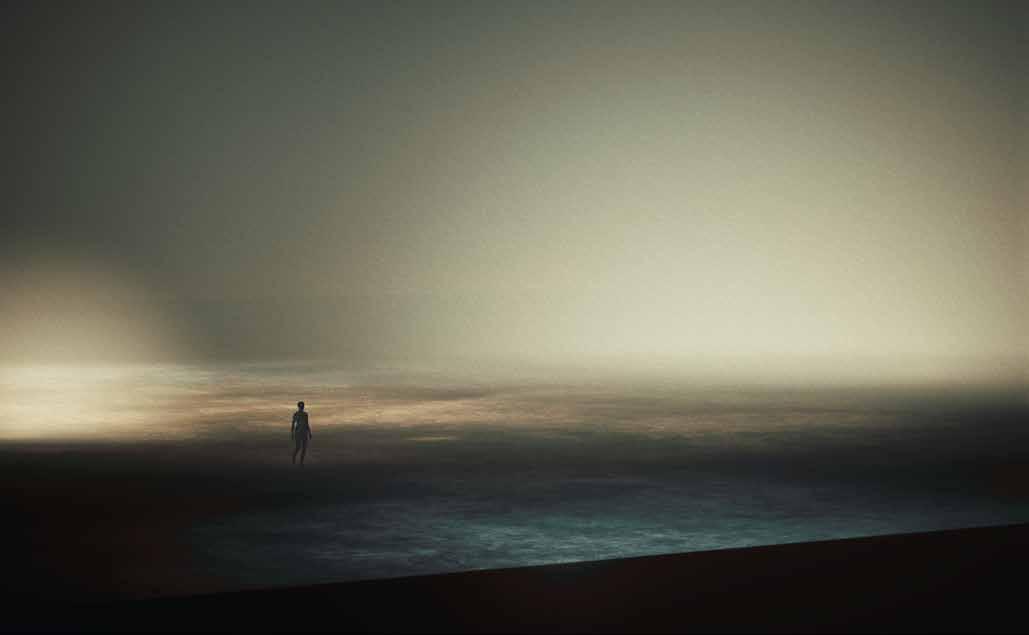
Your creative cruising needn’t come to an end when you reach the Biennale’s exit gate, with a number of independently organised collateral events that set up shop in the city’s churches, empty spaces and permanent galleries for the duration of the festival. One of the most spectacular extra-curricular shows this year takes place at the Pinault Foundation’s Punta Della Dogana, where French artist Pierre Huyghe presents his major new exhibition Liminal In a series of gloomy rooms, Pierre stages a number of uncanny interventions – an aquarium where hermit crabs use replicas of modernist sculptures as their shells; AIgenerated stage lights and smoke machines who ‘perform’ to an eerie soundtrack; or a video of a monkey hanging-out in Fukushima’s longabandoned spaces while wearing an uncanny mask of a human girl.
At Fondazione Prada, Christoph Büchel’s controversial show sees the 18th-century palazzo transformed into a bankrupt pawn shop to interrogate how debt is used as a lever of control and exploitation. For this, the artist has created a new cryptocurrency called Schei, which is promoted by a fake TikTok influencer, with profits sought to be redistributed among Venice’s permanent residents. Don’t miss Portraits of Life and Death, a series of blackand-white photographs which contrast the mummified bodies of the catacombs with portraits of his peers from New York’s downtown scene during the ’70s and ’80s.
Guglielmo Castelli’s show Improving Songs for Anxious Children brings together painting, textiles and sculpture that dance between innocence and violence. Over on the island of San Giorgio, Berlinde De Bruyckere’s faceless angels (made from unconventional materials like wax, animal skins, and hair), are scattered across the abbey of San Giorgio Maggiore in a striking reflection on
mortality, transcendence and devotion.
Finally, one of the most poignant shows of this year’s Biennale is hosted by Giudecca’s women’s prison on behalf of the Vatican pavilion and is full of disquieting works made by artists including Maurizio Cattelan, Simone Fattal and Sonia Gomes in collaboration with inmates.
labiennale.org
Clockwise from below: ‘Liminal 4’ by Pierre Huyghe; ‘Of aggression and possession’ by Guglielmo Castelli; Inside the French Pavilion; Compose by Yuko Mohri (Japan); Rise of the Sunken Sun by Inuuteq Storch (Denmark); Kith and Kin by Australia’s Archie Moore



At Baker Brothers, our Summer of Colour campaign is championing the bold and beautiful colours of our natural world, featuring a stunning range of rings, necklaces, earrings and more, to truly offer something for everyone. In a world where trends often take centre stage, it’s crucial to embrace our uniqueness and wear outfits that authentically represent who we are. And, when it comes to standing out, we feel there’s no better way than by adorning yourself with jewellery that mirrors your own expression.
Diving into the world of coloured gemstones may seem daunting – but fear not! Buying from Baker Brothers guarantees you a wealth of experience, knowledge and trust. Our jewellery specialists guide you through every detail, ensuring you find the perfect gemstone tailored to your preferences. Our expertise extends beyond diamonds to include an extensive range of coloured gemstones, making us true gemstone specialists. Our commitment to excellence is evident in the meticulous
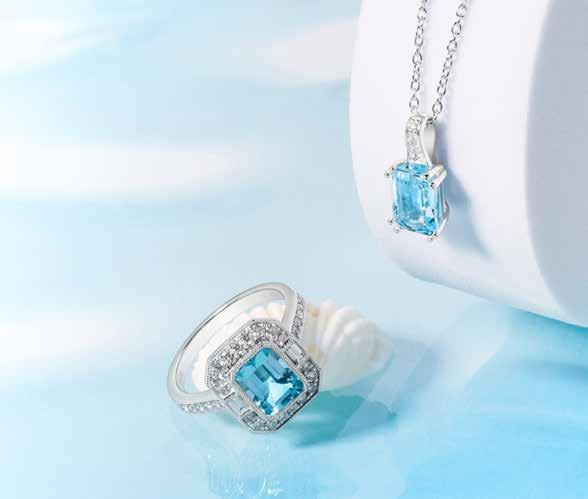
The Baker Brothers release the Summer of Colour Collection: a celebration of bold and beautiful gemstones
process we employ to handpick each gemstone, ensuring that every piece meets our exacting standards. Just as we are renowned for our diamond selection, we apply the same rigorous criteria to our coloured gemstones.
Whether it’s a vivid emerald, a fiery ruby or a delicate aquamarine, our specialists select gemstones that exhibit exceptional beauty and quality. This dedication to sourcing only the finest stones allows us to offer a diverse and captivating collection that showcases the natural splendour of these treasures. Our passion for gemstones is reflected in the expertise and care we bring to each piece, ensuring that our clients receive only the best. At Baker Brothers, we understand that a gemstone is not merely an accessory but a statement of individuality and personal style, and we take pride in helping our customers find the perfect stone to express their unique essence.
Our ability to work with any colour, shape or type of gemstone sets us apart in the jewellery industry. At Baker Brothers, we embrace the
challenge of crafting custom pieces that feature an array of gemstones, from the traditional to the rare and exotic. Whether you desire a vibrant sapphire in a classic round cut, a striking amethyst in a contemporary square shape or a bespoke design featuring a combination of different stones, our skilled artisans can bring your vision to life.
We believe that every gemstone has its own story and character, and we strive to highlight these unique qualities in our designs. Our versatility and creativity enable us to cater to a wide range of tastes and preferences, ensuring that every piece we create is as distinctive as the person who wears it. By offering a comprehensive selection of gemstones and a commitment to personalised service, Baker Brothers ensures that each client’s jewellery journey is as enchanting and rewarding as the gemstones themselves.
Contact Baker Brothers via their website bakerbrothersdiamonds.com or phone 01234 630821

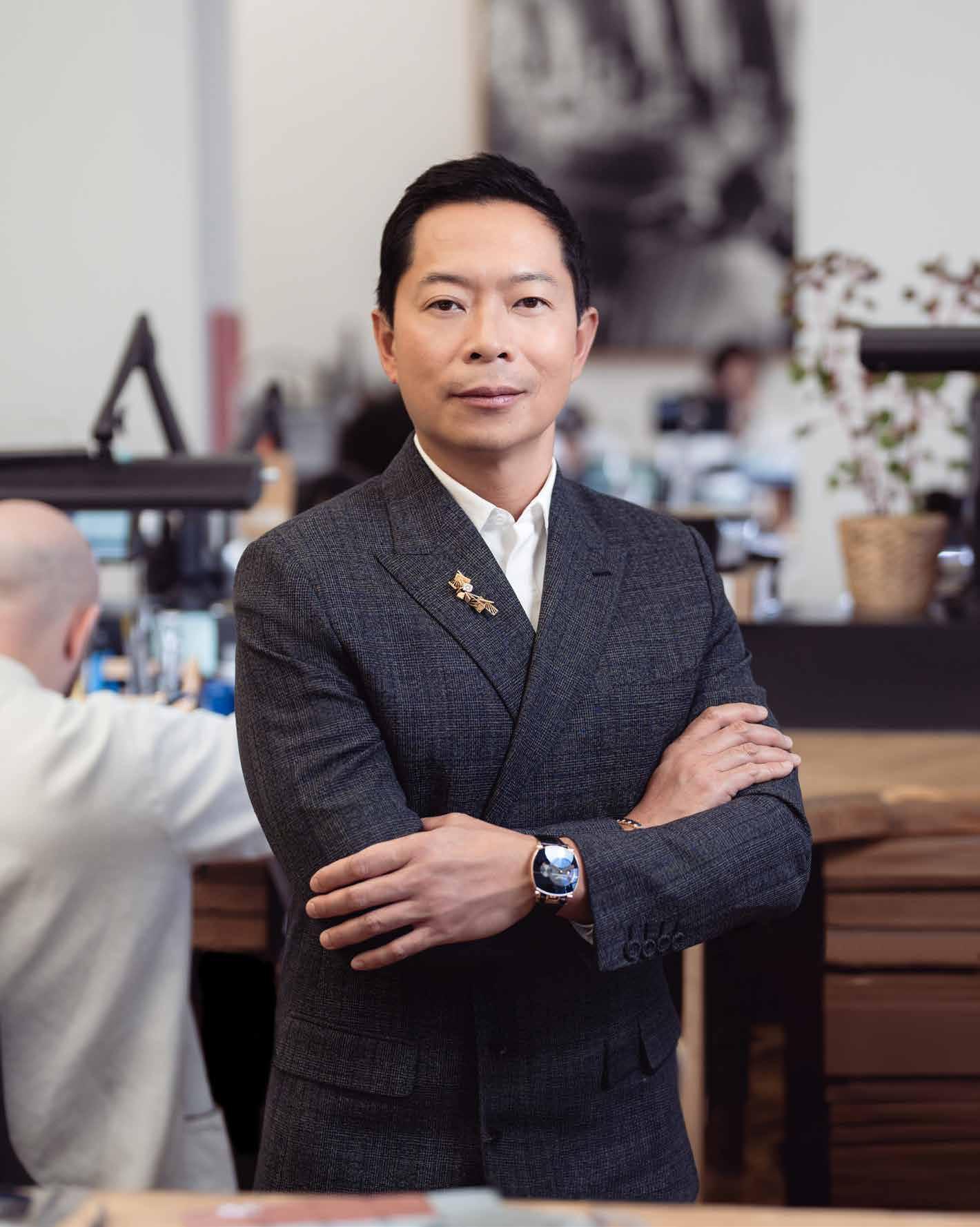
Charles Leung, CEO of haute jewellery brand Chaumet, shares his fine jewellery philosophy and the importance of breaking tradition
Words: Shivani Dubey
When Hong Kong native Charles Leung took over as the CEO of luxury jewellery house Fred in 2018, he became the first Asian CEO of an LVMH brand, leveraging his extensive knowledge of the Asian and EMEA markets to take the company to new heights. Now, he has taken the helm of Chaumet, one of the world’s oldest and most prestigious jewellery brands, with a history entwined and inspired by 18thcentury French Empress Josephine. Charles has already made waves since his appointment in March, with exciting launches including Chaumet becoming the first jeweller to design the Olympic medals. As such, each medal given to Olympic and
Paralympic champions at the 2024 Paris Games will contain a piece of the Eiffel Tower – making an already prestigious honour even more coveted for the Olympians who will receive them.
Catching up with Charles at the brand’s New Bond Street boutique in London, he reveals that his Asian roots and passion for jewellery storytelling – inspired by his early beginnings at Cartier, 12 years at Chaumet, and success at Fred – are his inspirations for Chaumet’s next chapter.
Here, Charles shares how he plans to take Chaumet to new heights, the significance of his appointment, and why his role as an Olympic torchbearer is such an honour. »
Charles, how have your first few months been at the helm of Chaumet?
Very busy, very exciting and strangely familiar. I’m so glad that, during the past five years, a lot of things have progressed really well at Chaumet. This makes it the perfect time for me to start to turn the page for the brand – so it’s very exciting.
You worked for Chaumet previously; has your existing knowledge of the brand helped in your new role?
Very much. Because I started [at Chaumet] in Hong Kong and Asia Pacific – opening in markets like China and then working in South Korea, Hong Kong, Taiwan – it gave me a lot of insight on how we started and what we have been through. I think what I understand very well is how my team, my colleagues and my clients interact – the way they think about the brand and the possible opportunities for the future. And this is not an easy brand to start with. There is a lot to learn to understand why Chaumet is what it is today. So, I have shortened this learning period. I can come here, get a quick brush up, and go into the new season.
What appeals to you about working with such a legacy brand?
It’s a huge honour and a huge responsibility. I still remember the last time I worked for Chaumet in Paris; arriving there and passing through the staircase and, as a Hong Kong native, I couldn’t help but feel the weight of the situation. There’s a lot of pride inside as well. But at the same time, I always ask myself: am I up to the challenge? Because it is easy to judge or challenge a person not of French origin. There are questions like: ‘What do you know about a heritage brand such as this one? Can you understand it well enough to guide the brand to the next chapter?’ I have to always make sure that I’m on top of the job, to show that you can be a non-French person and still do a very good job for a French company.
Chaumet famously has links to Empress Josephine. Can we expect to see these references continue into the future?
I think it is difficult to erase this glorious part of Chaumet because it’s how everything started — for our style, our positioning and our relevance in French history. It is important to
remember that Empress Josephine was a very modern, contemporary fashion icon. She was unexpected, and whatever she did was widely copied everywhere in Europe. I don’t think it is wise to redo 18th-century jewellery for a 21st-century customer, but the same spirit of joy has to be there – meaning that we need to be royal but, at the same time, be fun, relevant, trendsetting and lead the way. That is how you retain the essence of Josephine.
You have mentioned that you like to tell a story with jewellery. Could you elaborate on this?
A piece of jewellery for anyone is a part of their life story. Be it a ring or a necklace — you will know the situation, location and the person who gave it to you. Jewellery from Chaumet is highly symbolic and meaningful in design. And it can tell a lot about the link between two people. Our jewellery is really about crowning the person you love most with the deepest sentiment. And when we tell a story with our collections, we become part of the customer’s story as well.
How do you balance this love of the past with the demands of the modern day?
For the past 10 years we have been trying to retell the story of Chaumet because it is the base of everything. Now, I think it is about time that we move on. We cannot just keep looking back. I hope that in my time here, I make sure that the house is on the right track to deliver this transition. The past is in the past. It is the masterpieces that we’re creating today that will be tomorrow’s classics.
Chaumet is creating medals for the Paris Olympic Games. Could you tell us more? I can’t talk too much about the medals – except that we are very proud to have designed them. What I can tell you is that I will be running with the torch for the Olympic Games to pass the baton. I am extremely excited and my family is overjoyed. I told the chairman of the preparation committee that it means a lot to my Asian-origin colleagues around the world that they see an Asian face — an Asian CEO — running with the torch and passing the baton.
When you joined Fred, you made history as the first Asian CEO of an LVMH brand.
Was that a significant moment for you? Definitely. Nobody would have thought that it could happen to an Asian person. This was not something I had planned 20, 15 or even five years ago. When I found out about this opportunity, I decided to apply and see what happens. But it is also a lot of pressure. It was tricky in the beginning, and then Covid-19 happened, but we came out okay. We’re one of the fastest growing jewellery brands in the world, so it all worked out.
Are there differences in consumer trends between the Asian and European markets?
I think European customers are buying pieces that they can wear a lot. It becomes part of them and they mix and match with a lot of different things. Meanwhile, for Asians, [jewellery is] precious. We like to be very careful. I think it’s a very different way of looking at jewellery. Europeans are more about making it part of their living, whereas for Asians it is still like a ceremony.
As a consumer, it seems that one of the biggest questions jewellery houses are tackling is ethical sourcing. How do you approach this?
I think that we have the responsibility to make

THE PAST IS IN THE PAST. IT IS THE MASTERPIECES THAT WE’RE CREATING TODAY THAT WILL BE TOMORROW’S CLASSICS




We join racing legend
Jacky Ickx at the Mille Miglia, to discover the enduring magic of Italy’s finest classic car rally
Words: Rory FH Smith
It’s 4.15pm on Tuesday and the sun is beating down on Bergamo’s Piazza San Marco. The bells of a nearby church chime briefly as another 15 minutes slips by – not that we need reminding. I watch anxiously as the seconds tick by on the Chopard Mille Miglia strapped to my wrist.
I’m currently two hours into ‘the most beautiful race in the world,’ but my plucky 1954 Fiat Zagato 1100 isn’t feeling too well, jackedup with a team of oily-fingered mechanics under it. While they’re doing their best to get my teammate and me back on the road, our chances of making it to the checkpoint in time are looking slim.
With roots dating back to 1927, the Mille Miglia – meaning 1,000 miles – is a race like no other. Back in its heyday, manufacturers, teams and drivers would flock from all over the world to take on the marathon distance, run on open, public roads in whatever machines they could muster. The race was a test of not only a car’s reliability but also a driver’s stamina – something that the late Sir Stirling Moss mastered after setting the record in 1955 behind the wheel of his Mercedes 300 SLR, alongside co-driver Dennis Jenkinson.
The pair completed the 993 miles from Brescia to Rome and back in just over 10 hours, with an average speed of 98mph. »

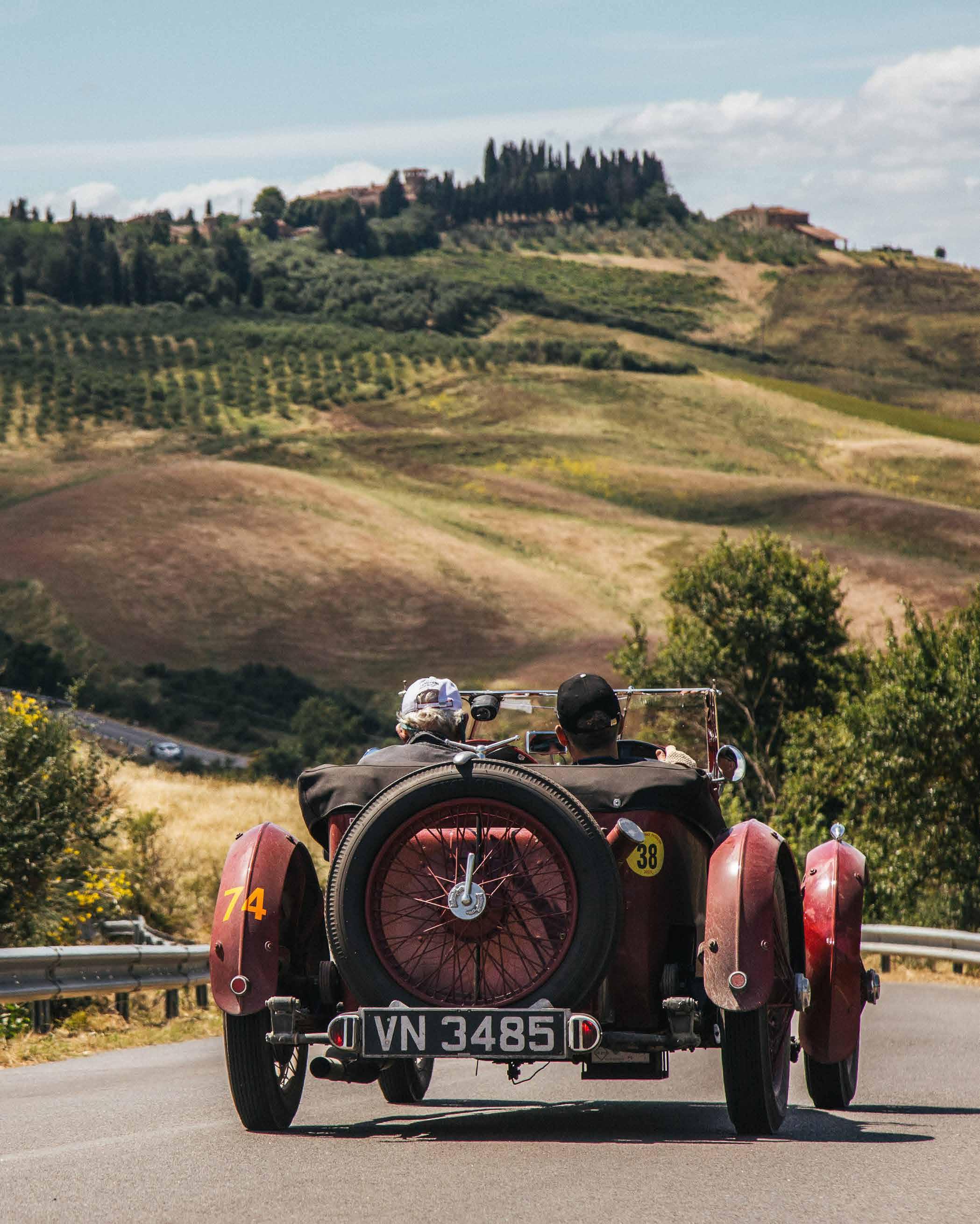
“Imagine having an early breakfast and leaving London by car at about 7.15am, reaching Aberdeen by lunchtime, and getting back to London in time for a latish tea – with only two stops,” wrote Autocar magazine at the time, reflecting on this remarkable achievement. Even by today’s standards, and with a modern machine, running a car at those speeds for that amount of time on open and often unpaved roads is simply unimaginable.
Today, however, it’s fair to say the Mille Miglia is a statelier affair. The event ran as a flat-out race against the clock from 1927 until 1957, when it came to a tragic end after Ferrari driver Alfonso de Portago and his navigator died when they crashed into spectators, killing nine and injuring many more. With on-road, wheel-to-wheel racing deemed too dangerous by the Italian authorities, the spectacle was eventually revived in 1977 as a regularity rally – a type of automobile race in which drivers are tested on how well they can meet average time and speed requirements, in compliance with local laws, over sections of a course. Today, the Mille Miglia is more about precision and timekeeping than outright pace – something that’s front and centre of my mind as I impatiently sip another espresso while the mechanics work their magic.
Miraculously, we’re back on the road within one hour, 13 minutes and 24 seconds –according to the Chopard, which I’ve been lent for the duration of the event. For 37 years, the luxury watch and jewellery brand has served as the official timekeeper and world sponsor of the Mille Miglia. It is the longest-running relationship between a watchmaker and a motoring event and, each year, the family-owned company has issued a commemorative piece to celebrate the ‘most beautiful race in the world’.
This year is no exception, with Chopard launching a new Mille Miglia Classic Chronograph – a 40.5mm chronograph featuring a ‘La Gara’ (or ‘competition’) dial inspired by motor racing’s chequered flag, amd topped by a raised glass box. Alongside it sits the Mille Miglia GTS Chrono, which is limited to 100 examples and features a 44mm case made from lightweight, bead-blasted titanium. Here to launch the watches and take part in a beautiful ‘strawberry-metallic’ Mercedes 300SL ‘gullwing’ is the company’s co-president Karl-Friedrich Scheufele, joined by Belgian racing legend Jacky Ickx. The pair have taken part in the challenge together since they first met in the late 1980s.
“Something like this would only ever be possible in Italy – it’s just spectacular, you’re going to love it,” Jacky assured me earlier that day, moments before climbing into the Mercedes through its iconic gullwing doors. »

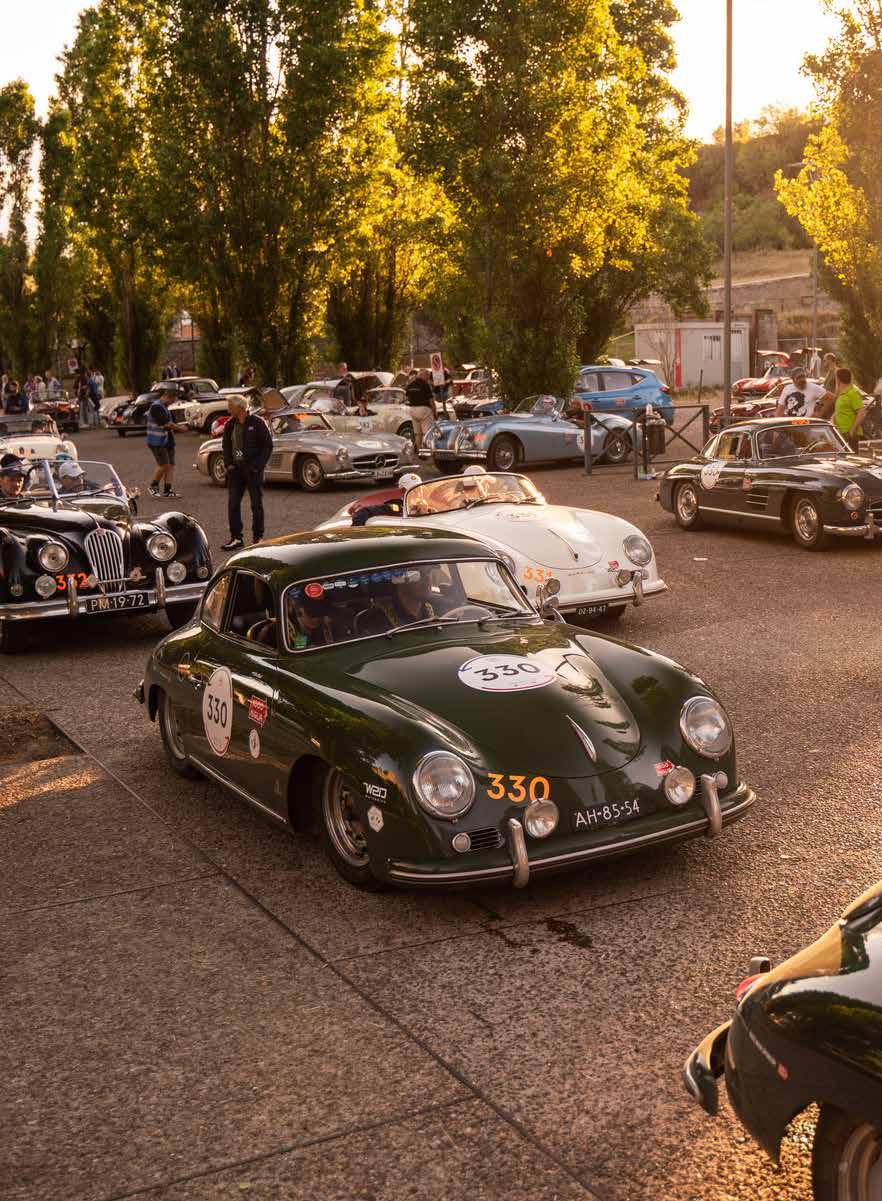

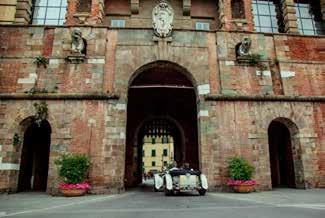


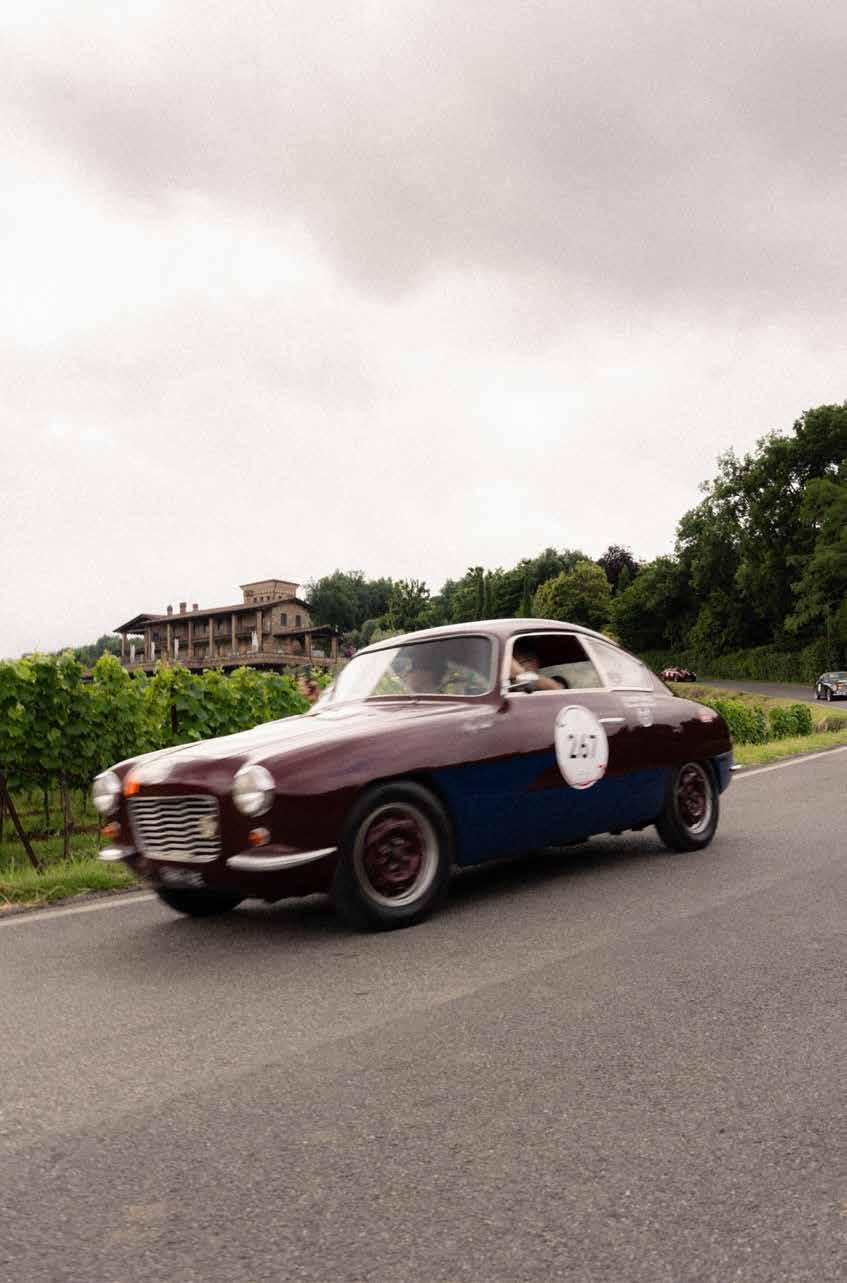
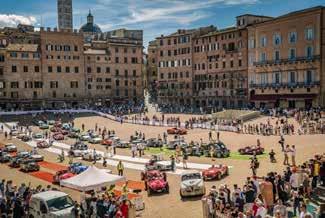

SOMETHING LIKE THIS WOULD ONLY EVER BE POSSIBLE IN ITALY – IT’S JUST SPECTACULAR
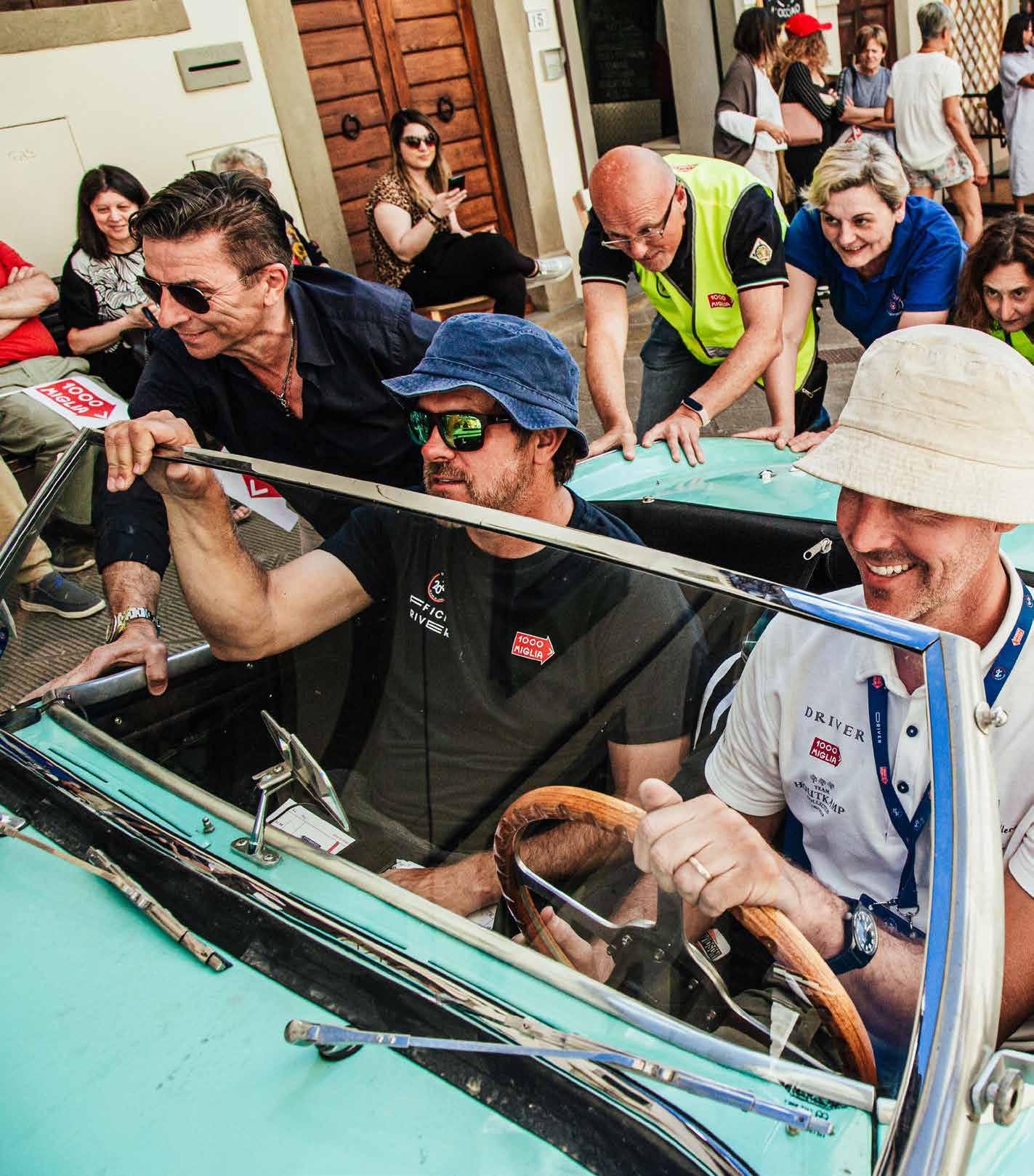

Now, with a new prop shaft support bolted on, our little Zagato-bodied Fiat is singling along the twisty, country roads that link Bergamo to Milan. It’s a fraction of the size of modern machines, or even many of the Ferraris, Mercedes and Aston Martins taking part; each elegantly gliding past, still looking like they’ve landed from another planet. But our 70-year-old car steadily chips away at the miles, with decades of character present in every crease of its leather and elegant bodywork. While its comically large, wooden steering wheel wouldn’t look out of place on a classic yacht, it’s a delight to drive and its small engine is more than enough to power the lightweight, coachbuilt Fiat along Italy’s beautiful backroads.
Back in the pack, we take a narrow road that carves through the ancient farmsteads and paddy fields around Vercelli before reaching the checkpoint in the town centre to rapturous applause. Through every city, town and village along the Mille Miglia route, people of all ages line the roads, waving flags to cheer on the competitors. Despite it taking place every year, Italy’s enthusiasm for the event is seemingly as strong as it was back in the late 1920s. As Jacky says, there is only one country in the world where nearly 500 classic cars clogging up the roads would ever be applauded.
Still, the fever and festivities that the Mille Miglia brings each year holds a significance far beyond the event. With many of the vehicles between 70 and 100 years old, they represent the golden age of motoring, when cars were celebrated and coveted – a far cry from the commodities most have become today. While many of the cars taking part are hugely valuable, they have an important role to play in inspiring the next generation of classic car enthusiasts. Seeing so many out on the open roads for the Mille Miglia is a special experience — but to be behind the wheel of one is surreal to say the least. With the sun setting just outside of Turin, our classic car adventure is coming to a close. Turin marks the end of the first of the rally’s five legs and the point where I hand over the keys of our friendly-faced Fiat to another enthusiastic competitor. Taking the car on, the Chopard team will continue to weave their way down Italy’s northern coast before cutting through Tuscany and then on to Rome. From there, it’s way back up the middle of the country to where it started in Brescia. For another year, the 500 or so classic cars can then rest, safe in the knowledge that they’ve successfully notched up another 1,000 miles and added to the legendary race’s rich history.
Thankfully, the idea of keeping a classic car boxed up in a secure private collection is anathema to the hundreds of Mille Miglia owner-drivers – and long may it last. While events like Le Mans and the Monaco Grand Prix might have more prominence, there’s nothing in the motoring world that compares to the magic of the Mille Miglia.
chopard.com; 1000miglia.it

Filmmaker Sir Ridley Scott reveals the story behind his family wine estate, Mas des Infermières, and how he is applying the cinematic approach to winemaking
Nestled in the heart of the Luberon nature reserve in southern France, Sir Ridley Scott’s idyllic family wine estate has evolved from a Provençal escape to a viticultural success story. The prolific director purchased Mas des Infermières in 1992 as a holiday home where he could paint, read and relax away from Hollywood – and the industry he has dominated since his second film, Alien, burst into cinemas in 1979.
Since 2019, the estate’s picturesque 11-hectares of verdant grenache and syrah vines, olive trees and truffle oaks have been delivering a range of red, rosé and white wines that each perfectly encapsulates the unique character of the Luberon’s exceptional terroir. Although Ridley admits that, when he first bought Mas des Infermières, he had
no interest in making wine himself.
“I think we all have an intuition,” says Ridley, contemplating what made him take that leap.
“I’ve learned to trust mine – when something clicks, I act on it. The reason I’ve done so many movies is that I don’t pontificate over 40 subjects. My motto is: ‘Just do it – but do it the best you can.’” Ridley, 86, built a team of expert winemakers to help guide the process, installed a state-of-the-art cave, and applied a sustainability plan to protect the biodiversity and health not just of the vines, but the native flora and fauna of the region itself – Mas des Infermières is certified as an HVE (High Environmental Value) and bee-friendly producer.
While winemaking may be a new venture for the director, Ridley is by no means a ‘hands-off’
Words: Michelle Johnson
vintner. His directorial expertise, interest in art and design, and personal love of wine ensures his input remains invaluable to his team. After all, he says, if you’re going to make something a success, “you’ve got to be involved”.
“My experience comes from 50 years of drinking,” he laughs. “[Winemaking] is like making a movie: once you’re in, you’re in deep. Up to your nose in challenges. It’s exactly the same with wine.
“We’re all about quality,” he adds. “The competition is enormous; so many people make wine. But there are so many films now, and I’m still surviving after 40 years. I released Napoleon [in 2023] and I’m delivering Gladiator II in November. So, I just ignore [the competition] and focus on the wine.” »

While it’s tempting to draw parallels between the story of Ridley’s discovery of Mas des Infermières and his 2006 film A Good Year – in which Russell Crowe’s high-flying city investor inherits a Provence château – Ridley’s true motivation was to get back to the land.
“I’m from the north of England. I’m a bit of a farmer,” says Ridley, who was born in South Shields in 1937. “In 1972 I bought myself a small farm in the Cotswolds. We were there for 10 years – I had horses, 60 sheep, 50 ducks... The family gradually lost interest, so I was the only one who wanted to go down on the weekends.
“I sold it in ’82 but I always missed the land. In ’92 I decided I needed to find a farm and to find sunshine.” Ridley was at Cannes Film Festival when his realtor discovered Mas des Infermières. “The house was a gem. I drove 250km [155 miles], walked in and bought it.”
Soon enough, the history of the mas (the Provençal term for a Mediterranean-style farmhouse) was offering its own inspiration. The first official mention of Mas des Infermières was in 1831 – an estate belonging to General Baron Robert, a surgeon (or ‘health officer’) in Napoleon’s army. Just as it would take years for that link to the French Emperor to enter Ridley’s working life, the estate’s lush vineyards would take time to work their magic, too.
“The vineyards, to me, were a garden; I had no interest in making wine,” he admits. Instead, Ridley made a deal with local producers, Cave de Lumières, who soon began winning awards for their wine. Ridley said: “I think I better start paying attention”.
Upon realising the potential of his vines, Ridley burst into action. He built a new, modern cellar; hired a new director, Christophe Barraud, and sales director, Melanie de Rudder; and undertook a complete renovation of the properties on the estate – three of which are now available as luxurious holiday homes. “The evolution has been huge,” he says. “Already, the wine is great.”
The collection itself is perfectly indicative of the terroir: crisp reds, fresh and aromatic whites and fruity, subtly spicy rosés. The vines are elevated to 200m on the cool northern face of the Luberon massif, noted for its marly limestone, sand and red clay. The most exceptional wine in the portfolio is the limited-edition Ombre de Lune, made from the estate’s oldest syrah vines and aged in barrels after an early, moonlit harvest. The Chevalier collection offers powerful and complex reds, rosés and whites, all perfect for fine food pairings. Finally, the Source collection is inspired by an abundance of water that encourages the fruity, fresh notes in the red, rosé and white cuvées.
The wines’ label designs are also created and drawn by Ridley, and inspired by the story of each expression – though despite his artistic skill, he says painting is an area of constant self-improvement.
“I’m a terrible painter,” he says, though his elegant labels and the popularity of his ‘Ridleygram’ storyboards would counter his self-deprecation. “When I’m in France I paint every day. What I’ve discovered is it’s best to have several canvases to work on. You finish a canvas, see it’s not right, come back in a month, and mess it up again. It’s an ongoing cycle – but I’m Sagittarius, and one of the [characteristics] I always took on board was: ‘When it’s finished, you’re never satisfied’.” »
Family legacy: Ridley Scott (previous) at Mas des Infermières (main); The state-ofthe-art wine cellar (below) features props from Ridley’s blockbuster films
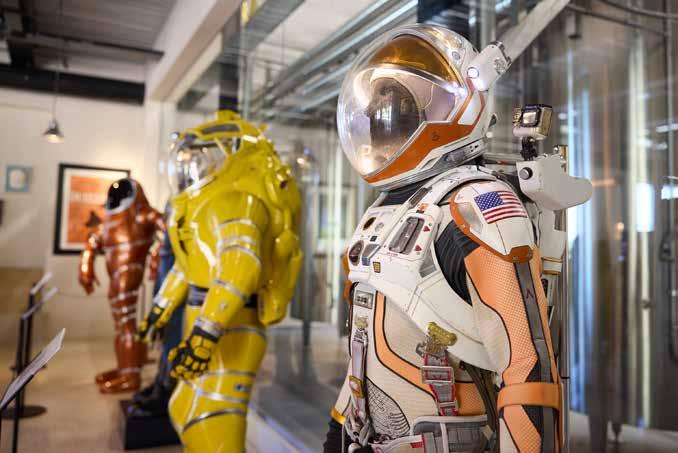
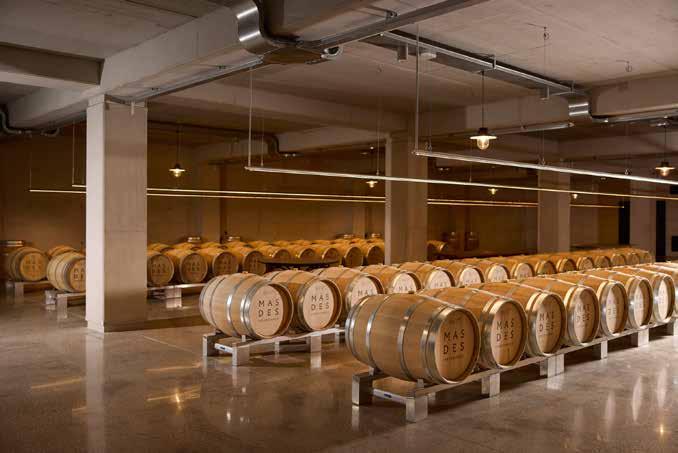


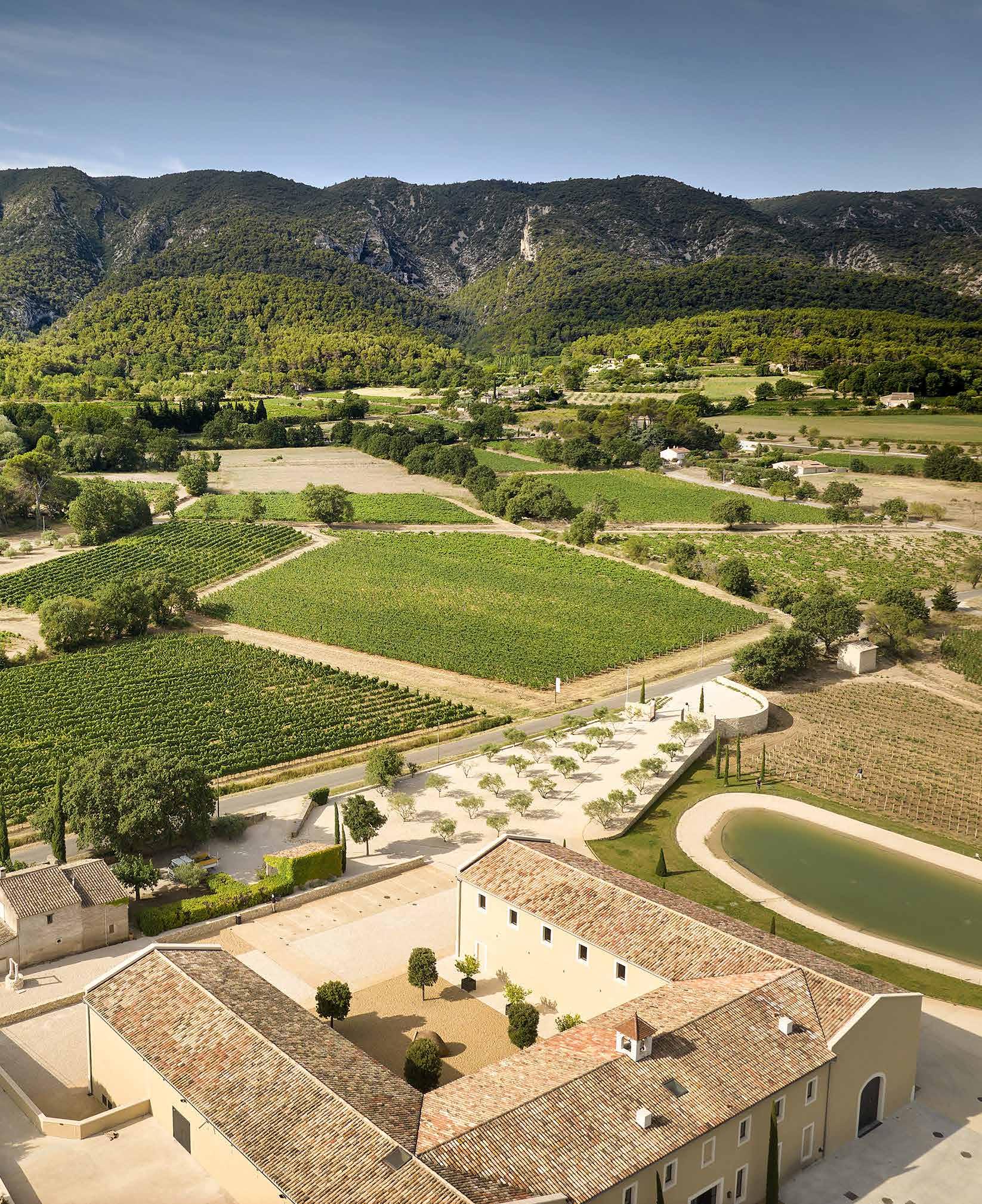
Best known for his impressive feature film portfolio, Ridley began his life in film creating high level commercials for household names including Chanel and Apple.
“I became quite successful pretty quickly, so I could afford to eat at the best places – and that ruined me,” he laughs. “I used to enjoy Alvaro Maccioni’s La Terazza – it was like the gates of heaven opening for Italian food in London. I loved Italian and Sardinian white wines – fresh and young. The wine of the moment in the ’60s was Verdiccio,” he says, taking a moment to sketch the distinctive Coca-Cola-bottle shape of the bottle. “We drank gallons of it.”
Ridley’s oenological education continued when shooting his first feature film, The Duellist (1977), in France. “I was into seriously good French cuisine – we used to go to Chez Flo, a very fashionable banqueting restaurant in the ’70s and ’80s – and I developed a taste for French red wine.”
At Mas des Infermières, guests can see highlights of his work from this era to present day – from the props and costumes adorning the cellar walls to an on-site exhibition of some of his personal collection of memorabilia. But life could have been very different had he not been encouraged to apply for the Royal College of Art.
“I was an academic disaster,” he says. “I was an army brat, in and out of schools, and my report card was terrible. The best thing that ever happened to me was going to art school. But it goes to show, it doesn’t matter if you’re not academically bright, you must go for what you enjoy.”
It’s a sentiment that Ridley has passed down to his children, all of whom are directors of commercials, music videos and feature films. His daughter Jordan recently released her debut movie A Sacrifice (2024) – a gripping psychological thriller starring Eric Bana and Stranger Things’ Sadie Sink – while his son Luke is known for Morgan (2016) and Jake for American Woman (2018). Ridley’s granddaughter Cuba is also making her name as a photographer: “Cuba’s better than any photographer I know,” he says.
“Everyone has talent; it’s a matter of digging it out. I was blessed with a very good eye – I know where to put a camera – so I followed that route,” he says, acknowledging that his competitive nature has honed that further. “I’m not just efficient, I’m very fast. I shot Napoleon in 51 days – normally it would have taken 120 [days]. I finished Gladiator II in 51 days. I’m always in competition with myself – and I love that.”
With Mas des Infermières now available in the UK, I have to ask how his encounters with wine critics have compared to those in the film world.
“Oh, I’m constantly crucified by critics,” Ridley laughs. “My third movie, Blade Runner, was decimated by The New Yorker. It was so bad that I framed [the review] – it’s still in my office today. It reminds me that, just when you think you’ve got it, you don’t know anything.
“That review affected the outcome of the movie, but it recovered and, 20 years later, it’s a classic of science fiction,” he says. “I learned years ago that you can’t listen to criticism. The only critic you can listen to is yourself.”
masdesinfermieres.com
Artistic eye: Ridley Scott’s creative flair is evident in his artwork for Mas des Infermière’s artwork, including cork details (opposite) and bottle labels (below); The director attends the Spanish premiere of his film Napoleon in 2023 (top left)




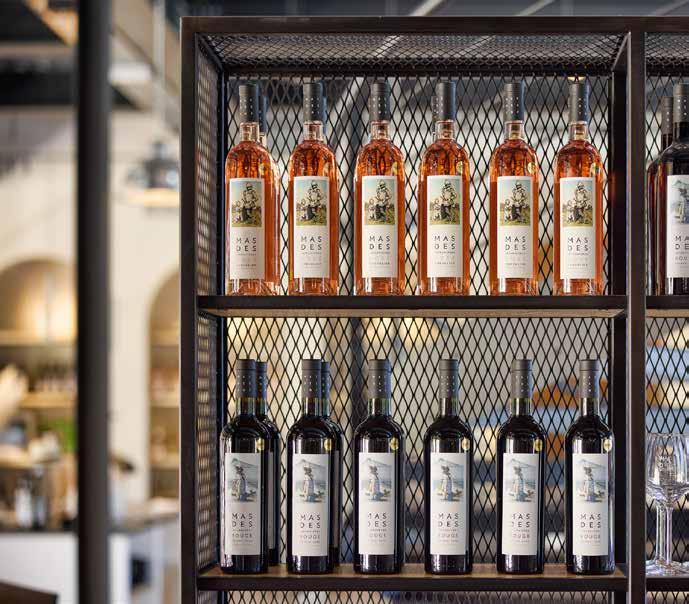




For those seeking cowboys, culture and community, Scottsdale offers a true taste of the New West
Arizona, the Grand Canyon state – known for its warm climate, vast desert, and a patchwork of lush golf courses and highend hotels sprinkled across the landscape – has changed in recent decades from the remnants of the ‘Old West’ to something far more interesting.
I’m visiting Scottsdale, the upscale desert oasis first founded in the 1800s – intended to be called Orangedale before it was named instead for US Army chaplain Winfield Scott.
Agricultural Scottsdale was originally settled by a scant 10 households who, unaccustomed to the sun, recruited Mexican and Native American workers whose influence is evident to this day, particularly in Scottsdale’s Old Town, where Navajo and Hispanic goods are found nestled between the cowboy boots and cactus saltshakers, alongside a rich array of Mexican and Arizonan restaurants.
Chatting to the locals, they’re happy to

acknowledge how young the town – known as America’s most western town – truly is. “Nobody is from here,” says Captain Kirk of JoyRides AZ, a Scottsdale-based private tour company. It becomes a common theme of conversation; finding anyone who’s more than second generation Scottsdale an accepted rarity, but the pride the incomers have in their community is apparent. Scottsdale is all the more loved for being a home of choice rather than chance. »
Up in Fountain Hills, my introduction to Arizona begins at the Adero Scottsdale Resort, an Autograph Collection hotel; a haven of calm and cool, surrounded by epic hikes and the rolling McDowell Mountains. Nestled in this corner of the surprisingly lush Sonoran Desert, the hotel has been built with the landscape in mind, with expansive views of both desert and sky at every turn. The serene hotel offers an abundance of pools, pickleball courts, yoga classes, spa treatments, and other activities – it’s the dedicated stargazing terraces, however, that draw a crowd.
Each week after dark, guests and locals collect around telescopes, impatient for a stargazing session with ‘the Star Dudes’ – local experts and educators. Boasting a community rich with astroenthusiasts and astronomers, Eagle Ridge is even home to ex-NASA employees, drawn to the area by its Dark Sky Community designation. For guests to the hotel, add in complimentary use of the Star Walk night sky app, in-room telescopes, and choice of Dark Sky Corner or Celestial Suites, and this spot in Scottsdale is undoubtedly a stellar destination for visiting astro-tourists.
With even Beyoncé getting on the country music wagon, a trip to this western state wouldn’t be complete without a taste of cowboy country, and Scottsdale offers it in spades. From the bona fide draw of the Old Town’s Rusty Spur saloon bar to the riding and hiking trails of the National Park, live country music, cowboy boots, stetsons, rodeo and mutton bustin’ abound.
At Scottsdale’s very own Cowboy College, subject of its own US TV series, childhood imaginings of the wild west come to life. Looking every inch the consummate cowboy – from shiny belt buckle and spurs to statement stetson – owner Rocco talks us through working with animals. An appropriately serious safety briefing ensues, as we’re instructed that horses only spook when humans overlook the basics. Slightly unnerved, we’re reminded not to be anxious as the animals can sense it, and take deep, meditative breaths as we’re packed off to prep our new steeds.
Once groomed and mounted, we’re taught the basics of western riding. A far cry from the typical decorum of a British riding school, we’re let loose in jeans with reins in one hand, to master the art of directing our mounts.
“Imagine it’s like a video game,” we’re told, and with the idea of a joystick in mind we’re adeptly weaving our rides in and out of cones in no time, racing each other — and the clock.
This crash course comes in handy a few days later as we meet on Scottsdale’s fringes for a sunset hack in the McDowell Sonoran Preserve with Windwalker Expeditions. Exploring the remote desert on horseback, dramatic gullies dip and rise as we try to keep our ponies in check. My steed attempts to have a quick snack on the surprisingly abundant vegetation as I navigate the changing terrain, from sand to rock, down and up and down again. A breeze beckons and a sense of peace and solitude falls as we ride deeper into the desert, entranced by the changing light and landscape. Seeing it first-hand in the shimmering dusk, you can understand why so many have been caught by the desert and its charms, despite the very real challenges a life here can offer.
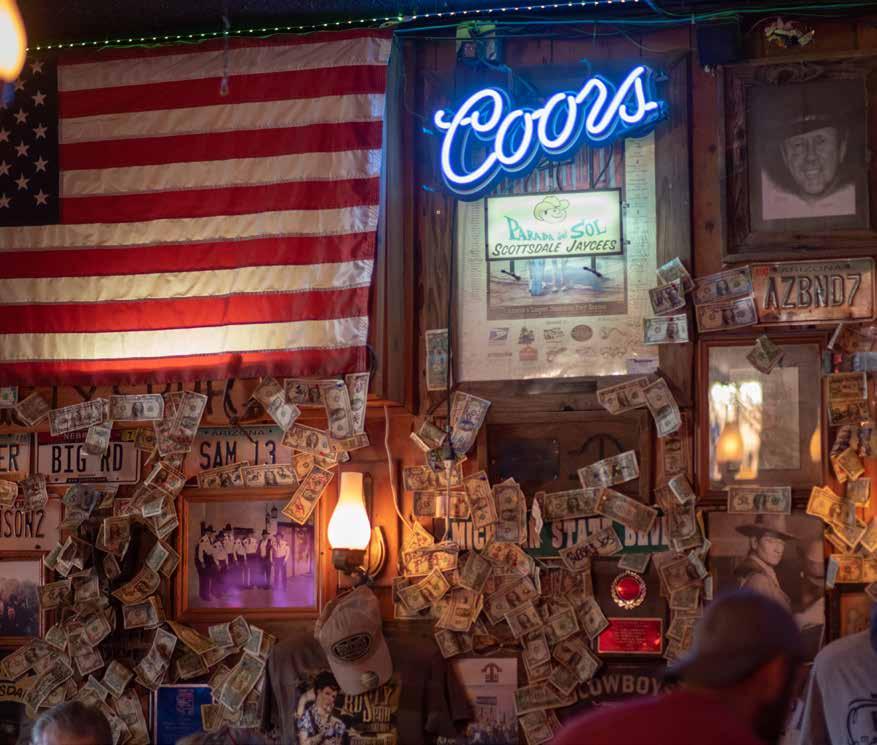

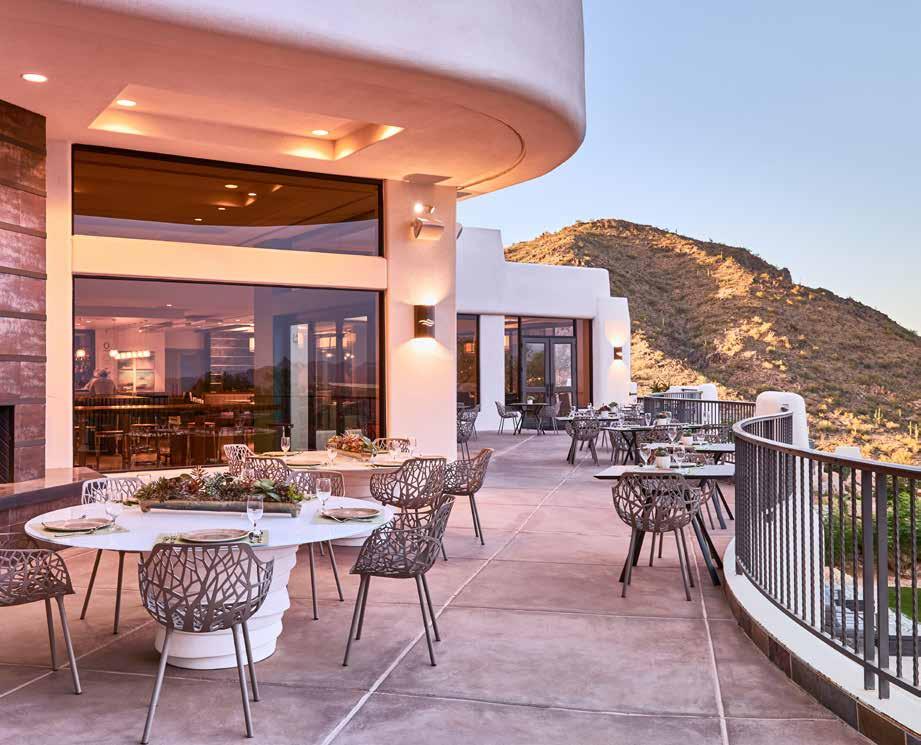

One such visionary called by the allure of the desert was Frank Lloyd Wright, one of North America’s preeminent architects. It was here he built his winter home, Taliesin West, now a Unesco Heritage Site and essential excursion when in Scottsdale. A working example of Wright’s core tenet of organic architecture, it’s a monument to desert living. Every desert rock, canvas, and water feature is positioned with the elements in mind, from a carefully placed pond designed to soothe the stifling breeze, to a passageway shaped to funnel air through, and openings positioned to provide horizontal light, shading the glare of the desert sun.
In Scottsdale’s Paradise Valley another historic building beckons – the Hermosa Inn, once the 1930s abode of painter Lon Megargee. Famed as “Arizona’s first cowboy artist”, his desert hideaway is now a sophisticated and intimate boutique hotel, combining historic charm with luxurious furnishings, original artworks by Lon adorning the walls.
Characterised by its 43 spacious casitas, I follow a path through the leafy grounds to Lon’s restaurant and the adjacent Lon’s Last Drop bar. Making the most of the balmy Arizonan evenings, both embrace the outdoors, with a picturesque, lantern-strewn terrace for dining, and multiple fireplaces perfectly placed for a postprandial digestif.
Despite eating well throughout my visit, Lon’s reputation as one of Scottsdale’s leading dining destinations is undisputedly well-earned. The Last Drop’s accomplished team are delighted to recommend Scottsdale-based brands and spirits, alongside those from further afield.
On the final evening, sitting beneath the original Last Drop painting which – found embellishing every Stetson silk – takes pride of place in the bar, I reflect on my week-long whirlwind. Scottsdale has surprised me. From its Museum of the West, and the boutiques and bars of the Old Town, to delicious dining and lofty hikes and hacks, it’s a tapestry of the diverse communities that shape it. Drawn by the landscape, the climate and the spirit of its untameable desert.
experiencescottsdale.com

Could Halo Space redefine space tourism with its new Aurora capsule experience?
We talk to the creators to find out more
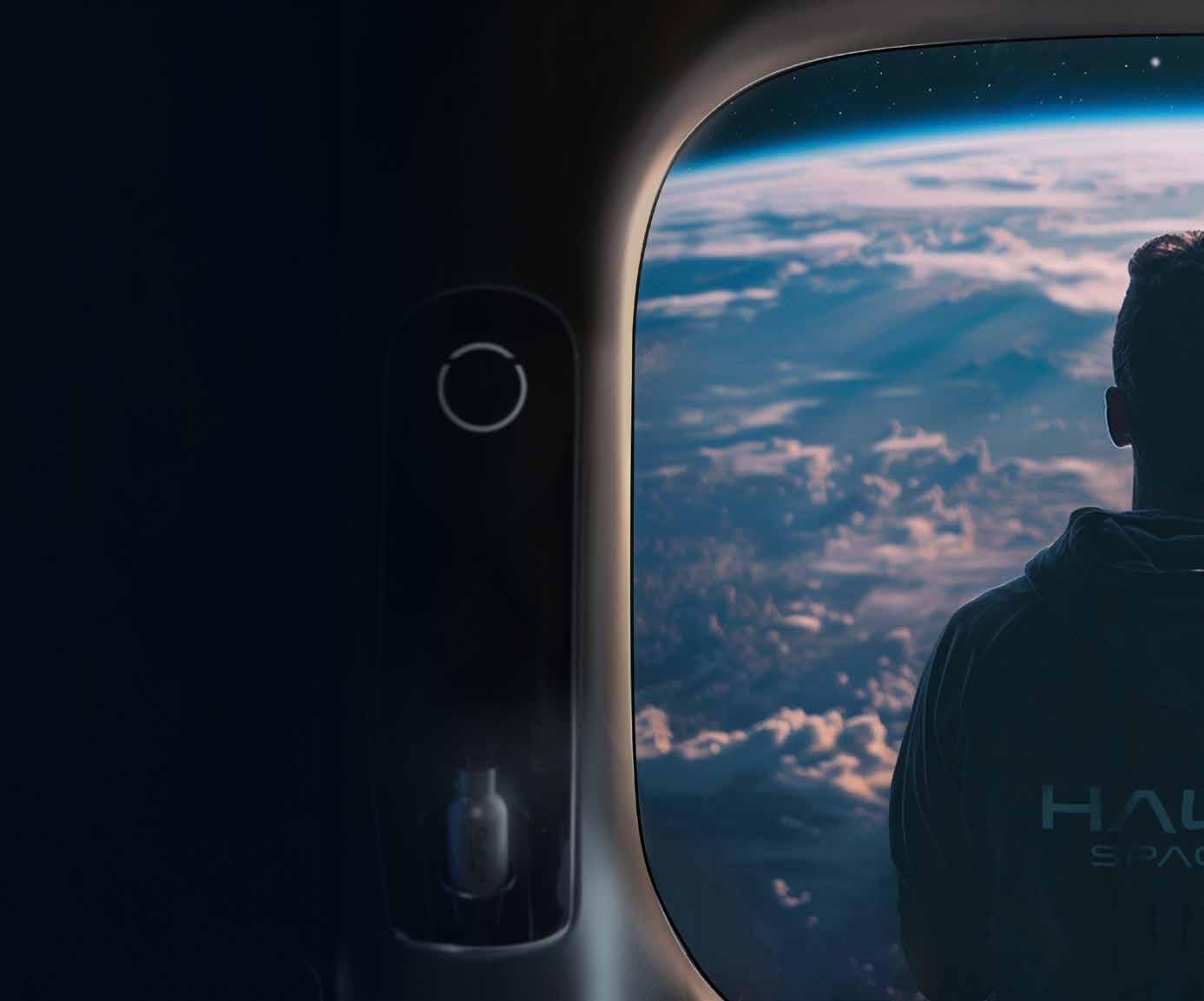
Selecting a gift for someone who has everything can be tricky, but pinpointing where to travel with the person who’s been everywhere? An impossible task. Until space became an option, that is. In 2025 your holiday plans could go stratospheric thanks to the recent launch of the Aurora space capsule, designed as a once-ina-lifetime experience to obliterate your bucket-list and transform your view of the world – literally.
It’s the vision of Halo Space, a global ‘near space’ tourism company, brought to fruition by designer Frank Stephenson and his award-winning team. The first zero-emission commercial flights will liftoff in 2026 (bookable next year), soaring up to 40km high into ‘near’ space where you can see
first-hand what astronauts call the Overview Effect (the curvature of the planet Earth).
“Passengers will spend up to six hours inside our spaceship,” says Carlos Mira, CEO of Halo Space. “You’ll watch the curvature of our planet Earth from the deepness and darkness of space. Between the years 1961 and 2024 only 650 human beings have done this. Our goal is to take 10,000 passengers stratospheric by 2030.”
Halo follows in the footsteps (or giant leaps) of billionaire-founded companies such as Virgin Galactic (Sir Richard Branson), Blue Origin (Jeff Bezos) and SpaceX (Elon musk), who have dominated the Space-travel-for-fun arena so far, promising coveted suborbital flights that allow
civilians to experience space travel – albeit with an eye-watering price tag.
In September 2021, for example, the first ever allcivilian spaceflight, operated by SpaceX lifted off from Cape Canaveral with the four seats costing $200m (£157m). By contrast, you can enjoy The Aurora flight, and days either side spent in the lap of luxury, for a slightly less stratospheric $164,000 (£129,000) a seat.
“We’re breaking new ground in space innovation – it’s as exciting as it gets,” says designer Frank Stephenson. “We’ve made a capsule that’s desirable and emotional but performs to very high engineering standards. It’s still quite an expensive experience, but it’s for people out to achieve the maximum in life.” »
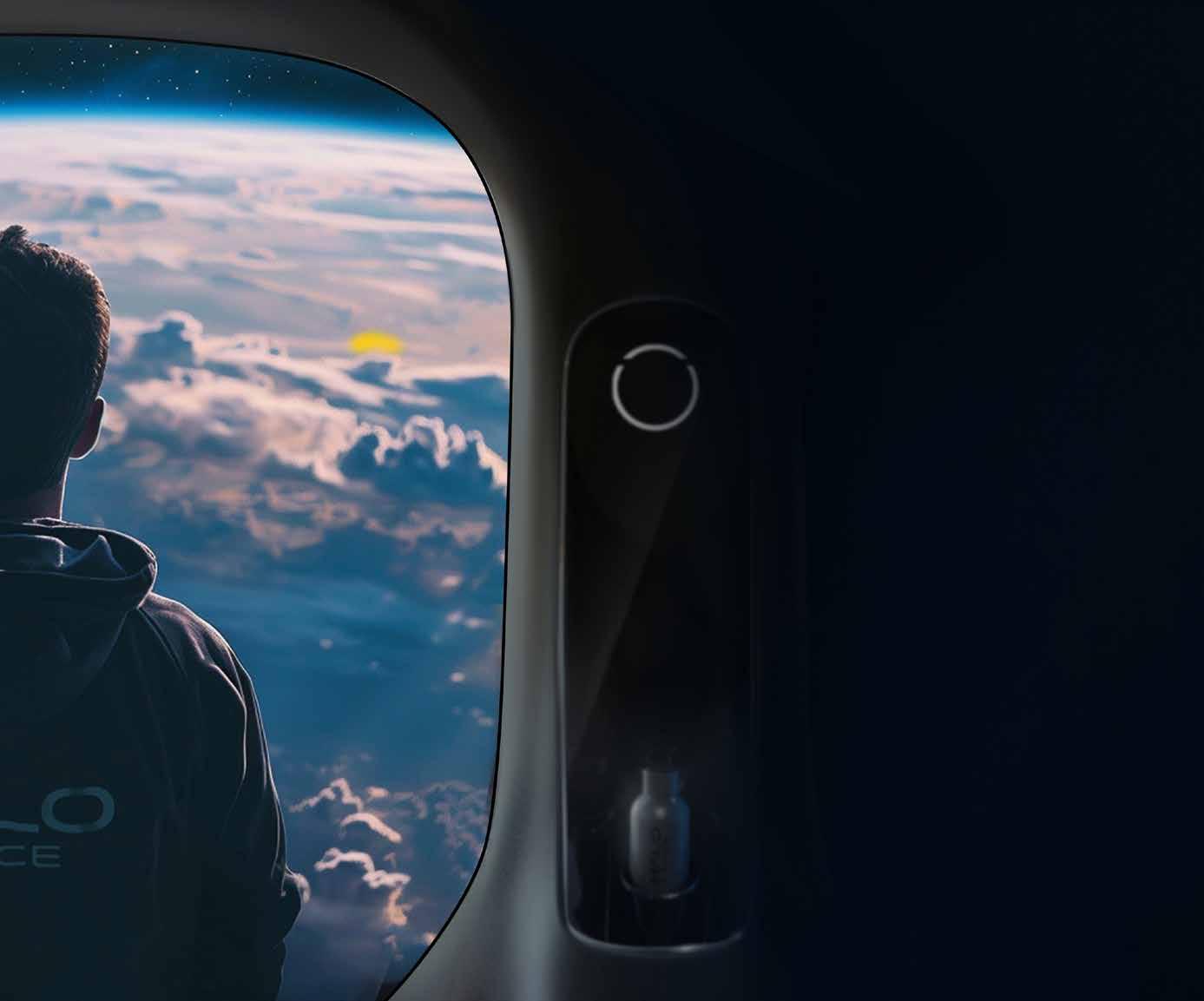
The experience starts at the point of booking with every part tailor-made and, typically, six days long. Expect luxury accommodation, restaurant-standard cuisine, and local itineraries to include anything from cultural highlights to extreme sports and spa treatments, with the changing needs of families, couples and solo travellers considered. A ‘get to know you’ questionnaire will help match up travel companions.
“Something so profound and transformative cannot be the same for everyone,” says Carlos. “That’s why we launched the Halo Pioneers Programme, working with future passengers to co-create their individual experience.”
The Aurora capsule will take off from, and land back in, four specifically chosen host countries: North America, Saudi Arabia, Australia and Spain – in the future you’ll be able to take off from Saudi and land in Spain. Halo performed their first test flight in December 2022 over California’s Mojave Desert.
“Each flagship launch site has vast, unobstructed land with favourable meteorological conditions,” says Carlos. “Accommodation will reflect the local culture and environment. While for our passengers, an adventurous spirit will likely be a common thread.”
With desert landscapes in mind, luxury glamping will be offered that blends rustic elements with all the desired five-star amenities and comforts.
“We aim to offer accommodation with comfort on par to a premium hotel,” says Carlos. “Each guest will have a private suite with sleeping quarters, bathroom, air conditioning, wifi and a stargazing deck. There will be zones for guided stretching, meditation and relaxation. We want to fuse adventure with a transcendental atmosphere
to prepare our guests for their extraordinary journey ahead.”
Once passengers arrive in the host country, they’ll be allocated a local coordinator to be at their service ensuring a worry-free stay. The flight experience starts with a 2am wake-up call, and the capsule will start its ascent between 3am to 4am so passengers can experience sunrise.
“We believe the highlight of the flight will be seeing the sunrise above the edge of our planet from space,” says Carlos.
Passengers will be shown into the capsule before take-off to meet the other passengers and see the trajectory of the flight, simulated beforehand based on the correct wind speed and altitudes, with a precision of 95%.
“Our goal is for passengers to feel a balance of adrenaline from the unique experience they are about to embark on, coupled with a profound sense of tranquillity regarding their safety,” adds Carlos. “One without the other is insufficient.”
Inside the capsule, the design team has taken more inspiration from first-class cabins in aeroplanes than sci-fi films.
“We have a simple, modern, enduring look – it’s not too futuristic, but it is beautiful and most importantly within target weight,” says Frank. “You’re going to really enjoy 6-8 hours in space on an up-and-down route, feeling comfortable, informed and entertained. It’s perfect for people who would fly first-class on an aeroplane.”
Everyone will get front row seats on The Overview Effect, but for take-off and landing passengers need to be facing inwards as per safety regulations.
“Nobody gets cheated out of the spectacular view, so the seats can rotate,” adds Frank. “The windows are as big as we can possibly make them – glass weighs a great deal – to maximise that experience.”

Forget sachets of dusty space food here. Menus will be curated for in-flight dining to suit guests’ individual tastes and dietary requirements with the help of a dedicated experience adviser.
“We aim to awaken all five senses, with taste being one of the most important,” says Carlos. “We cannot offer infinite options, but we will consider local ingredients and work with renowned chefs from each host country. It’s bespoke for each flight.”
The early launch time and duration of the flight is also considered when creating menus. “While ‘champagne and caviar’ might seem obvious for such an exclusive experience, our intention is to redefine luxury in each dish we offer,” he adds. “We lean more towards a series of innovative snacks with flavours and textures that enhance the overall experience – but, of course, we will be happy to mark special occasions in space.”
The experience doesn’t stop when you come back down to Earth. “After landing, we’ll welcome them back to earth with a thematic aperitif and then, at the glamping site, a spectacular feast will cap off a memorable day,” says Carlos. All passengers will also receive a goodie bag full of highend souvenirs to take home upon exiting the capsule.
These might include, for example, the Halo-branded ‘space suit’ (or onesie), a ‘scent of space’ spray and other toiletries and slippers. Limited-edition collabs with luxury brands are planned, but names can’t be disclosed right now.
“The onesie will be labelled with the passenger’s name and Halo badges in a high-quality material such as cashmere or silk,” says Frank. “It’ll be really cool and very futuristic – definitely something worth showing off back on earth.”
halospaceflight.com; frankstephenson.com

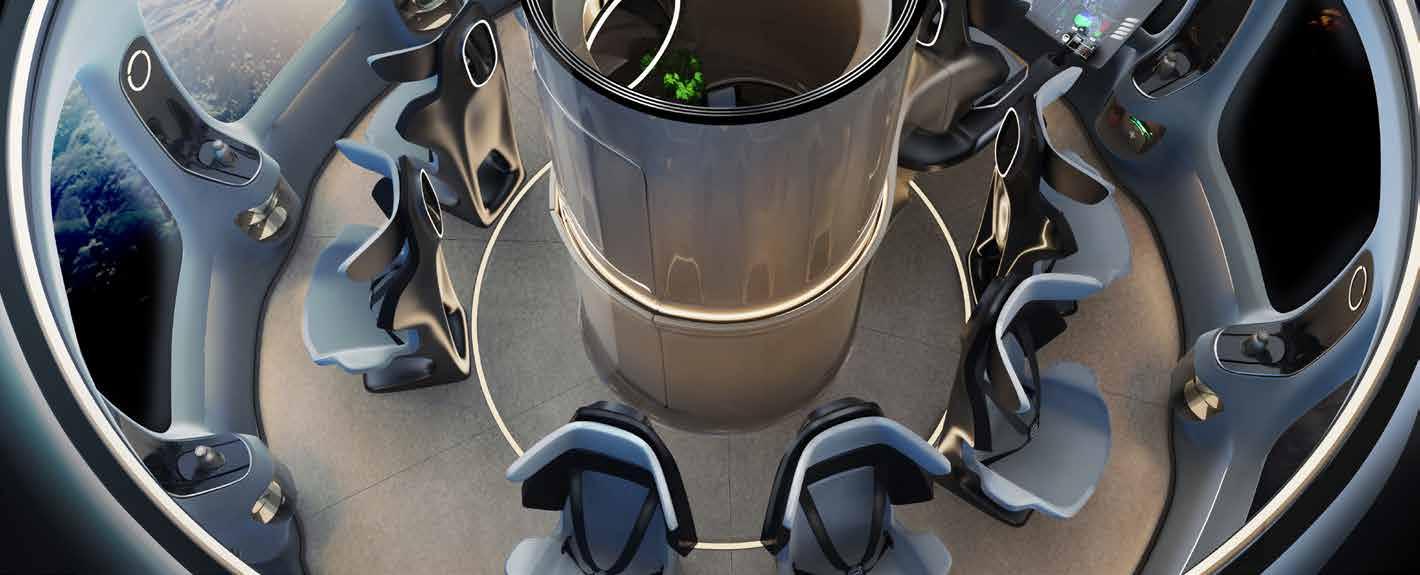


As Roger Dubuis pays tribute to the tourbillon with four outstanding expressions, we speak to CMO Sadry Keiser about the maison’s mission to take horology beyond limits
Words: Michelle Johnson
Roger Dubuis has been blazing a trail since it was founded in 1995 by its namesake master watchmaker. 20 years at Patek Philippe cemented Roger’s reputation as one of the world’s finest mechanical masters until, inspired to explore a new ethos of blending avant-garde design and mechanical expertise, he left to establish his own brand.
“When working for Patek Philippe [Roger] was annoyed there was a dial on top of the calibres, because he thought those dials were hiding his work. That’s the reason he removed dials and created an identity inspired by the mechanics,” says the maison’s CMO Sadry Keiser (right). “Now, 29 years later, we are still paying tribute to the mechanics – not only for the technical challenge but also the aesthetic, which creates the emotion.”
Emotion is at the heart of Roger Dubuis’ evolution into the architect of hyper horology – as I discover when I meet Sadry at Watches & Wonders to get up close and personal with the brand’s four-part tribute to the tourbillon: the Excalibur Sunrise Double Tourbillon, Excalibur Dragon Tourbillon (opposite), Excalibur Titanium Monotourbillon and Orbis in Machina.
Inside the brand’s VIP ‘Just for Friends’ lounge, which Sadry describes as the “Sanctuary
of Hyper Horology”, the comfortable, contemporary décor and exclusive ambiance creates a moment of stillness in the mania that is the world’s biggest watch fair – and the perfect environment to allow these exceptional novelties to do the talking.
“It’s really a journey of fine watchmaking – of what we call hyper horology,” says Sadry. “Aesthetic is very important for us: we have been mastering the tourbillon for more than 20 years, but we also developed our own specific style. That’s the reason we decided to pay tribute to the tourbillon with four novelties, supporting different aspects of our aesthetic.”
While Roger Dubuis is known for its fiercely contemporary style and mechanical creations – it launched the first of its many groundbreaking movements in 1999 and counts Pirelli and Lamborghini Squadra Corse among its engineering partnerships – this year’s novelties showcase the brand’s passion for artisanal craftsmanship, challenging design and enduring savoir faire.
Sadry takes a moment amid the chaos to share Roger Dubuis’ dedication to pushing the boundaries of fine watchmaking and reveals the beauty in the maison’s aesthetic approach to mechanical watchmaking. »



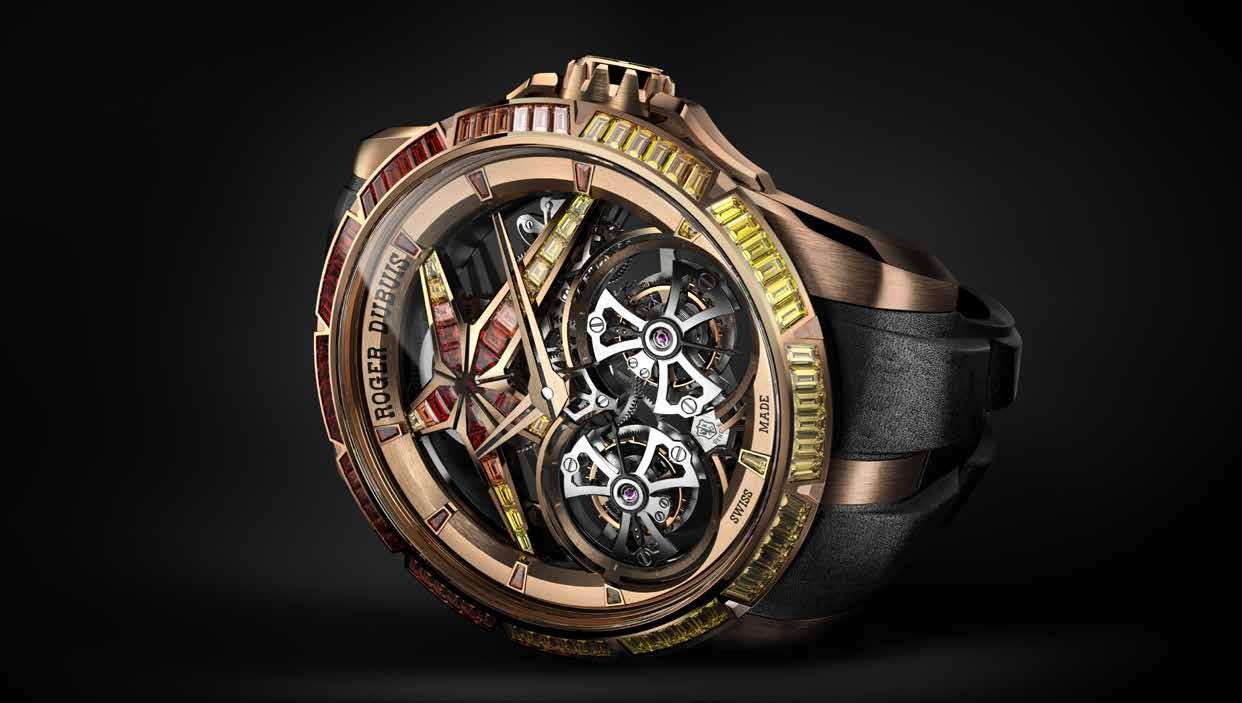
Sadry, could you tell us about these four tourbillon novelties?
The Excalibur Sunrise Double Tourbillon is about settings, with exquisite gems set in the case, movement and calibre itself. The Excalibur Dragon Tourbillon is about the métiers d’art and traditional craftsmanship, combining cultural storytelling and remaining totally contemporary. Then, we have a full titanium expression: the Excalibur Titanium Monotourbillon. It’s very ergonomic, even at 42mm it’s like a second skin. When you have a calibre of that size fully skeletonised, you decrease the weight, but when you combine that with one of the lightest metallic elements available, it creates something very charismatic. Finally, we have the Orbis in Machina, which closes the circle surrounding the tourbillon.
Perfecting the Orbis in Machina has taken many years of prototypes to overcome the challenges of gravity, precision, functionality and more. What has this journey involved?
You are absolutely right. The global process took between three to four years, but it was a series of daily discoveries. We had to rethink everything about the complication, which opened some challenges but gave us the freedom to play with that kind of complication. Every day gives you a fraction of the solution, but also new challenges. When we talk about innovations and development, it’s much more interactive than linear. When you start those processes, you never know what you’ll learn at a given moment, you’re just trying to move towards what you’d like to achieve. It’s a beautiful way to think.
But the essence of hyper horology isn’t solely about technical achievement, there’s also an aesthetic beauty.
Totally. If I had to summarise Roger Dubuis in one sentence, I would say the technique is at the service of the aesthetic. When we define hyper horology, there are three key ingredients: the complication, the expressivity (which for us is open or skeletonised work where you can see the mechanics) and, finally, modernity or contemporaneity. That is the definition of what Roger Dubuis offers, and what makes us different from others. Mechanics, for us, is a starting point.
We’re a watchmaker like no other. Despite being young, Roger Dubuis is a pretty complex maison. It has also taken time to discover what we’re able to do – we are inspired by the past, but we are definitely anchored in the future.
You’ve described your role as the link between your designers and your clients. Where does your professional passion lie?
I think that the watch industry has always fascinated me for two main reasons. First, we’re this crazy brand that’s able to create all those elements and then, at the other end of the chain, there are – if I may say – crazy and passionate clients. I define my role as the connector between those two worlds. If we can find a way to nourish that conversation, it creates a sparkling moment; an energy that inspires us all to go further. There is an exclusivity in the design that is hard to find elsewhere, and so when our clients start a conversation with us, we become friends. The very first pieces that Roger himself released were engraved with the words: ‘Just for friends’.
What inspires your designs?
I think there are two key ingredients. First is curiosity. The more you nourish your curiosity, the better it is for your creativity. Curiosity is mandatory. The second thing is not being centred on your own industry. The watchmaking industry is fantastic in terms of innovation, but there are other worlds outside of our own. The moment you get out of your comfort zone, engage in conversation with others, it nourishes the way you can innovate. When you merge curiosity and open-mindedness, it creates chemistry and momentum.
What influence do your partnerships and friends have on the process?
How people around us influence us is quite complex, because it’s more about those conversations and interactions than something more analytical. We start from the complication rather than the final product. We are working more with the stomach than with the brain on that part of the process – our artistic approach is something that we defend. If you are a painter, you paint something which tests you first and then you hope that you will find someone on the other side of the table. If you paint only to give an answer to the market, you will lose your own personality. Our friends are looking for something astonishing and they love our personality.
What’s next for Roger Dubuis?
We have plenty of ideas, plenty of projects. The only thing that I can absolutely assure you is that, as we are 30 years old next year, you can imagine that 2025 could be an interesting year.
rogerdubuis.com
Just for friends: Roger Dubuis’ four-part tribute to the tourbillion features the Orbis in Machina (main) and Excalibur Sunrise Double Tourbillon (above left)
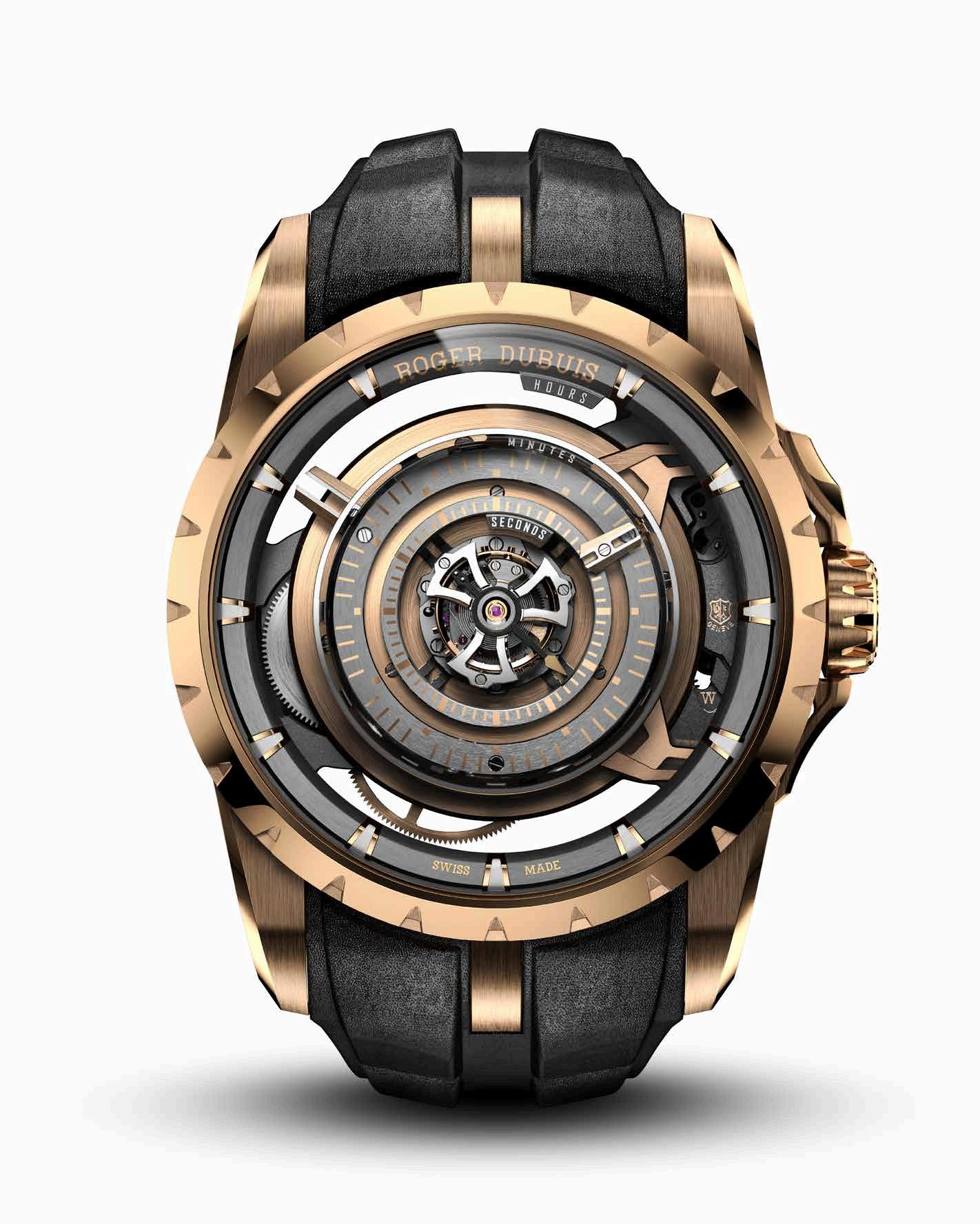
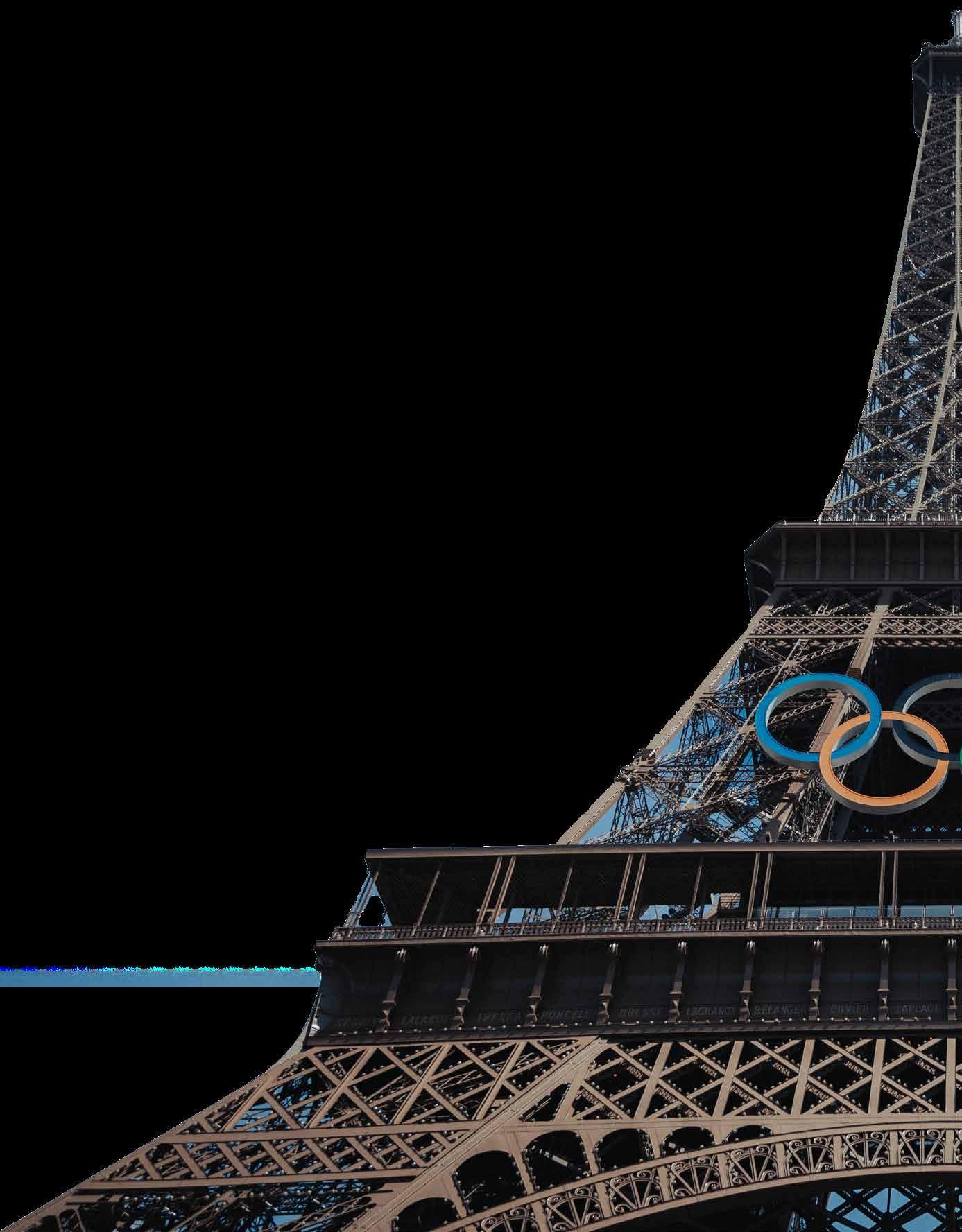
Exactly 100 years since Paris last played host to the Olympics, all eyes are on the French capital as just short of 15,000 athletes descend for the 2024 Olympic and Paralympic Games, battling to be the world’s best. From the top talent to look out for to the flagship events across track, field and more, here’s what you need to know
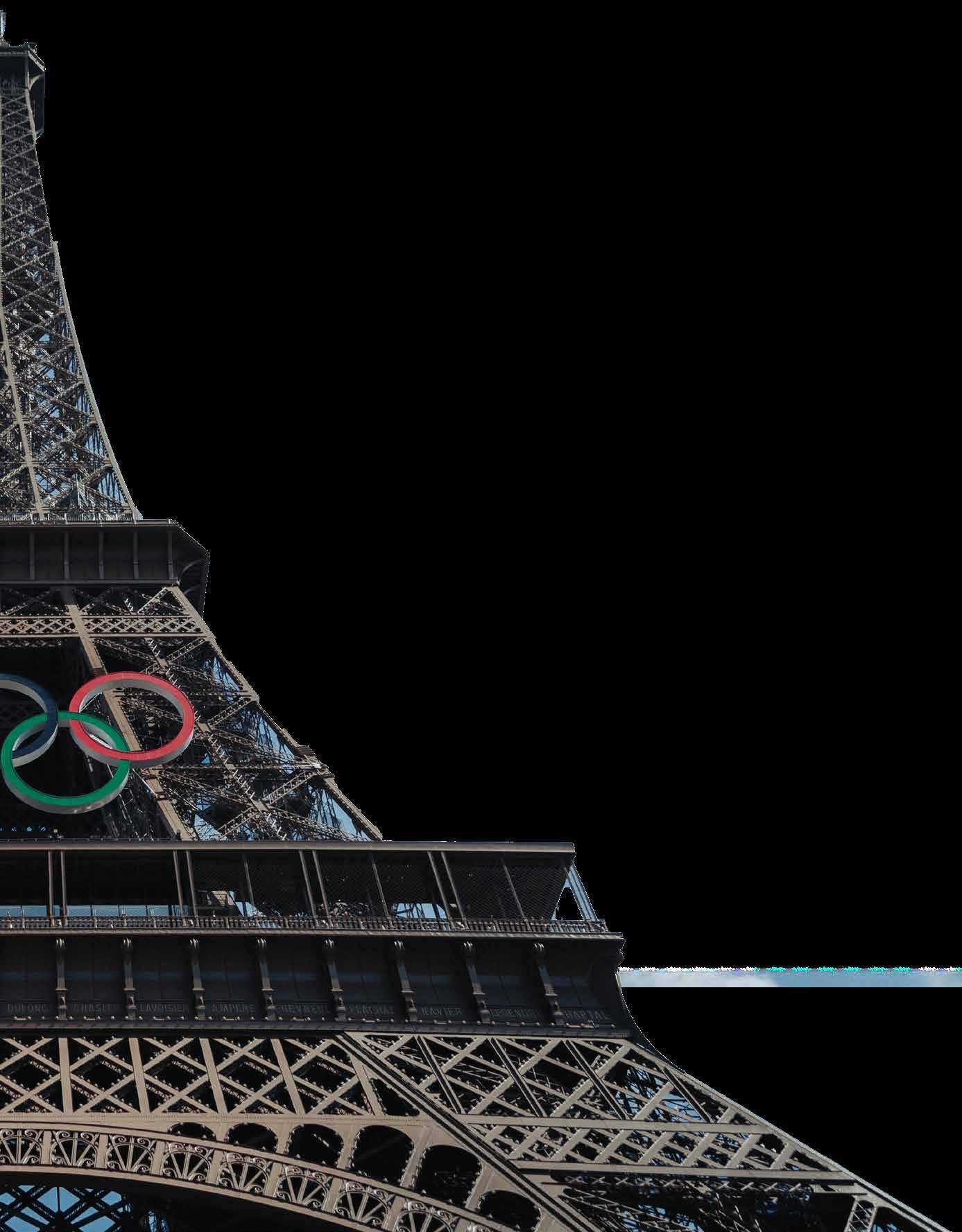

Running from 26 July to 11 August, the Olympic games sees athletes from 206 countries – including a refugee team – compete in 32 sports, each hoping to secure one of the 329 medals available. And this competition has seen Paris’s Olympic Committee focus on ensuring the Games are “more responsible, more inclusive, and more spectacular than ever before”. Building on its previous record, when the 1900 Paris Olympics saw women athletes involved for the first time, this year’s event will be the first to achieve gender equality in the games, with a 5050 male and female balance between the
athletes taking part.
Paris expects more than 15 million fans to head to the city in force, all to support their favourite athletes and home nations.
The Opening Ceremony is the event to kickstart it all, taking place 26 July at 8.24pm local time – or 20:24 if you’re using the 24-hour clock. Très intelligent.
Shunning the usual stadium set-up, Paris has chosen to host the celebration along a 6km stretch of the river Seine. With over 100 boats set to transport over 10,000 athletes down the river in front of fans, the grand finale is due to take place in the shadow of the Eiffel Tower.
With the games officially open, keep an eye out for sport climbing, skateboarding and surfing, which first became certified Olympic sports for Tokyo in 2021. They will be among the 32 sports in the Games, as well as one new addition: ‘breaking’ –otherwise known as breakdancing.
More traditional events like athletics, cycling, swimming and gymnastics will continue to be firm favourites in France. On that note, the women’s 100m final will be held at 8.20pm BST on 3 August, while the men’s takes place a day later at 8:50pm BST on 4 August. Get set for a spectacular sprint finish at the Stade de France.

US sprint specialist Caeleb Dressel (right), best known for his performances in the 50m and 100m, became the fifth swimmer to win five gold medals at a single Olympics in Tokyo. With seven gold medals to his name, he’s often compared to swimming legend Michael Phelps and will be hoping for more gold in Paris.
20.16 sec
50m freestyle




A living legend of the marathon running world who grabbed headlines after unofficially cracking the two-hour mark as part of the Ineos-backed 1:59 Challenge, Eliud Kipchoge (left) has won 15 of the 18 marathons in which he has raced. With two Olympic gold medals under his belt, he’s also won the Chicago (2014), Berlin (2015, 2017, 2018, 2022, and 2023), and London (2015, 2016, 2018, and 2019) marathons. While it’s tight at the top of athletics, all eyes will be on the veteran endurance runner as he hopes to clinch another gold. »
1:59:40 Marathon (unofficial)
By the age of seven, Rayssa (right) was dubbed the ‘Skate Fairy’ and by 11, she was winning international competitions. In Tokyo, she won the silver in street skateboarding aged just 13, becoming one of the youngest medalists in the history of the Games and the youngest Olympic medalist from Brazil.


Jamaican sprinter Shelly-Ann Fraser-Pryce (left) – better known as the ‘pocket rocket’ due to her height of 5ft 3in – is considered one of the world’s best female sprinters. During her career, she’s won three gold, four silver and one bronze medals, including two golds in the 100m race in Beijing (2008) and London (2012), with a silver medal in Tokyo (2020). Born in 1986, Fraser-Pryce revealed that the 2024 Paris Games will be her last competition. 14.64 pts

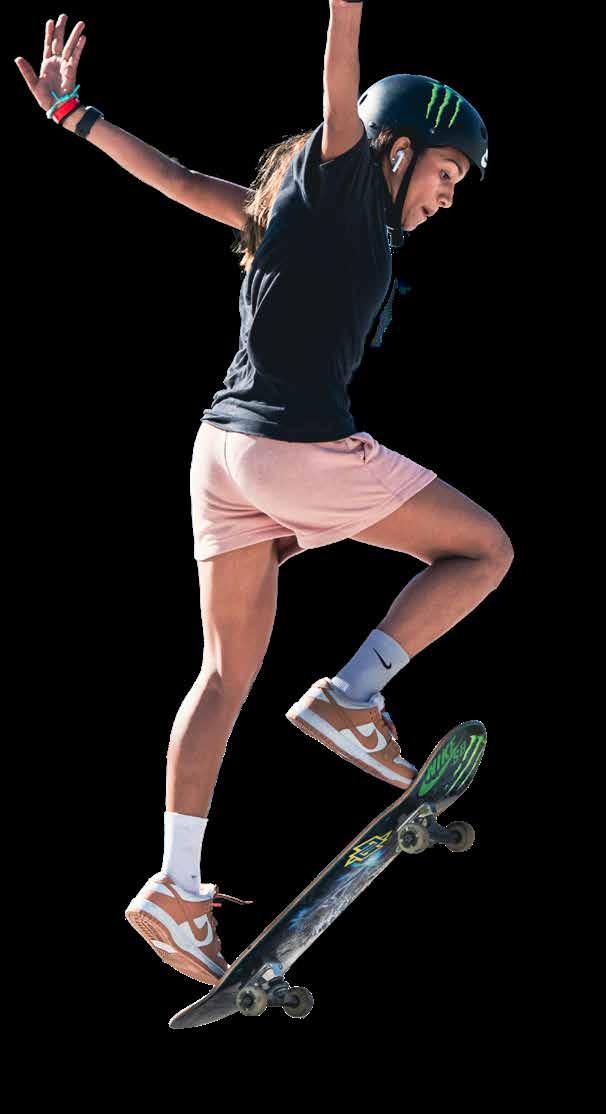
SHELLY-ANN FRASER-PRYCE | JAMAICA

62.416 pts All-around gymnastics


493.35 pts 10m platform
NOAH WILLIAMS | GB
Already equipped with a world and European silver in the men’s 10m synchro platform in 2022, British diver Noah Williams (left) is now chasing an Olympic gold. Alongside teammate and proven gold medal winner Tom Daley, Williams and Team GB have high hopes as he heads into his second Olympic Games. »
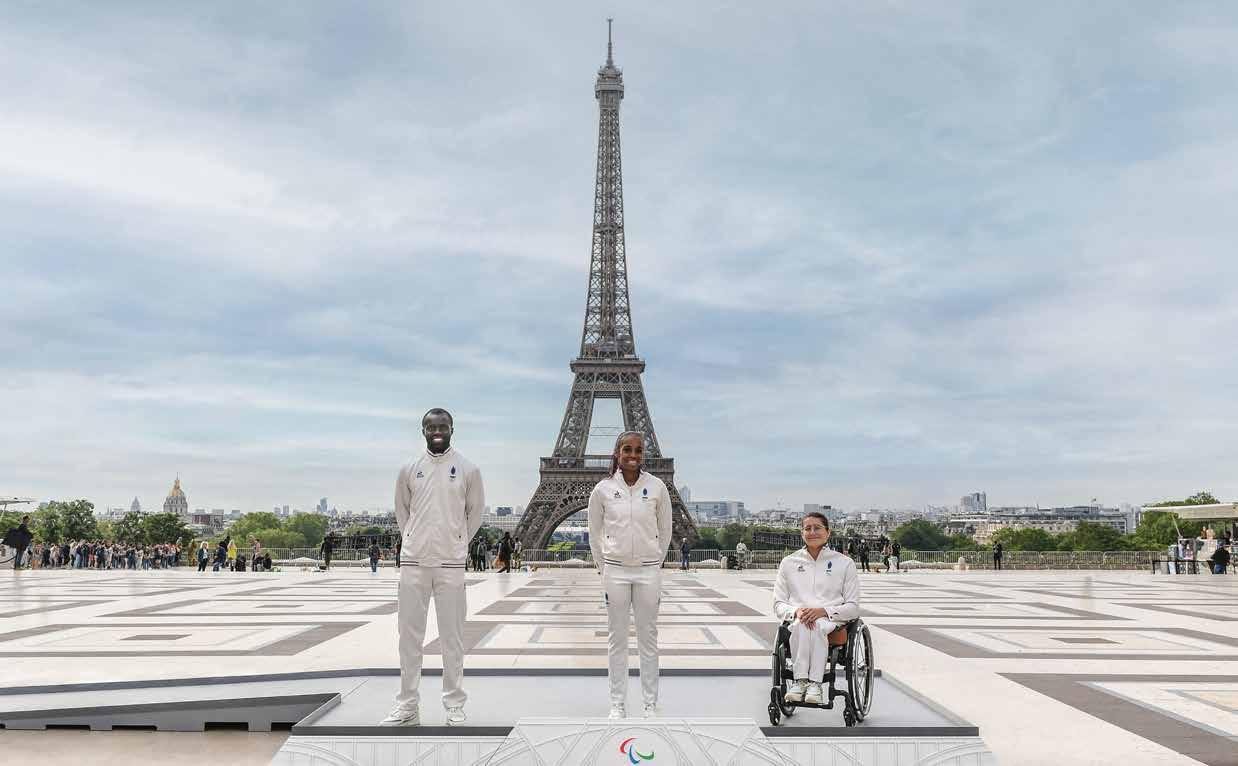
Hot on the heels of the Olympics, the 2024 Paralympic Games kick off in Paris for the first time from 28 August to 8 September. The Games will see around 4,400 athletes from around the world take part in 22 sports, from blind football and para-archery to para-table tennis, parataekwondo and wheelchair basketball. Like the Olympics, Paris has focused on making the Games as equal as possible, with a record number of medal events for women.
The opening ceremony on 28 August marks
the start of the Games; held outside of a stadium setting, the athletes will parade by some of Paris’s most iconic landmarks, along the route between the Champs-Elysees and the Place de la Concorde. The following day, a total of 22 gold medals will be decided on the opening day of the Games.
Sharing many of the same venues as the Olympics, Roland Garros will host wheelchair tennis, while Para-equestrian events will take place in the gardens of
Versailles, and all para-athletics at the Stade de France. For the para-triathletes, the centre of Paris will host the race — including a swim leg in the River Seine, which was last used for the Games in 1900.
By the time the final day arrives on 8 September, the final medal events will take place, such as wheelchair basketball, parapowerlifting, para-canoe and wheelchair marathons. After all that, the closing ceremony will mark the completion of the summer of sport in the French capital.
The reigning 100m T47 Paralympic and world champion set a Championship record of 10.37 on the way to retaining his world title at the Paris World Championships last year. As one of the icons of Para sprinting, the Brazilian (right) has five Paralympic medals to his name, including two golds.
10.53 sec 100m T47 sprint
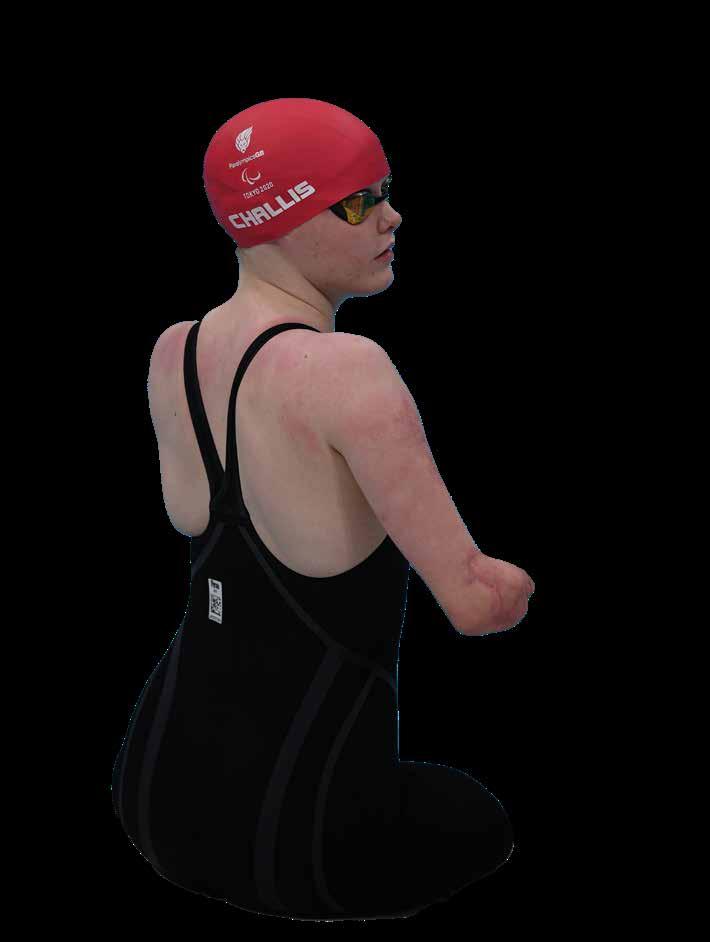
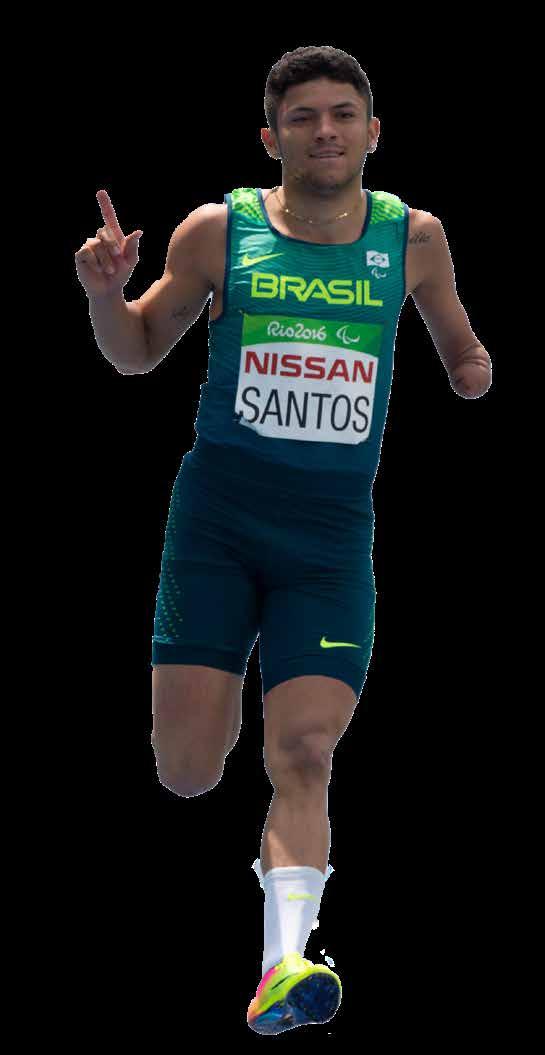
54.90 sec S3 50m backstroke
British swimmer and quadruple amputee Ellie Challis (left) has won nine world medals, including three golds since claiming silver in the 50m backstroke S3 in Tokyo, aged just 17. Returning for her second Paralympic Games in Paris, the Team GB swimmer will be hoping for gold this time round. »

LUCY SHUKER | GB
Britain’s highest ranking wheelchair tennis player, Lucy (left) has represented Team GB at four consecutive Paralympic Games, twice winning bronze in women’s doubles and taking home a silver medal at Tokyo 2020. Supported by Path to Success charity – which funds female para athletes – Lucy is looking forward to representing GB at a fifth consecutive games in Paris.
Wheelchair tennis doubles
TIMOTHEE ADOLPHE | FRANCE
Adolphe claimed a silver medal in the men’s 100m T11 in Tokyo and is aiming for a first Paralympic gold at his home Games in Paris. Off the track, the sixtime World medallist is also a parttime rapper who released his first hiphop EP in 2020.


Two-time Paralympic wheelchair fencing champion Bebe Vio (left) has amassed two gold, one silver and one bronze medal – alongside 1.3 million followers on Instagram – in her quest to inspire young people with disabilities. The 22-year-old contracted meningitis at the age of 11, which resulted in the amputation of all four limbs. As one of the most notable Paralympians heading to Paris, Bebe will be looking to add to her medal collection in the French capital.
Antil is the reigning Paralympic and world champion in the men’s javelin F64. As one of the biggest names in Indian Para sport, Sumit (right) is also a firm favourite for a medal in Paris and the world record holder, after throwing 73.29m at the Hangzhou 2022 Asian Para Games.

Olympic sprinter turned broadcaster Jeanette Kwakye talks the Olympic Games Paris 2024, the evolving world of women’s sports and being on the other side of the lens
Words: Shivani Dubey
Jeanette Kwakye MBE knows the world of the Olympic Games all too well. The retired British sprinter’s myriad achievements include competing at the Beijing 2008 Games and winning silver and bronze medals at the 2008 World Indoor Championships and 2002 World Junior Championships respectively.
The athlete swapped sprinting for broadcasting in 2012 and, this year, will return to our screens at the Olympic Games Paris 2024 as one of the BBC’s sports broadcasters and expert pundits, as well as hosting the Olympic’s Athlete365 Webinar Series. Having hosted the action at Tokyo 2020 –notably held in 2021 during Covid-19 pandemic lockdowns – Jeanette is excited to see a return to crowded stadiums, and says fan support will make all the difference in Paris.
“[Last time], there was no one there,” she says. “It was crazy to be in a stadium in Tokyo while these athletes are giving the performances of their lives, and no one’s there to cheer them on.”
As a former competitor, Jeanette, 41, can empathise with the unique pressures of performing at such a high level.
“The whole experience is so unique to any individual. It’s a beautiful thing to go there and know that you might give the best performance of your life,” says Jeanette, who achieved a lifetime personal best for the 100m sprint at Beijing 2008. “There are nerves, of course – it is the Olympic Games, after all – but, above all, there is gratitude to have made it there.
“The daunting part is just wanting to make sure you can do what’s best for yourself, and that you go there and give everything you’ve got. Because the next one’s four years away – that’s a long time
to wait, and there’s no guarantee that you’ll make it again.”
So how does one train for the Olympics? Jeanette advises athletes to carry the same mindset as training for any other tournament: namely, “Go out there and give it everything you’ve got”. But, at the Olympic Games, the stakes are higher and the former Olympian has one crucial piece of advice.
“It’s a very privileged position to be in. So, if it is your first time, just soak it in and don’t put too much pressure on yourself,” she says.
“A lot of the time, the athletes are really dialled in and they’re just focused on what they’re doing. But as soon as they’re done, you just see the energy and the friendliness because everybody respects what each athlete has had to go through to get to that particular point.”
The shift from sprinting to broadcasting has come with its fair share of challenges, says Jeanette –particularly when it comes to still feeling part of the team yet having to remain impartial and ask difficult questions of her sporting colleagues.
“You need to have perspective, a bit of warmth, and the timing’s got to be right,” she adds. “The last thing anybody wants to hear if they’ve had a bad race is: ‘You didn’t run as well as you thought’.”
One of the joys of Jeanette’s role has been having a front-row seat to the surge of popularity for women’s sports; from cricket stadiums packed with fans watching women’s international tournaments to the England Lionesses dominating the world of women’s football to win the Euros 2022. Having presented the UK’s Women’s Super League for five years, she has seen
firsthand how perception has changed.
“I’ve seen the growth every single year, but that’s because the England team is very good – they won the Euros. We know that we’ve got a team we can get behind, and I think other sports are starting to take notice of that and push their profile forward,” says Jeanette.
The rise in female success and exposure is particularly important to Jeanette as a mother, she adds, having experienced how seeing greater access to sports played by female athletes has inspired her daughter.
“I’ve got a little girl,” she says. “I never would have thought that would be the case but she’s now got exposure to [so much more]. I wish I had that when I was a child; it’s quite inspiring to see.
“I’ve been watching male-dominated sports so much, I love cricket and football, but now women are doing it and it’s really cool to see people packing the stadiums and cheering them on.”
When it comes to this year’s Olympic competition, however, Jeanette has high hopes for Team GB middle-distance runner Keely Hodgkinson: “Keely has struck silver every single time on the world stage, and everyone’s priming her for gold this year. I really hope she can do that.”
As for the rest of the world, Jeanette is looking forward to seeing the US men’s and women’s basketball teams, as well as American gymnast Simone Biles. In the world of tennis, Jeanette is particularly excited about the pairing up of Rafael Nadal and Carlos Alcaraz from Spain.
“Alcaraz talks all the time about how Nadal is his idol and now he’s playing with him. They’re creating a legacy – it’s like Nadal is handing over the baton,” she says. “It’s incredible.”
THE OLYMPICS ARE SO UNIQUE. IT’S A BEAUTIFUL THING TO GO THERE AND KNOW THAT YOU MIGHT GIVE THE BEST PERFORMANCE OF YOUR LIFE

The City of Light will always have eternal appeal. Here’s how to enjoy Paris through the Olympic Games and beyond…
Words: Judy Cogan

Paris’s original palace hotel, Le Meurice, is a destination that has it all: perfect location, resplendent history, contemporary amenities and exceptional service. Now part of the Dorchester Collection, this 200-year-old grand dame overlooks the Jardin Tuileries and is a mere stone’s throw from the Louvre, Rue SaintHonoré and Place Vendôme.
The interiors of Le Meurice are designed to reflect an uninterrupted attachment to the French art of living and an homage to Versaille.
Walking through the doors, guests enter a serene and elegant world (bottom right), where the refined splendours of 18th-century architecture have been flawlessly updated by industrial designer-architect Philippe Starck and Charles Jouffre – the French artisandesigner who created the sumptuous drapes and hangings of the Grand Foyer at the Opéra Garnier. One only needs to look up to see the same influence here: stunning, atmospheric tapestries adorn the ceilings of Restaurant Le Dalí and Bar 228.
The rooms and suites (right) are equally impressive – not to mention particularly spacious for the French capital. The hotel’s statement penthouse suite, the Belle Etoile suite, boasts 250 sqm and a 360-degree view of the world’s most romantic city – including the Eiffel Tower – from the wraparound balcony (left).
For les gastronomes, Le Meurice has much to offer. The hotel’s two Michelin star Restaurant Le Meurice Alain Ducasse is overseen by chef Amaury Bouhours, who masterfully lifts fresh and local ingredients – so local, in fact, that the restaurant is awarded by sustainable label Ecotable – to something very special indeed, balancing a relaxed but refined ambience that is central to the hotel’s approach. Fresh, seasonal produce bursting with French flavour is very much at the heart of the restaurant concept, paired, of course, with exceptional wines from the hotel’s generously stocked cellar.
But for those with a sweet tooth, it is worth staying here solely for the genius desserts of La Patisserie du Meurice par Cedric Grolet, whose decadent fruit sculptures are flavours for the soul. Finally, Bar 228 is the ideal destination to while away an evening; rich, moody lighting, impossibly comfortable armchairs, and live jazz music to entertain as you enjoy a cocktail, conversation or a good book.
Here, Le Meurice general manager Franka Holtmann shares her favourite elements of the hotel’s sensational savoir faire.
Franka, what makes the rooms and suites so special?
All rooms have incredible views, and we balance the best of French heritage with the most modern features. The executive balcony room 605, facing the Jardin Tuileries, is our most requested – an attic room on the sixth
floor kept as a Parisian apartment. The unique twist of this room is the beautiful hand painted wallpaper from de Gournay of exceptional quality with themes and patterns of the natural world, as an echo to the Tuileries. I’d also recommend booking a night at our Belle Etoile suite to enjoy a glass of Champagne on the 250 sqm terrace with 360° views.
Tell us about your typical guests?
Some of our guests have been coming to Le Meurice for more than 30 years. The hotel is ideal for both individuals and families – even larger ones – as the rooms facing the Tuileries Gardens on each floor can be connected to form a typical Parisian apartment with up to five bedrooms. A lot of our guests come for leisure, either taking time to discover the French capital, or as a stopover before going to Normandy or the South of France. Our guests know in advance that the employees will take care of them, always be available for special requests and make them feel secure. We create a home away from home.
What about Le Meurice’s various culinary offerings?
We’ve always stood out among the best. It is my second experience with [chef] Alain Ducasse and I would consider him a pioneer and visionary. His culture and curiosity allows him to always be ahead of the curve. As a skilled and decisive captain he federates our teams, led by executive chef Amaury Bouhours, who takes them constantly up to the next level by proposing new challenges. Alain prefers seasonal culinary experiences to exotic creations and every detail counts. We have Le Dalí restaurant (run by Clémentine Bouchon), Bar 228 and our banqueting service.
How would you spend a perfect day in Paris?
After breakfast I’d head to rue SaintHonoré – right behind the hotel – the best neighbourhood to find chic and classic French boutiques. I would make a quick detour to the Palais Royal, strolling around this very typical Parisian area lined with exceptional shops and authentic cafés, facing the apartment of French Gigi author, Colette.
After lunch at Allard, on the left bank, I would visit the Fondation Pinault at the Bourse du Commerce to see an amazing contemporary art exhibition. Art gives Paris a new poetry. Then, head to Spa Valmont pour Le Meurice to get pampered before ordering a tea and some Cédric Grolet pastries. To end the day, I’d see an opera at Palais Garnier followed by a sparkling midnight drink at their CoCo bar – and I’d spend a night at our Belle Etoile Penthouse suite with a view of Paris’ monuments from Sacré-Coeur to the Eiffel Tower and the Arc de Triomphe. »
dorchestercollection.com
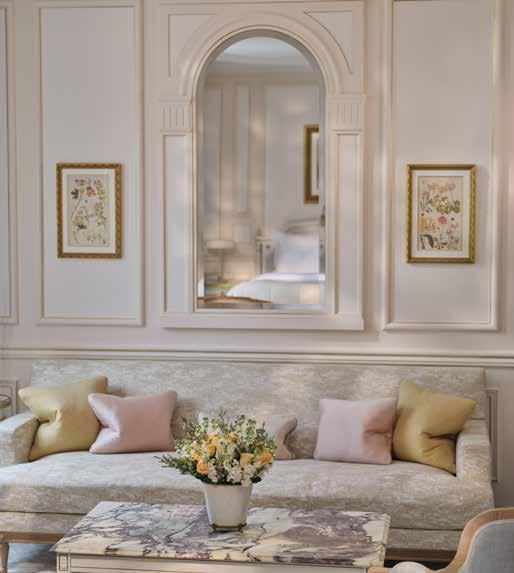

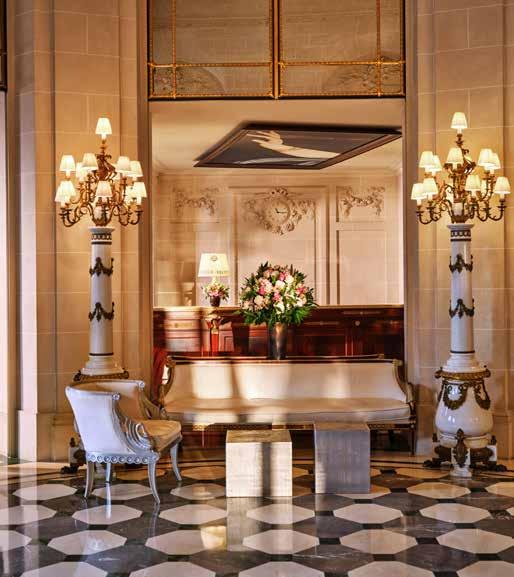
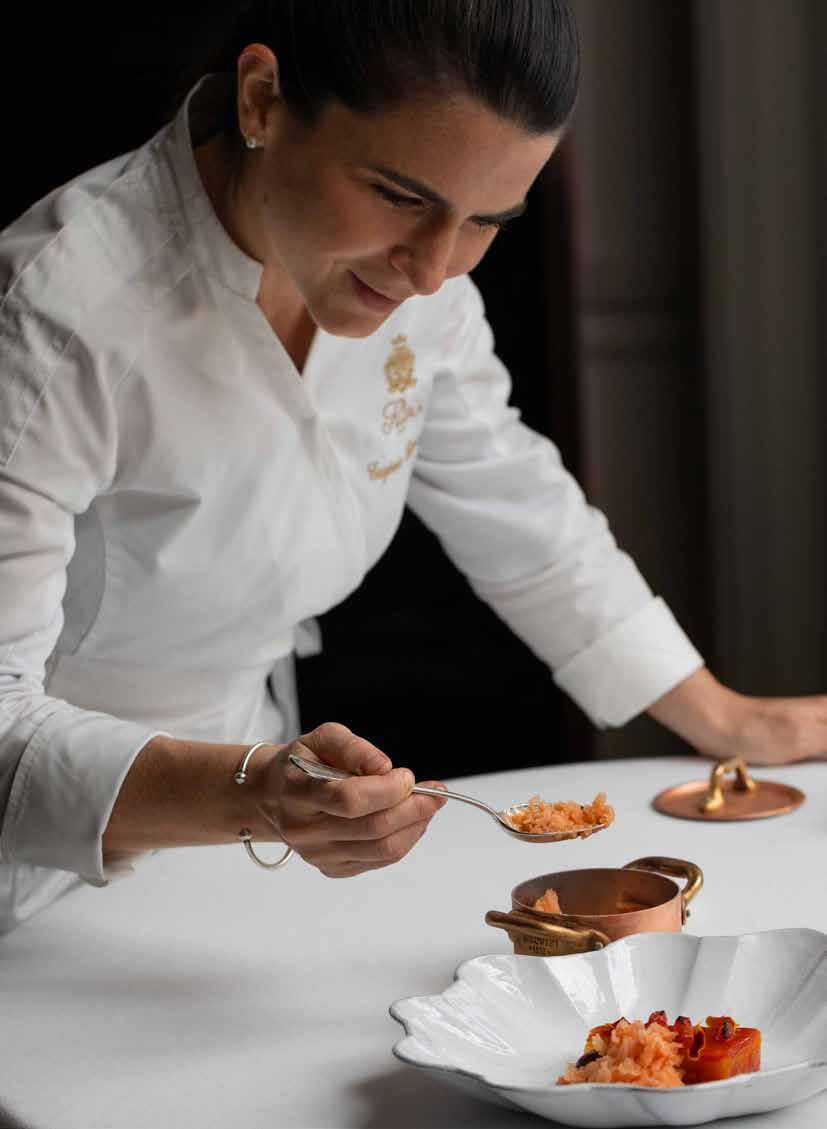
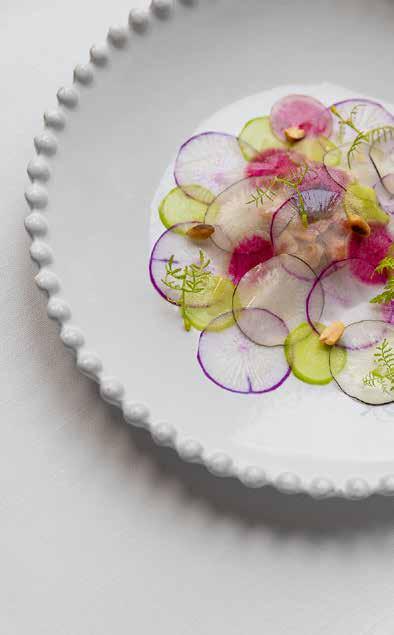
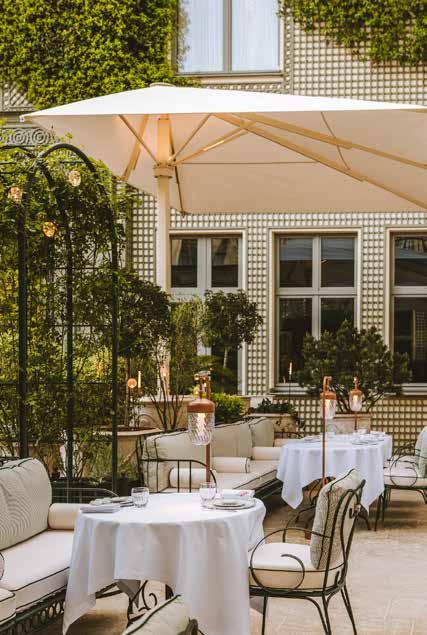
The Ritz Paris first opened in Place Vendôme in 1898 and soon became one of the most luxurious and highly regarded hotels in the world. But far from relying on past success, the hotel completed a four-year €140m (£111m) in 2016, breathing new life into the historic institution. Eight years later, Eugénie Béziat (left) is pioneering the Ritz’s gastronomic influence as the hotel’s first female head chef, where she infuses its new flagship restaurant L’Espadon (below) – which opened in Septemer 2023 – with her Michelin-star mix of Provençal and African heritage. Since joining in 2023, L’Espadon has wowed guests and gastronomes around the world with the stand out fusion dishes that so perfectly reflect modern Paris. Here, the talented chef tells us more.
Eugénie, tell us about some of your highlights as head chef of The Ritz Paris?
Learning to work and evolve in one of the most beautiful hotels in the world with very high standards, incredible customer care and absolute attention to detail has been quite a challenge. My greatest victory was to obtain our first Michelin star just six months after opening the restaurant. This is a source of great pride for the restaurant’s teams.
What is the one dish everyone must order at Espadon?
The lobster cassava bissap is a dish that takes you on a sensual gourmet voyage. It has a delicate aesthetic, blending hibiscus, cassava semolina, samphire and sea urchin. It combines all the technical skills of French gastronomy with my personal inspiration, which comes from my childhood living in Africa for 18 years.
Where do you love to eat in Paris on a day off?
I recently discovered the restaurant called FIEF (Fait Ici en France) by Chef Victor Mercier. I really loved his very tasty, authentic and refined French cuisine – and the setting, with its open-plan kitchen. I also love to go to Tekes, for its Mediterranean cuisine and atmosphere.
What is the biggest misconception people have around French food?
That French cuisine is too rich – cream, dishes in sauce, butter – whereas nowadays French cuisine is much lighter. My kitchen thrives on three words: communication, empowerment and serenity – not just butter.
ritzparis.com

With flagship designer stores, vintage and concept stores, and French boutiques in abundance, shopping in Paris is a must. For high-end brands, start at the Avenue des Champs-Élysées (right), stretching between Place Charles de Gaulle and Place de la Concorde. Place Vendome is home to French couture greats: Chanel, Dior and Louis Vuitton and the finest jewellery ateliers (Boucheron, Cartier and Van Cleef & Arpels). And look out for the wood-panelled three-floor Hermés shop on Avenue George V, with its unmistakable gilded lettering and each floor boasting a specific style and atmosphere. For more unique finds and antiques, visit Le Marché aux Puces de Saint-Ouen to find vintage Chanel gems between dusty glassware and mid-century furniture. La Boutique de Cara is a beautifully curated boutique off Rue de Turenne also bursting with vintage designer one-offs. Saint-Germain-des-Prés is renowned for some of the world’s best art, decor, antiques and fashion – the stunning Le Bon Marché department store is also in this beloved Left Bank neighbourhood. The 19th century La Samaritaine, reopened in June 2021 after a 16 year wait, now stands as a Belle-Epoque shopping destination boasting seven floors of glorious fashion, jewellery and beauty.
Cultivating a personal sight-seeing plan in a city like Paris can feel like a gargantuan task, but there’s a fine line between going off-the-beaten track and missing all the hot ticket sights that make up such a special place.
Why not enjoy live classical music by candlelight in a grand music hall, travel back in time at the Musée de la Vie Romantique or feel at one with nature on the Promenade Plantée?
If you’re a little Louvre-d out, but still appreciate serious art, visit Austrian gallerist Thaddaeus Ropac’s namesake gallery in Pantin, or the nearby Musée National Picasso-Paris, which houses 5,000 of the great artist’s works.
If you have time, venture a little outside of Paris to discover the historic Palace of Versailles – Italianate gardens (left), dripping chandeliers and Marie Antoinette-levels of opulence.

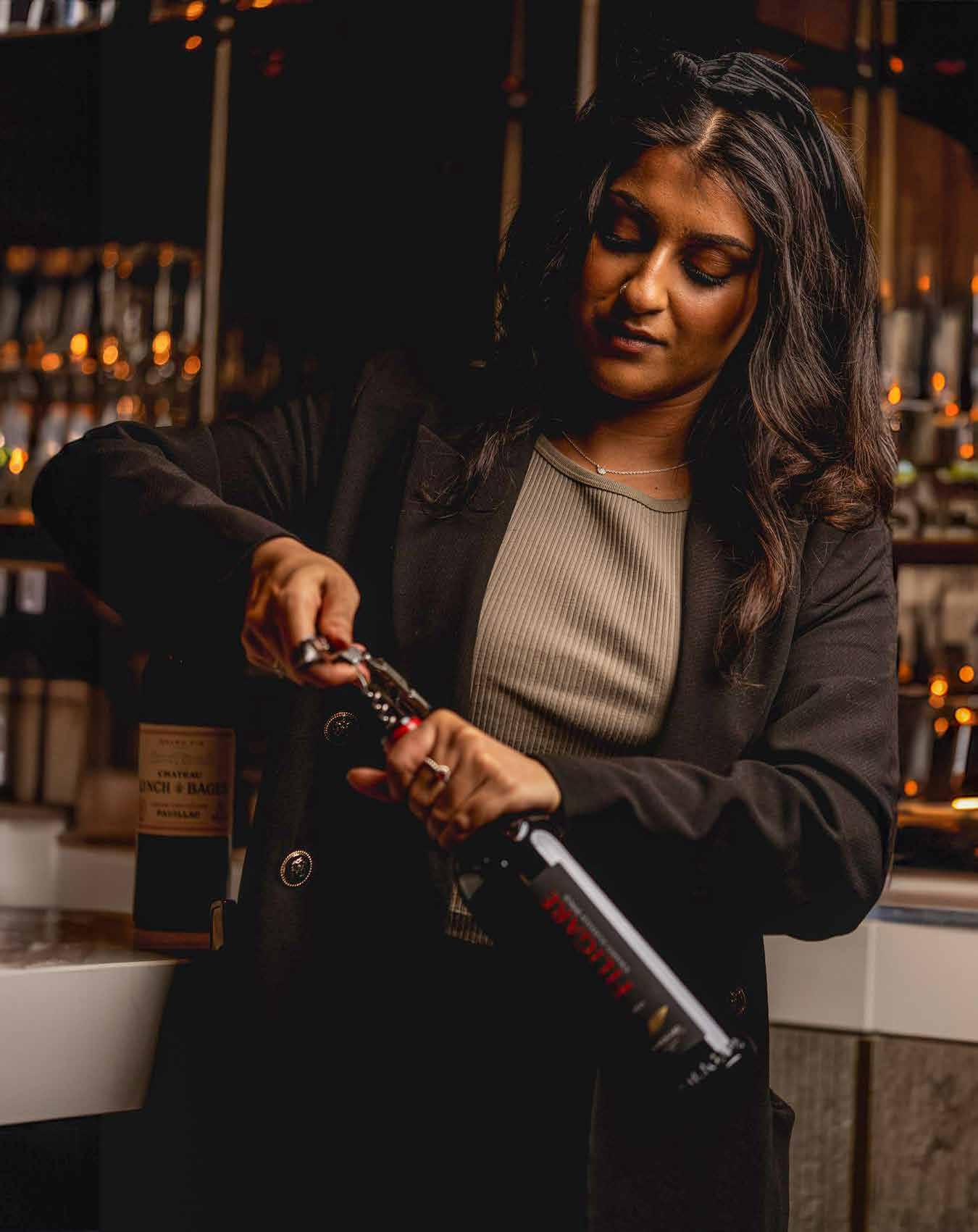
How superstar sommelier
Zinzuwadia is shining a light on exciting new flavours – and supporting diverse talent in the wine industry
Words: Michelle Johnson
If there’s one thing we know about fine dining, it’s that the success of even the greatest restaurants depends on the passion of their chefs and restaurateurs. And it’s the same passion for wine – and its cultural impact – that inspires award-winning sommelier Henna Zinzuwadia to challenge traditional culinary pairings and showcase world cuisine by highlighting thought-provoking wines with a story to tell.
Henna’s outstanding mission to uplift both global fine wine and multicultural cuisine began at London’s Bedales wine bar, and has grown to hosting Chef’s Table events with international chefs, and mentoring up-andcoming young women in hospitality. In 2020, she joined Michelin-starred West African
restaurant Akoko as its head sommelier, before moving to Michelin Bib Gourmand Pahli Hill Bandra Bhai – another Fitzrovia legend.
I first meet Henna at a show-stopping Four Hands Series event by the Ayọ Collective, a project Henna launched with her Akoko colleagues, chefs Victor Okunowo and Angelo Gonzalez. On this occasion, guest chef Liam Barker led a one-night-only 10-course tasting menu designed to celebrate the flavours of Colombia’s Caribbean coast. Each dish –ranging from ox cheek posta cartagenera and scallop and lulo ceviche, to a mouth-watering sea bass and chimichurri dish followed by pork belly baneja paisa and bistec – was an explosion of perfectly balanced flavours and technical flare. And each was exquisitely matched with an
inspired, often surprising, fine wine pairing from Justerini & Brooks’ impressive portfolio.
Henna’s selections not only lifted the cuisine to new and morish heights but came with fascinating stories from producers – whether the 2020 Loire Valley Famille Lieubeau Château Thébaud Muscadet, the 2020 Borja Perez viticultor Artifice Tinto from Tenerife or the 2019 Poppy Cabernet Sauvignon from Pasa Robles, California.
Henna’s enthusiasm for her craft shines through when we meet again – this time at Justerini & Brooks’ boutique and tasting room in London’s Burlington Arcade – to talk about how she is determined to inspire diversity in the wine world, and the great joy that wine has brought to her life. »
Henna, we met at a chef s table dinner. What is the atmosphere like for you at such an event?
It’s important to be able to adapt to how each [event] works. Sometimes, I won’t get the official menu until a few days before an event – meaning what I’ve tasted during development days is probably not what I’ll be serving on the night. Sometimes I’m pairing wine literally seconds before our guests get their glass. Working in open kitchens means we’re always meeting new people and that’s something that drives us. We genuinely have as much fun as our guests do.
What’s the secret to pairing wine with African or South American cuisine?
Throw what you know about European pairings out the window, because you are working with spices and cooking techniques that completely overpower traditional pairings. I always ask the chef the main characteristics of the dish and how the components are cooked – meat cooked on fire will have a smokier quality, but a sweeter element when steamed in banana leaf.
Next, the spices: is it high in chilli or aromatic spices? Colombian dishes use a lot of coriander, while Nigerian cooking might use iru. Finally, the texture of the dish.
With wine pairings it’s about balancing acidity, tannins, alcohol, body and flavour, but there’s never a wrong answer. Orange wines are a staple when it comes to pairing with South American food, especially fish. You’ve got the gentle tannins but with a different flavour profile to a red.
How do you balance individual course pairings with creating a journey through the menu for your guests?
When it comes to deciding the whole flight, I let the food lead – but there’s still enough scope for the wines to have their spotlight. It’s always nice to throw in a surprising pairing. I often put the wines in an order people might not expect to keep it fun and engaging. A chilled red – like
an Italian Schoppetino (perfect with a beef tartare or peanut-based sauce) – towards the start of the menu is a nice way to showcase reds in a different light. Or mid-menu, where food tends to be richer or heavier, I like to pair a champagne to perk you back up.
What drives your passion to diversify the wine industry?
The first time I realised diversity was an issue was while training for my WSET [Wine & Spirit Education Trust] Level 2 qualification. Everyone identified honey as a tasting note, but when I said sugar cane I was looked at like a complete idiot. This wine had transported me back to my childhood in India eating sugar cane, but I was advised that I shouldn’t write that in the exam and instead needed to learn the lexicon. Over time I realised that didn’t feel right – for example, when we taste sauvignon blanc a key tasting note is often ‘gooseberry’, but I’ve never tasted a gooseberry.
More Indian and African people are coming into hospitality but they’re not able to access specialised roles – one of those being wine –because the Eurocentric tasting lexicon is such a barrier. It’s not that they don’t understand the wine, but they don’t have the references of a European diet. I’m mentoring three young women of colour from outside of the UK, and it became very apparent that they didn’t have the references for so many of these tasting notes.
I think it’s possible to widen this lexicon and add flavour notes that are more inclusive. It will take time, but it’s really important that we have that inclusivity of language in leadership roles – and open doors for more consumers to enjoy wine on a deeper level.
What inspired you to begin your career as a sommelier?
I was studying economics at university when I had an accident that left me almost paralysed. I moved to London during my recovery. When I
learnt to walk again, I wanted to celebrate with a bottle of wine. I wanted to learn about what to buy but didn’t have the best experience [with wine merchants]; I think I was quite pre-judged. I eventually came across Bedales in Spitalfields, and the sommeliers were so open to talking about wine; I thought it was just amazing. I asked them for a job and, eventually, they took me on. The team was very supportive through my recovery, paying for my WSET and slowly introducing me to the floor. Two years later, aged 21, I became general manager of one of their branches. In 2020, an opportunity came up for a head sommelier role at Akoko. They wanted someone who could pair West African flavours.
Why is the story behind the wine important to you?
It’s always exciting to discover new winemakers. The new generation of winemakers is steering away from previous generations, taking on big risks and challenges for the future of wine and doing an amazing job. You never stop learning in wine – there’s always something new to try and that’s exciting. The people behind the products really matter; we try to showcase that when we’re presenting wines and dishes to our guests.
Are there any regions or wine varieties that are exciting you right now?
I would say the Canary Islands, Tenerife. People are investing in abandoned vineyards and reworking the ground – I’m really excited to see what comes in the next five or 10 years. Darker rosés, like tavels. I like a lot of Californian wines; Pasa Robles is doing really well. I think it’s about keeping an open mind to the region beyond the AVA [American Viticultural Area]. It’s worth exploring upand-coming wine growers steering away from tradition. I think that’s something Justerini & Brooks reflects really well in their portfolio.
justerinis.com
THE NEW GENERATION OF WINEMAKERS IS STEERING AWAY FROM PREVIOUS GENERATIONS, TAKING ON BIG RISKS AND CHALLENGES FOR THE FUTURE OF WINE

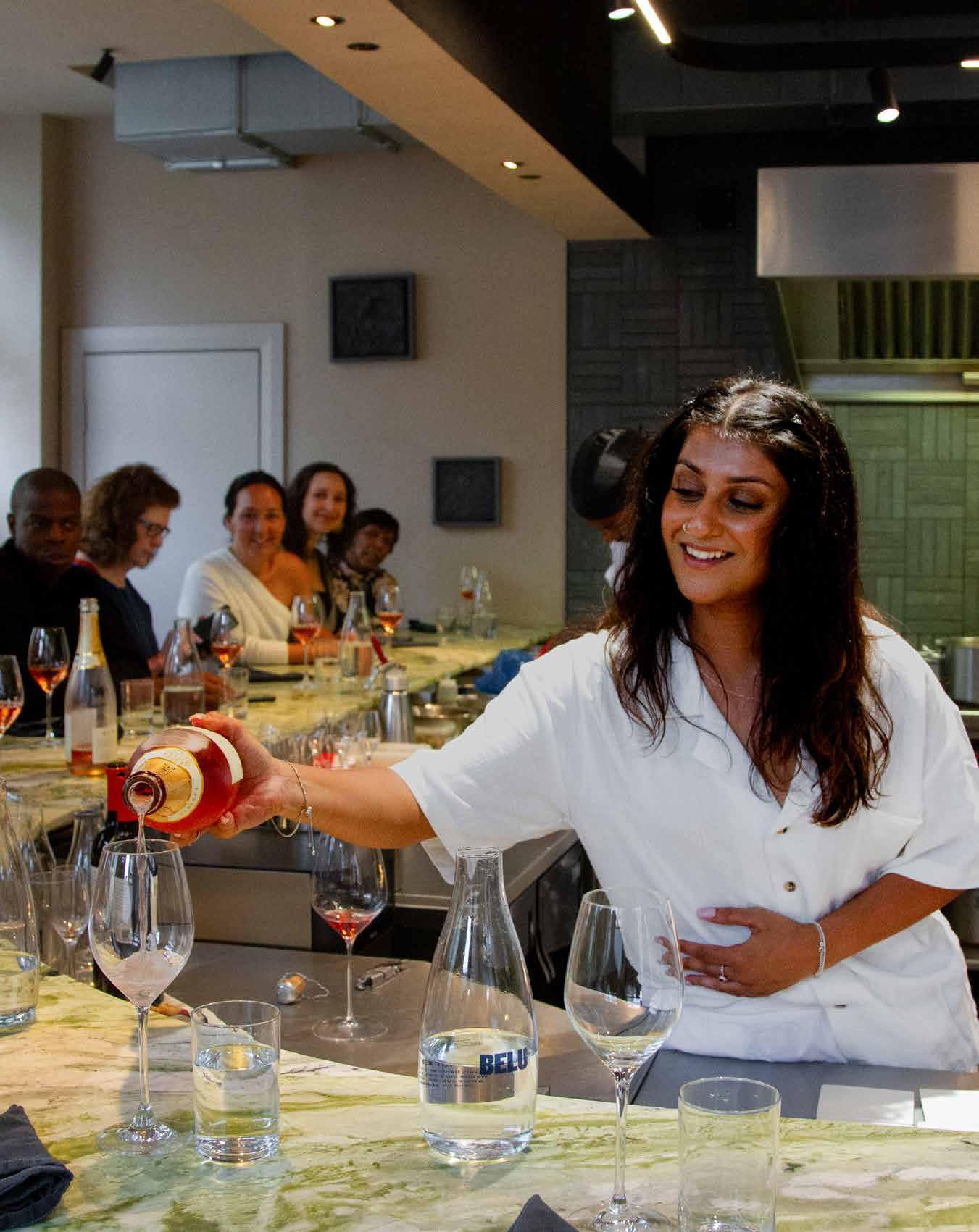

We live in an age where ‘wellness’ is paramount. It’s become the gold standard for a fulfilled life and, within that, travel stands as a compelling remedy not only for the restless soul but for the fatigued, emotionally-lacerated mind and body. While the emotional ‘lift’ delivered by a holiday is obvious, recent scientific research has unpacked its deeper physiological and psychological benefits. Travel goes way beyond mere escapism, or, indeed, a visit to any destination or resort; it’s been revealed as a potent wellness exercise.
Science behind the serenity
Travel’s impact on the human mind begins long before jetting off. The American Psychological Association found that anticipating a holiday can boost happiness for up to eight weeks before a trip. The anticipated break from routine and the promise of new experiences engages the brain’s reward systems, reducing stress hormones like cortisol.
Almost immediately upon departure, travel induces a state of physiological relaxation and rejuvenation. What’s more, exposure to new environments often involves increased physical activity, whether that’s exploring a new city on foot, hiking in nature or swimming in the ocean.
Cardiovascular health is boosted, muscular strength is enhanced and flexibility improves. A change in climate and diet can also offer a positive reset to bodily systems. Remember that feeling of recharge?
A holistic investment
Travel transcends the feel-good factor and emerges as a substantial investment in oneself, its benefits manifesting not only before and during your trip but lingering long after you return home.
The Framingham Heart Study found that men who didn’t take holidays were 30% more likely to have a heart attack compared to those
Steppes Travel explores the holistic health benefits of travel — and offers the key to unlocking wellness for mind and body
who did. Travel isn’t merely an indulgence, it’s a preventative measure against chronic health issues.
Let’s not forget the psychological benefits of travel. Immersion in new cultures and environments fosters cognitive flexibility and enhanced creativity. This stimulation of the brain’s neural pathways is akin to a mental workout, improving problem-solving skills and increasing resilience. The Journal of Personality and Social Psychology suggests that people who engage in diverse cultural experiences tend to be more open-minded and emotionally stable.
The best medicine?
Determining the optimal frequency of travel for maximum benefit involves balancing practicality with wellness goals. While extended holidays may not be feasible for everyone, research suggests that shorter, more frequent getaways can be just as good.
The University of Tampere in Finland indicates that the positive effects of a holiday peak at around eight days, after which relaxation levels tend to plateau. Therefore, planning several shorter trips throughout the year may provide sustained mental and physical health benefits.
The elements of a beneficial holiday –travel beyond the beach
In wellness terms, not all holidays are created equal. While relaxation is a key component, simply lying by a pool isn’t all it’s cracked up to be. Evidence suggests that a truly beneficial holiday incorporates elements of adventure, learning and physical activity. Engaging in local cultures, trying new cuisines and participating in activities like community and eco projects or creative workshops is actually good for you.
A study by Cornell University highlighted that experiential activity, like those listed above, provide more enduring happiness than material or hedonistic purchases. They contribute to personal growth and social
connectedness, both essential components of overall well-being.
So, what’s the best kind of holiday for my health?
Consider holidays that blend relaxation with active and meaningful experiences. Wellness retreats that offer yoga, meditation and spa treatments can rejuvenate the body and mind, while adventure holidays, and wildlife and wilderness experiences can invigorate and challenge the mental and physical self.
Culturally immersive holidays, which allow you to engage deeply with local customs and traditions, foster a sense of belonging and purpose, crucial for mental health. For example, culinary tours that involve learning to cook local dishes not only provide a sensory delight but also a sense of achievement and cultural appreciation.
The natural call to action: book a holiday. Right now
Travel, backed up by science, is much more than a luxury; it’s a holistic wellness exercise that nurtures mind, body and soul. Stepping out of our daily routines and immersing ourselves in new environments opens us to a world of possibilities that enhance our well-being in extraordinary ways.
Whether it’s a short break or an extended adventure, the act of travel is an investment in our health, happiness and overall life satisfaction. So, pack your bags and set forth, knowing that each trip is a step towards a healthier, better, more satisfied you.
Voted a Conde Nast Top Five Specialist Tour Operator 2023, Steppes Travel have been creating beautiful adventures and remarkable holidays for more than 30 years. Speak to our experts today to start your journey. +44 (0) 1285402195 steppestravel.com
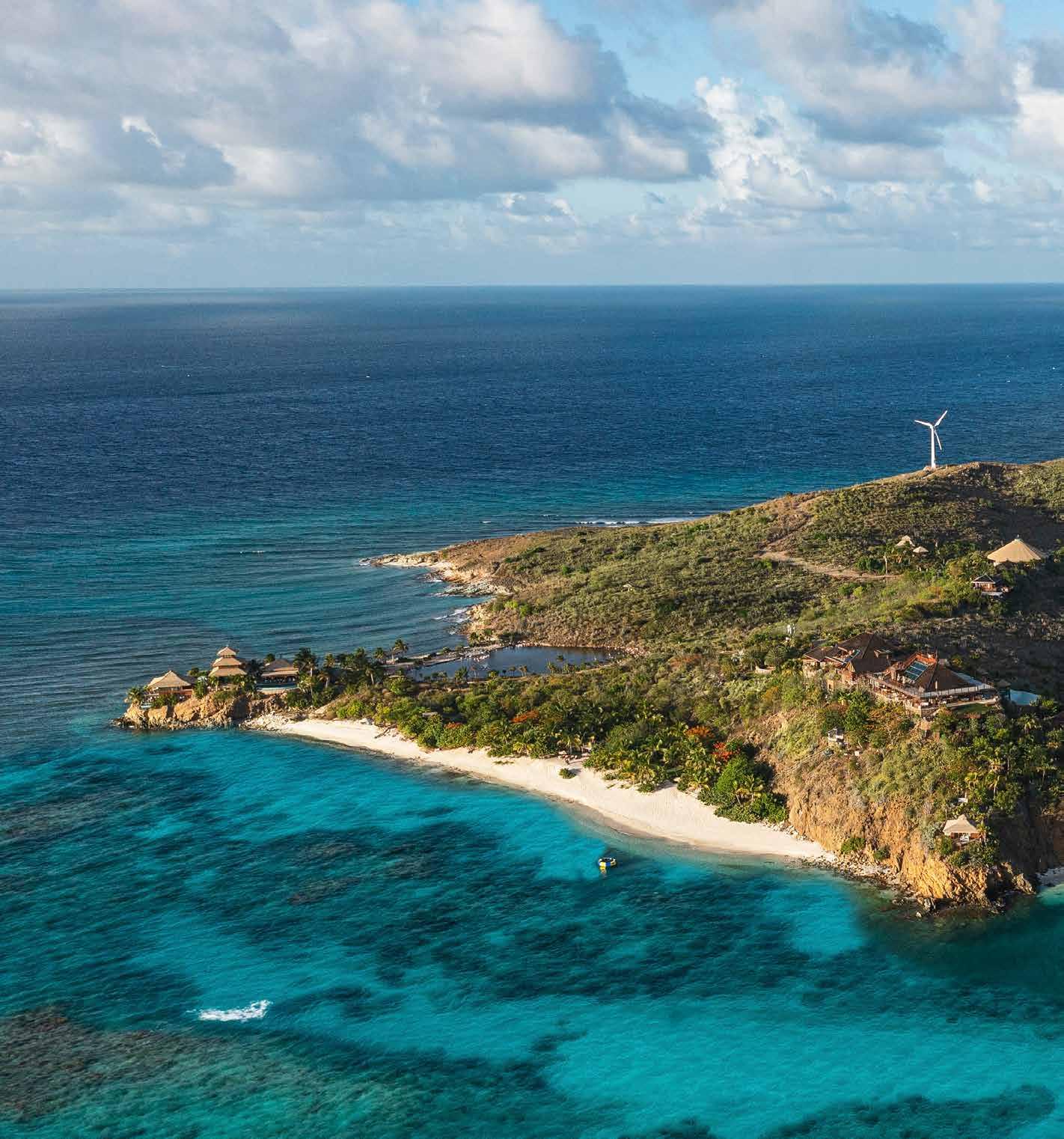
Sir Richard Branson’s Necker Island shows how a private island resort can become a beacon of impactful regenerative travel
Words: Lauren Jade Hill
Ilean forward from my position at the back of the tandem kayak to get a hold of the thick branches bending in towards us each side of a small passageway leading through dense mangrove. With my paddling partner pulling at the same time, we leverage our kayak over a web of branches growing just above the water’s surface beneath us, leaning back to slide beneath the low branches overhead.
We’re navigating a path that connects two open areas of sheltered pools at the heart of a great expanse of coastal mangrove as we follow a channel through this thick wilderness of the Hans Creek lagoon. Reached by paddling along the windswept coastline from a small, secluded bay, this wilderness lies on the edge of Beef Island, to the east of Tortola in the British Virgin Islands, which is the archipelago that Sir Richard Branson’s private paradise, Necker
Island, also calls home.
The ecological importance of mangrove ecosystems cannot be underestimated. These marine forests are thought to sequester carbon at 10-times the rate of mature tropical forests. Their ecosystems provide the habitat for a wealth of wildlife, acting as a nursery for juvenile marine species and, of particular significance for this part of the world, these mangrove systems also protect coastlines from extreme weather conditions.
Much of the mangrove in the British Virgin islands was destroyed by Hurricane Irma but, thanks to vital mangrove restoration efforts, this area of submerged coastal forest is once again thriving.
On a kayaking expedition with the local ecooperator GroundSea Adventures BVI, insight is given into the environmental importance of these mangrove systems with the chance to also plant mangrove propagules (or seedlings) and
play a small part in its ongoing regeneration. This tourism initiative is supported by the non-profit Unite BVI Foundation, which was founded by Virgin Limited Edition and Virgin Unite in 2016. As of 2024, Necker Island is now offering guests the chance to join this mangrove conservation tour because, while Necker may be best known for sheer unbridled luxury, this private island retreat is also a leader in regenerative tourism.
The creator of this island paradise, who has made Necker Island his home, is Sir Richard Branson – the billionaire British business magnate and founder of the Virgin empire who first set about making this exclusive retreat a wildlife haven in 2005. A flock of flamingos, once native to the British Virgin Islands but hunted to extinction, was introduced to the island the following year, and a stream of species have made their arrival in the years since. »

The 74-acre island is now home to 140 different species, including seven types of lemurs, birdlife such as the scarlet ibis, Anegada rock iguanas and Aldabra giant tortoises. Turtles hatch on the island’s sandy shores and, when 12 tortoise hatchlings were born on the island in 2021, they became the first Aldabra giant tortoises to be bred naturally outside of the Seychelles. A flock of 44 flamingos that was introduced to the island has now grown to number around 630 birds today. The biodiverse environment, also home to smaller creatures like the Anegada Calisto butterfly and plant-life such as mangrove, is then surrounded by the marine-life rich waters of the British Virgin Islands.
A dedicated wildlife and conservation team manages this biodiverse environment, which also integrates enough solar panels and wind turbines to provide almost 100% of the island resort’s energy. An extensive recycling programme, the reduction of food miles, and the collection and repurposing of water for irrigation add to the island’s environmental efforts. Guided walks around the island introduce you to these initiatives and the abundance of wildlife.
“What we’ve tried to do with Necker is set an example that shows what can be done,” says Sir Richard, as we discuss the impact of the island. “If you can get yourself into a position where you can make a difference, you shouldn’t waste that opportunity. I think the difference you make is really important, and it’s about the big things you do – like our planetary guardianship programmes – but also the smaller things you do for individual people.”
Richard’s ethos is epitomised by the efforts of Unite BVI Foundation in particular, which makes a difference through a multitude of projects spanning environmental conservation, community enrichment and empowering local entrepreneurs.
On Necker Island, this care for the environment and community comes hand in hand with the
hedonistic resort experience, which pairs barefoot luxury with a lot of fun. While staying in one of nine Balinese-style houses, with either shared or private pools and far-reaching ocean views, days are spent as slowly or as high-energy as you feel. A day here could be spent unwinding on one of the sandy beaches, in the spa and by the main pool with a glass of champagne or making the most of the many water- and land-based activities on offer.
Kite surf, snorkel with turtles, and join a Hobie race around the island, take to the tennis, padel and pickleball courts, and hike the island’s undulating trails.
As well as the newly offered mangrove conservation tour, off island excursions then include visits to the famous Baths of nearby Virgin Gorda, and laidback cruises around the surrounding islands with a stop-off at one of the local beach bars. As such an exclusive island hideaway, every aspect of a stay, from how you spend your time to the food and drink, is tailored to you.
The social atmosphere between everyone on the island extends to Necker’s signature sushiladen kayak lunches in the beachside pool and the island’s legendary white parties where everyone is encouraged to dance the night away on the long wooden table of the Great House.
Since Richard also makes his home here, you’ll often find the billionaire entrepreneur joining you for a celebratory drink, meal on the beach or game of pickleball.
“I love people,” he says. “So to be able to socialise, interact and have so many wonderful discussions is something I thoroughly enjoy.”
However you decide to spend your time on the island, each day comes with a glimpse into the many initiatives demonstrating just how luxury tourism at its best can have such a positive impact on the surroundings.
virginlimitededition.com
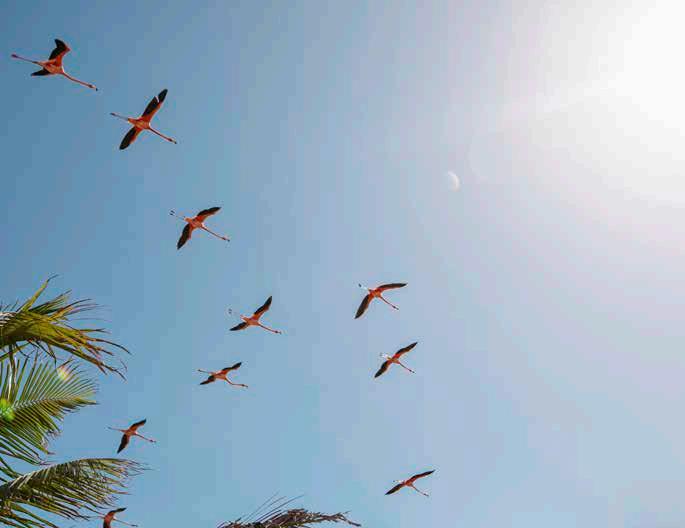


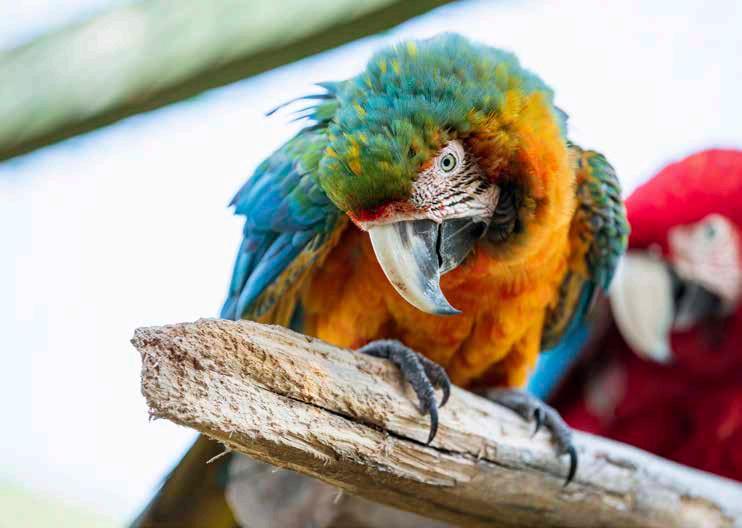





IF YOU CAN GET TO A POSITION WHERE YOU CAN MAKE A DIFFERENCE, YOU SHOULDN’T WASTE THAT OPPORTUNITY... THE DIFFERENCE YOU MAKE IS REALLY IMPORTANT
– Sir Richard Branson
A paradise getaway takes on a whole new meaning when you add a secluded island into the mix. No matter what corner of the world you’re in, these private island resorts are the epitome of exclusivity and tranquil luxury – for you and your guests
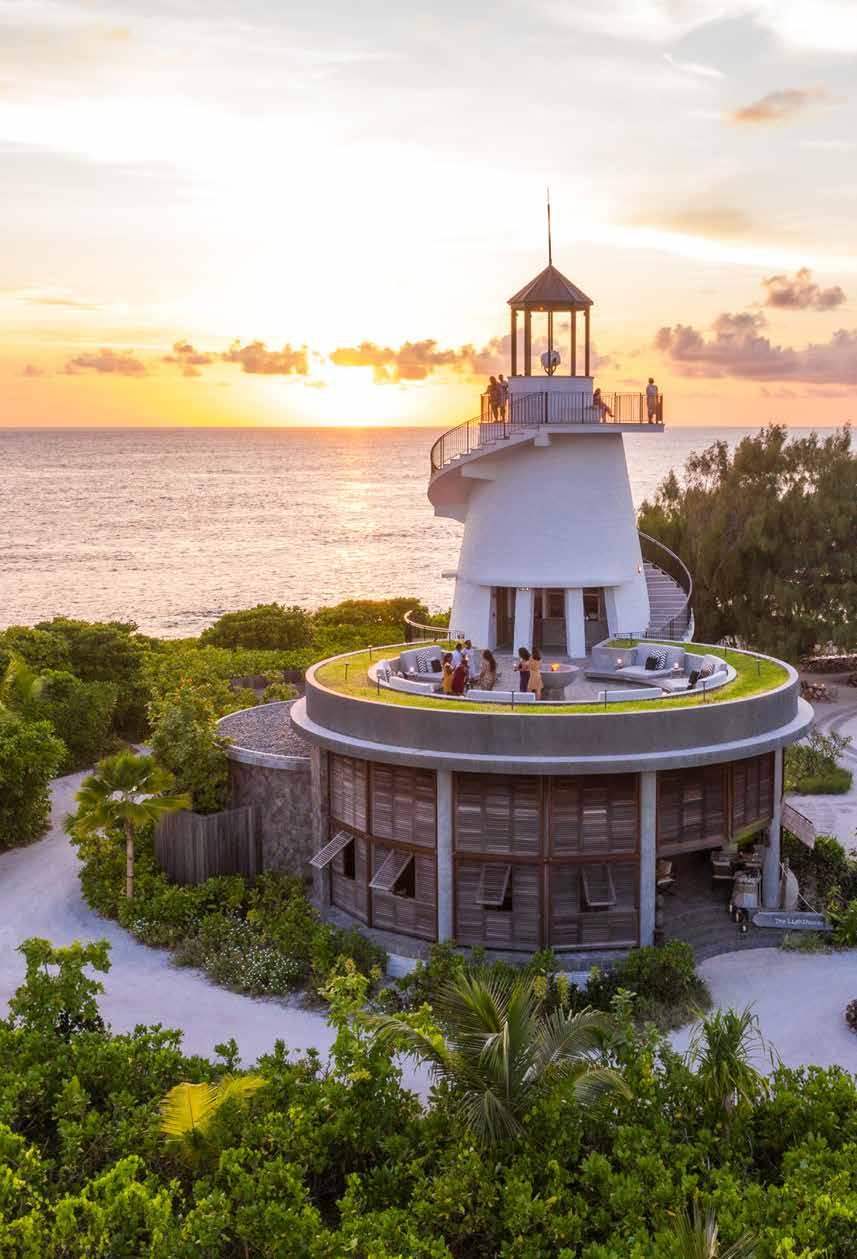

Turks and Caicos is filled with its share of glorious getaways and luxurious resorts, but the 1,000-acre tropical hideaway of Como Parrot Cay (left) is a cut above the rest. This gorgeous hideaway (on an island only accessible by boat) is filled with secluded coves, pristine beaches and unspoilt reefs. Accommodations range from ocean-facing rooms to beach houses – as well as six celebrity-owned private beachfront estates that can be rented for ultimate privacy. Guests can enjoy sports like diving, windsurfing, kayaking, paddleboarding and sailing, or luxuriate at the Como Shambhala Retreat Spa, which offers Ayurvedic therapies, meditation, yoga and pilates. The resort also provides the option of a vitamin-rich, cleaneating menu at all restaurants. comohotels.com


This luxurious private island resort in Seychelles is known as one of the most beautiful and unspoilt islands in the world. Situated on the beautiful Amirante Island, Desroches has over 14km of beautiful sandy beaches and abundant coral and marine life. Guests can explore the coastline and participate in various activities including deep-sea fishing, tortoise feeding, and even yoga on the runway. Or, if you want to take tranquillity in its literal sense, feel free to lounge around in a private pool and unwind at the hotel’s state-of-the-art spa. With seven villas, two suites and four residences to choose from, this is far-flung calm at its best.
fourseasons.com
Miavana is an ultra-luxury resort comprising 14 private lodges across Nosy Ankao island, off north-east Madagascar. The location boasts wild beaches, diving, fishing, turtle, whale and dolphin watching, helicopter adventures and spa treatments, and guests can also choose to head into the forest for guided nature walks and lemur spotting. Designed by awardwinning architects Silvo Rech and Lesley Carstens, this resort has stunning beachfront villas with direct access to the beach and alluring Indian Ocean. And it is the perfect place to soak in the salty ocean air and colourful sunsets as the sun sinks into the vast waters ahead, safe in the knowledge that this sustainable and responsible island resort is preserving a slice of paradise.
miavana.com
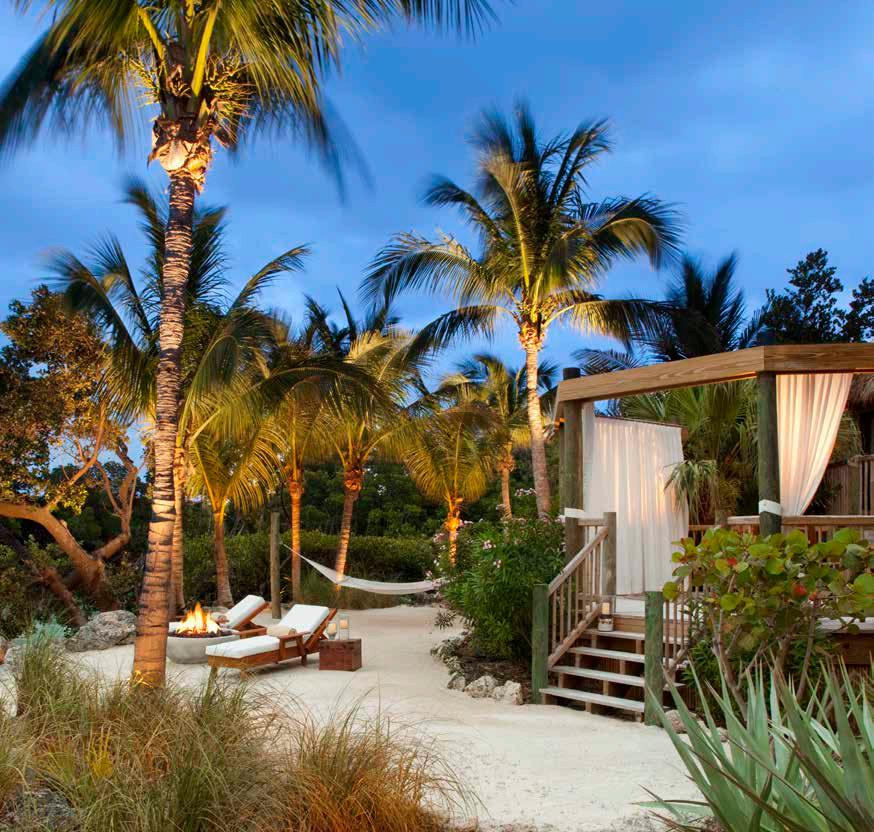
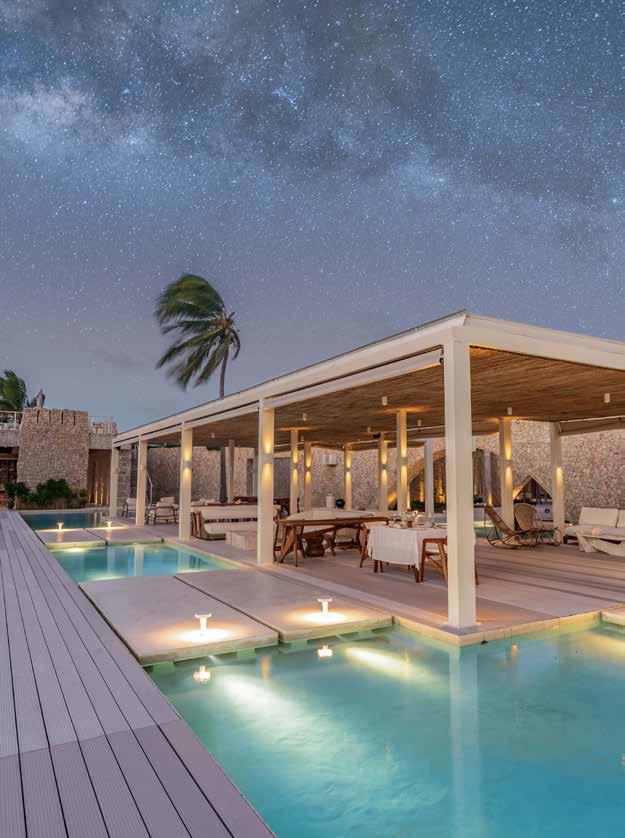
America’s only private island resort is an adultsonly getaway offering 30 thatched-roof bungalow suites (left) across a four-acre island in Florida. With a strict cap of 60 guests, it is as private as it gets on American soil, with all suites having water views, outdoor showers, and furnished decks. Meanwhile, the white sand beach is kitted out with hammocks, loungers and fire pits. Paddleboard or kayak through the eagle ray-filled mangrove mazes or enjoy a lazy day lounging by the sea with a piña colada in hand. And, if you’re one for reef conservation, consider a snorkelling trip to Looe Key Reef, which is part of the third-largest living coral reef in the world – and the site of ongoing reef restoration efforts by MOTE Marine Laboratory & Aquarium, a Florida-based independent, nonprofit marine research institution.
littlepalmisland.com
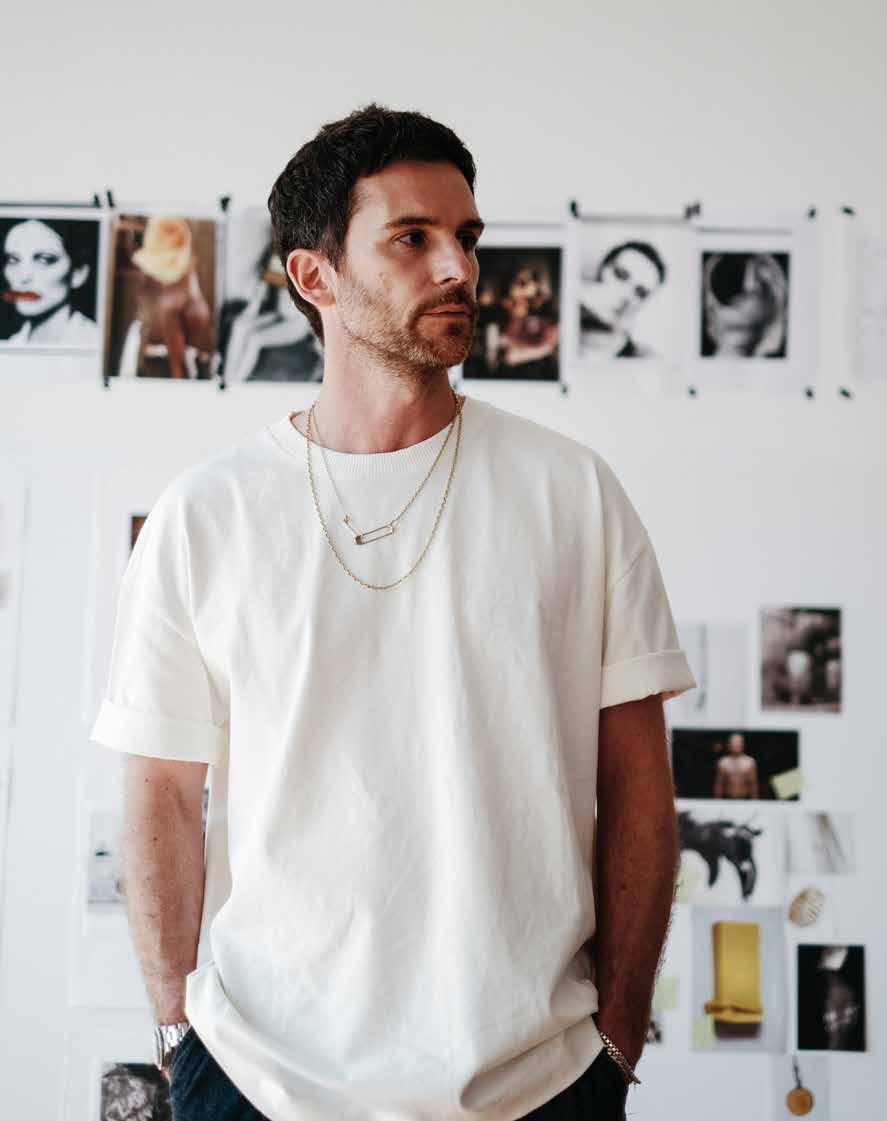
How Coldplay bassist and Applied Arts Forms founder Guy Berryman turned his passion for 1950s style into a trailblazing fashion brand
Words: Michelle Johnson
In a world of fast fashion, Applied Art Forms is unique in more ways than one. Taking inspiration from archival pieces including vintage military and workwear, industrial material such as reclaimed parachutes, and Japanese fashion of the 1950s, Guy Berryman’s own style infuses every beautifully structured piece in the brand’s capsule collection.
Founder and designer Guy, 46, who is best known as the bassist of British phenomenon Coldplay, launched Applied Art Forms in 2020 – two decades after the band’s breakthrough debut album Parachutes topped global charts. The fashion line was, in many ways, Guy going back to his roots.
“I always loved music, but I was super passionate about design and manufacture, and studied mechanical engineering and architecture,” says Guy (left). “I decided to reengage with that
[passion] in 2017. I was turning 40, and I got to a point where I was sort of reflective. That’s the age where you can actually stop for a moment and look back, and then look to the future and go: ‘Right, what has to happen now?’
“I realised that I wanted to design and make things in the physical world, rather than just create music, which is very different. I wanted to make something that had an impact on my eyes, hands and body.”
Guy’s return to tactile and tangible creation is no surprise given his heritage. Born in Kirkcaldy, Fife, to father Rupert – an engineer who was part of the Channel Tunnel creation – and mother Elizabeth, whose family were merchants and factory-owners in the area, there is an industrial spirit that seems to run through the family.
Applied Art Forms – which has created gender-neutral garments since 2023 and
recently launched a unisex jewellery collection with Hannah Martin – is perhaps best known for its core collection of impeccably-made utilitarian pieces. Most of these are inspired by the artist’s own enviable collection of vintage clothing and accessories picked up on his travels – known as ‘the archive’ – and which, he says “has informed everything we’ve done”.
“I’m a collector of all kinds of things,” says Guy, who counts vintage watches, classic cars and mid-century furniture among his interests.
“I’m like a magpie. After so long travelling the world, I’ve been collecting vintage garments –workwear, denims, nylon flight jackets. If I go to a city, I don’t shop at Prada: I go straight to junk shops, flea markets, charity shops. I like to collect things that have age and history to them. I like going to a city and finding that one treasure that no one else appreciates or understands.” »
This extensive archive serves as the basis for all Applied Art Forms’ designs, says Guy, explaining how he combines aspects of interesting pieces – the silhouette, the fabric, design details like pockets – to form a cohesive new style, which is then produced in line with the brand’s rejection of fast fashion and mass production.
“I just love the history and the heritage of fabrics of construction,” he says. “We do try and make things using traditional techniques where possible because quite often they were much better quality than what we have today. I like things that are handmade or made on kind of vintage machinery – I like things that took a long time to make.
“A lot of the garments I collect are from the 1940s, 1950s and 1960s, and it was all so well made – especially the utilitarian stuff. If you buy military surplus today from the ’90s or ’00s, it’s just absolute garbage. It’s not going to be of interest to any collector.
“Ultimately, I’m just a nerd,” he laughs. “I drive myself nuts because I spend a disproportionate amount of time on things that nobody will ever appreciate or understand, so I do have to reel myself at times.”
This attention to small details certainly shines through as we talk about the challenges of the production method, and Guy illustrates the sheer depth of thought that goes into each aspect of a garment – even something as everyday as a sturdy buttonhole.
“We face production challenges all the time,” he says. “Making clothes, to be honest, is a nightmare. It really is brutal and the only way to navigate the waters is to be completely passionate about what you’re doing, and let that passion keep you from drowning. Most people, frankly, don’t have the stomach to make a fashion label survive.”
Guy likens his personal style to Japanese street style, featuring balloon trousers and strong silhouettes – and a multitude of jackets. In fact, Guy says his archive is 85% jackets, with trousers and outerwear filling the gaps – a trend that’s echoed in the brand’s statement pieces. “I feel that’s where you have the most opportunity to add technical details and really play with strong silhouettes,” he says.
“I like playing around with the shape of trousers but, for me, it’s all about jackets and outerwear. That’s why I find the spring/summer collections hard – although we do still produce outerwear [for spring/summer], much to the annoyance of my team,” he laughs. “Look, I’m not going to launch a collection with just a graphic T-shirt – it doesn’t satisfy my soul remotely.”

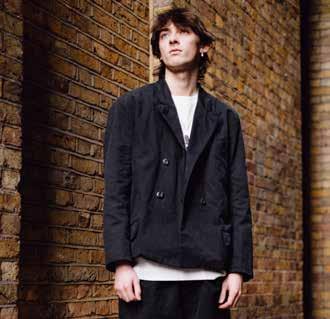
Playing it cool: Guy Berryman’s (top right and previous) personal archive inspires Applied Art Forms collections (this page)
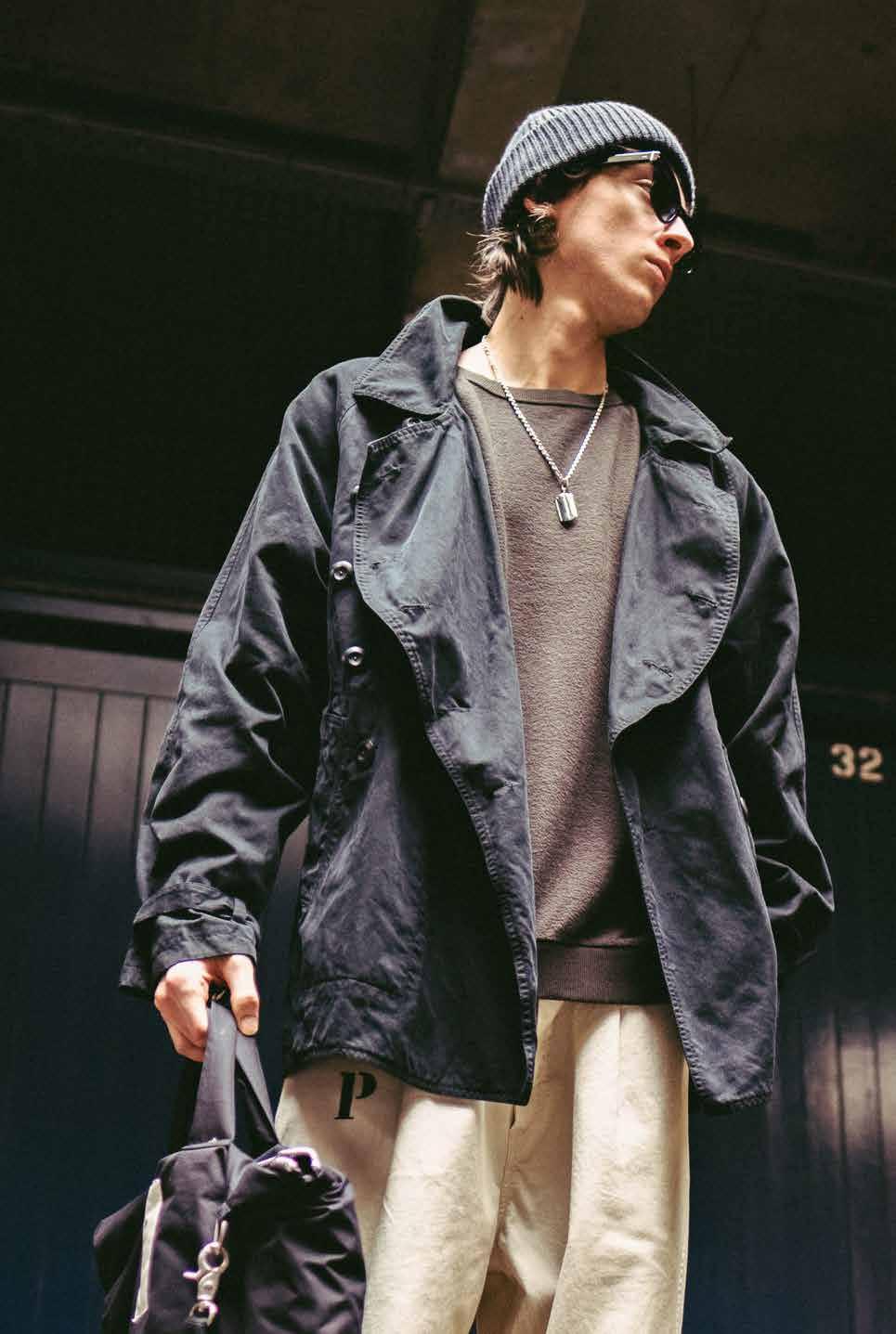
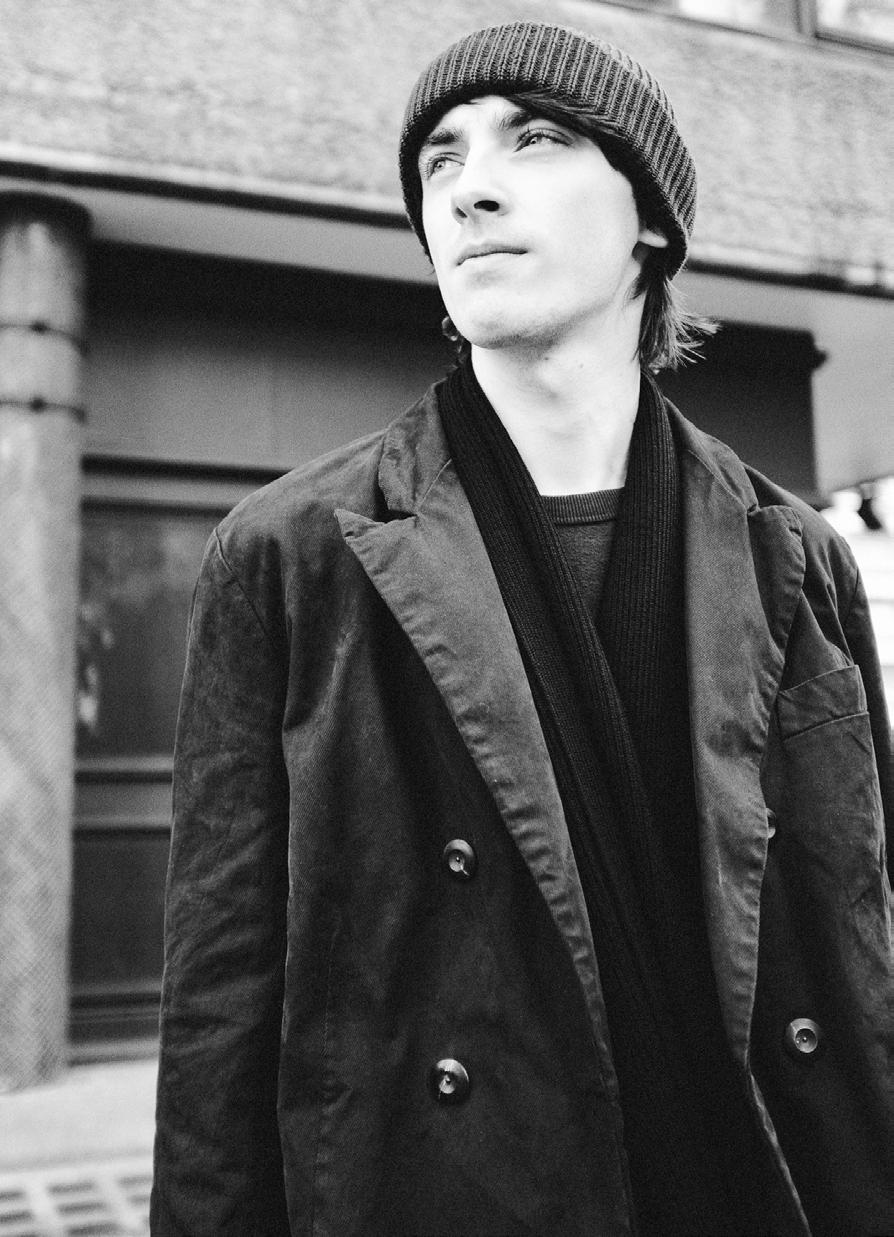
MAKING CLOTHES IS BRUTAL... THE ONLY WAY TO NAVIGATE THE WATERS IS TO BE COMPLETELY PASSIONATE ABOUT WHAT YOU’RE DOING

Guy is currently working on the autumn/ winter 2025 collection at the brand’s studio in Amsterdam, where he now lives with his partner, Keshia Gerrit (“I’m still getting used to the bikes,” he laughs. “I mean, it is a bit lawless, but it’s the best city for living in.”). That is, when he’s not on tour with his Coldplay bandmembers – singer Chris Martin, guitarist Jonny Buckland and drummer Will Champion. Together, the band has sold more than 100 million records worldwide, and earned nine Brit Awards, seven Grammys and an Ivor Novello.
“We’re enjoying the tour,” he says. “With music, the band bounces ideas off each other, and it’s similar with [Applied Art Forms]. It’s important for me to be collaborative – you always get a better result when you’ve got other people contributing to the end product.
“But it’s also nice to use a completely different part of my brain and make something very different to music. I think that’s really healthy and makes me a better person when I step back into the band,” says Guy, reflecting on the nine studio albums released by Coldplay since the band formed in 1997. “I feel like it’s an important process, for me, creatively, and it makes me a better musician when I do step back into the recording studio, because I’ve got this creative outlet elsewhere. I don’t feel like I’m always fighting for my ideas or trying to be too controlling in the studios.”
And with Coldplay’s tour expected to stretch into 2025, Guy has plenty of cities in which to expand his archive – ready to inspire future Applied Art Forms collections.
appliedartforms.com
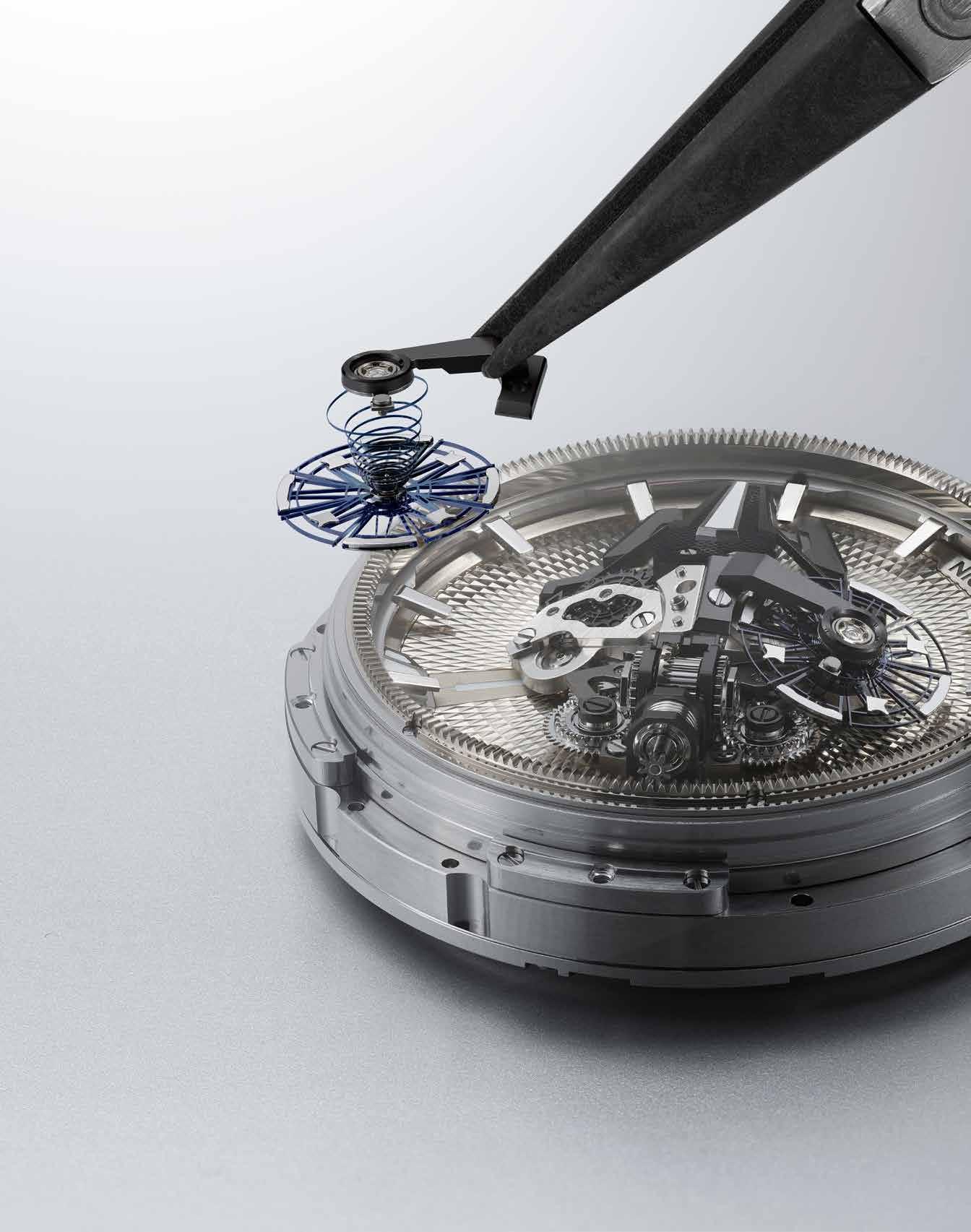
As Watches & Wonders dominates the watch calendar for another year of innovation, we reflect on the world’s most extraordinary haute horology
Each year, the great and good of the horological world gather at Geneva’s Palexpo exhibition centre, for the industry’s largest and arguably most important watch fair: Watches & Wonders. Manufacturers rub shoulders with celebrity ambassadors, billionaire buyers, international distributors –and, of course, editors from the luxury and watch media – all eager to see the next mechanical marvel to grace our wishlists and, for the lucky few, physical collections.
The show, which took place from 9-15 April, is a world unto itself. One’s morning begins with tours of the astounding brand pavilions that line the halls of the exhibition centre before enjoying a few fascinating industry presentations and designer talks. Inside the centre, the hours bleed seamlessly into ‘touch and feel’ sessions that allow you to get up close and personal with new launches and novelties, before cocktail hour comes calling – with many watch brands serving up some timely treats. In the evenings, Geneva is awash with VIP dinners, store parties and brand activations, with the whole city seemingly primed to celebrate its famed watchmaking heritage.
But away from the glamour and ceremony lies the stars of the show: the watches. With 54 brands present at the event, there were plenty of themes emerging from this year’s showcase. Women’s watches took centre stage, with brands including Chopard, Cartier and Parmigiani Fleurier all introducing smaller timepieces aimed at a female or gender-neutral market; Piaget and Bulgari entered the battle for great innovators as they presented their thinnest ever tourbillon watches and Ulysse Nardin (pictured) continued its campaign against traditional dials; and sustainability remained an industry touchpoint, from TAG Heuer’s lab-grown diamond innovations to Montblanc’s upcycled 1858 Geosphere 0 Oxygen CARBO2.
As the Shanghai edition of the watch fair prepares to open on 28 August, we return to some of our favourite moments from the fair.
Maison Cartier presented novelties from across its impressive range this year – including its Privé, Animal Jewellery Watches and Reflection de Cartier collections – but we’ve chosen this fascinating tribute to aviator Alberto Santos-Dumont (right), which challenges how we traditionally tell the time with its reversed movement, presented in platinum and carnelian dial. Unique, elegant and whimsical. cartier.com
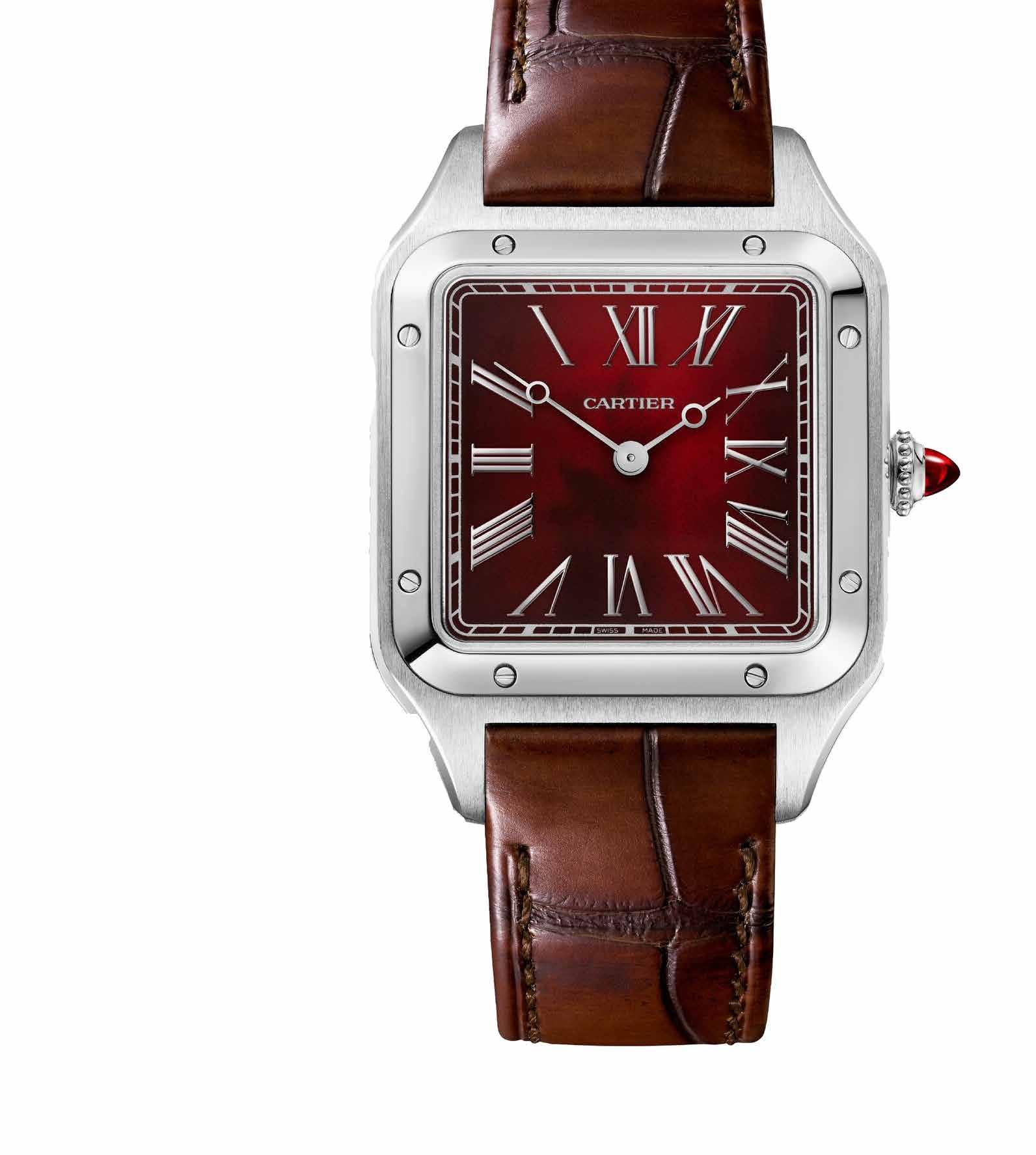
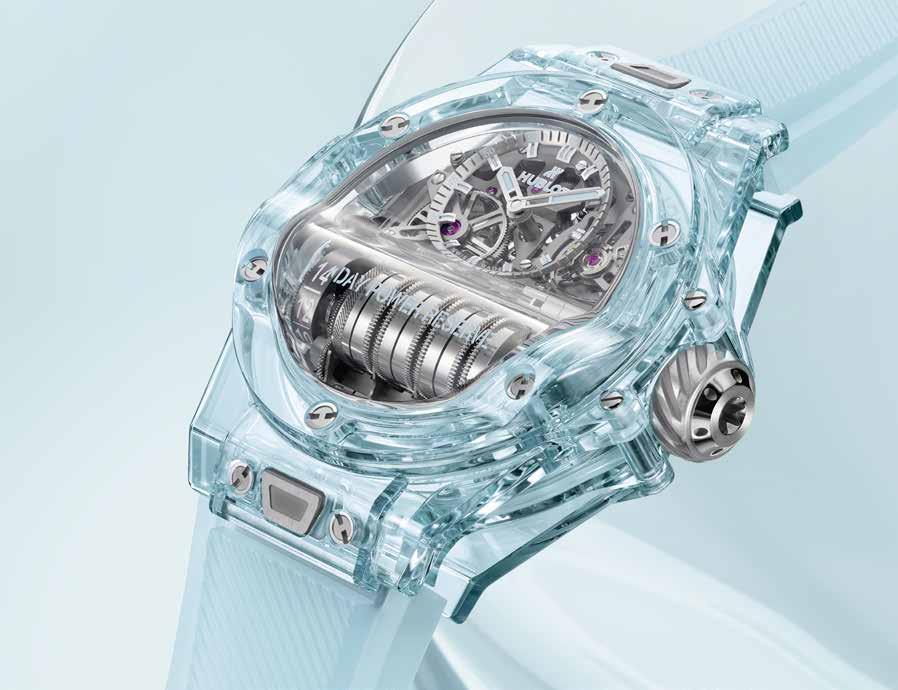
HUBLOT | BIG BANG MP-11 14-DAY POWER RESERVE WATER BLUE SAPPHIRE
This fresh interpretation of the MP-11 presents a new sapphire tone for Hublot (left), while maintaining its unique seven barrels and 14-day power reserve, all powered by the HUB9011 calibre. The new Water Blue tone is based on an exclusive custom chemical formula and unique transparency index, to present a luminous and durable timepiece. » hublot.com
HELIOTOURBILLON PERPETUAL
In a first for the masterful watchmaker, JaegerLeCoultre Duometre Heliotourbillon Perpertual (right) features a new tourbillon construction that spins on three axes, creating a ‘spinning top’ effect beating at a frequency of 4Hz to defy gravity at any position of the wrist. Featuring an integrated perpetual calendar with grande date display, pink gold case and silver opaline front dial this innovative watch is a sight to behold. Jaeger-lecoultre.com


PANERAI | SUBMERSIBLE TOURBILLON GMT LUNA ROSSA EXPERIENCE EDITION
A tribute to the Luna Rossa Prada Pirelli sailing team, this striking skeletonised submersible (left) is finished in the team’s red and black colours. The limited edition watch features a 45mm Carbotech case housing complications including a visible tourbillon. Water resistant up to 300m, buyers will also receive an invite to the Americas Cup finals with the Luna Rossa team. panerai.com
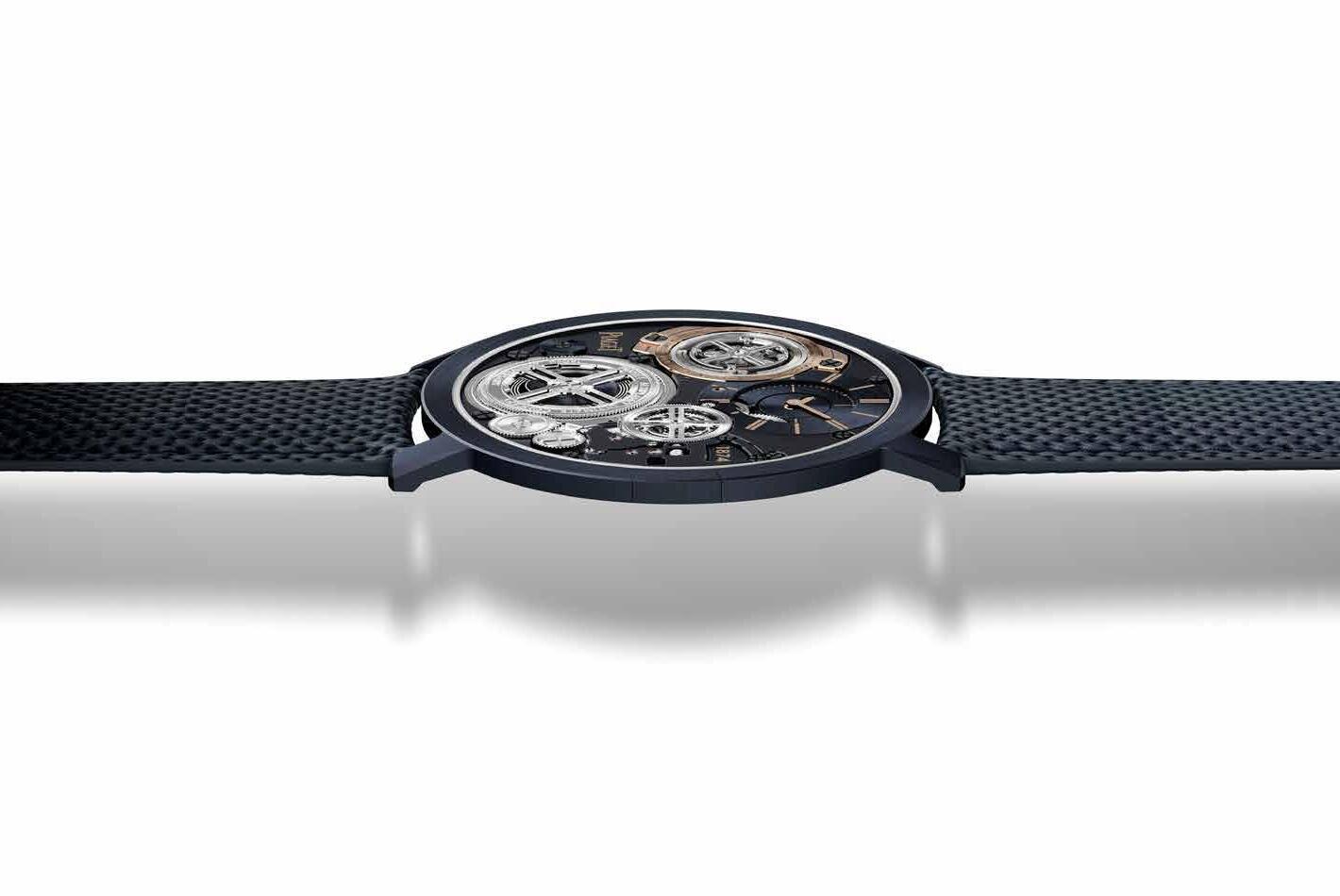

Piaget celebrates its 150th anniversary in innovative style with the Altiplano Ultimate Concept Tourbillon (right and below). The 41.5mm watch is powered by Piaget’s ultrathin calibre for a timepiece that is just 2mm thick. Pushing its technical brilliance even further this year’s skeletonised novelty houses a beautiful flying tourbillon at 10 o’clock – a feat that took Piaget redesigning 90% of its predecessor to handle the 25% more power required for a tourbillon while keeping it to the miniscule size and thickness.


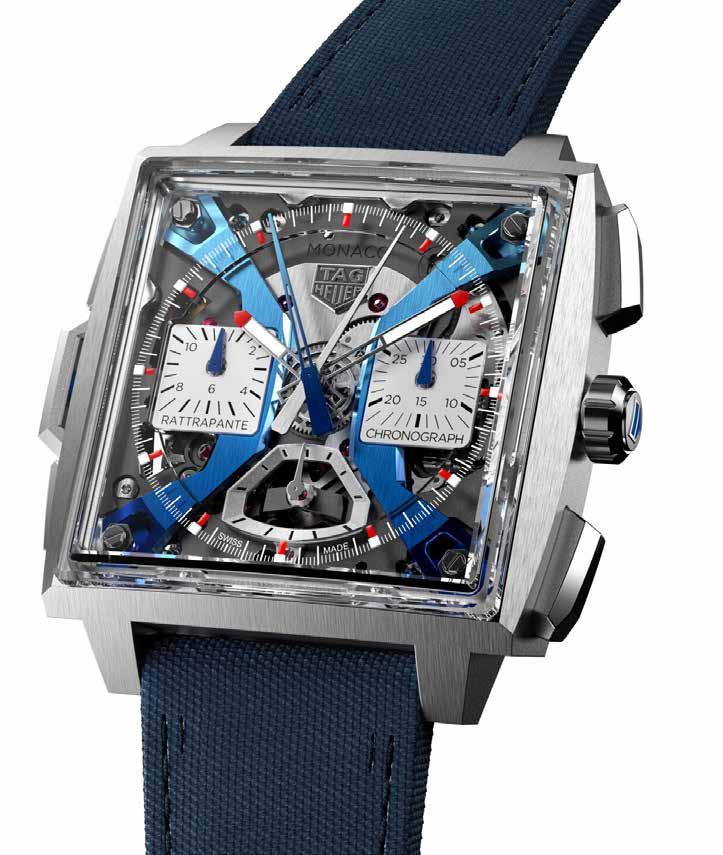

Ulysse Nardin continues to break the rules of watchmaking with the outof-this-world Freak S Nomad (above). Like last year’s Freak X, the 99-piece limited edition eschews such trifles as hands, dial and crown in favour of the watchmaker’s Calibre UN-251 Manufacture movement — a spaceship-like flying carousel rotating around its axis — encased in 45mm of titanium. Time is indicated by the movement as it circumnavigates the CVD-plated hour disc, which is finished with guilloché — produced using a rare 18th-century rose engine, painstakingly turned by hand in one continuous movement. ulysse-nardin.com
In part two of our look behind the scenes of Louis Vuitton’s watchmaking revolution, Tempus visits La Fabrique du Temps to discover the brand’s new Escale collection
Ten years after the first Louis Vuitton Escale watch was released, the landscape of the fashion maison’s horology manufacture is near unrecognisable. Today, master watchmaker Michel Navas’ La Fabrique du Temps is a strong contender for the world’s best-looking watch manufactory: clean, serene and stylish thanks to the bright, modern architecture and thoughtful Louis Vuitton décor, exuding sumptuous elegance from the cocoon chairs that hang from the lobby ceiling to the artwork brightening the manufactory walls.
It’s not just the building, located less than an hour from Geneva city centre, that radiates this elevated style, however – as showcased by the manufactory’s new Escale collection. With the appointment of Jean Arnault in 2021, as Louis Vuitton’s director of watches development, the brand’s master watchmakers and engineers have been given carte blanche to push the limits of their enviable ability – and challenge the watch industry itself.
Previously known for its highly regarded fashion watches, Louis Vuitton Watches’ recent creations have demonstrated the manufactory’s impressive skill with bespoke client creations and animated watches – such as the 2021 GPHG-winning Tambour Carpe Diem. And today’s new releases are making a clear statement.
Focusing on creating the highest quality of Swiss watch manufacture at limited numbers, the maison is able to push the limits of elegance and excellence in its core collections. Last year’s new and improved Tambour release in precious metals was followed earlier this year by the Escale Cabinet of Wonders –three métiers d’arts pieces that showcased the serious skills of the brand’s Métiers d’Art team, led by director Dick Steenman and inspired by Gaston-Louis Vuitton’s historic collection of samurai artifacts.
Now, Louis Vuitton has released a new take on the core Escale collection that perfectly combines haute horology and the brand’s storied 170-year history of travel cases, with bold colours, tactile surfaces and sophisticated finishes to delight the wearer. »

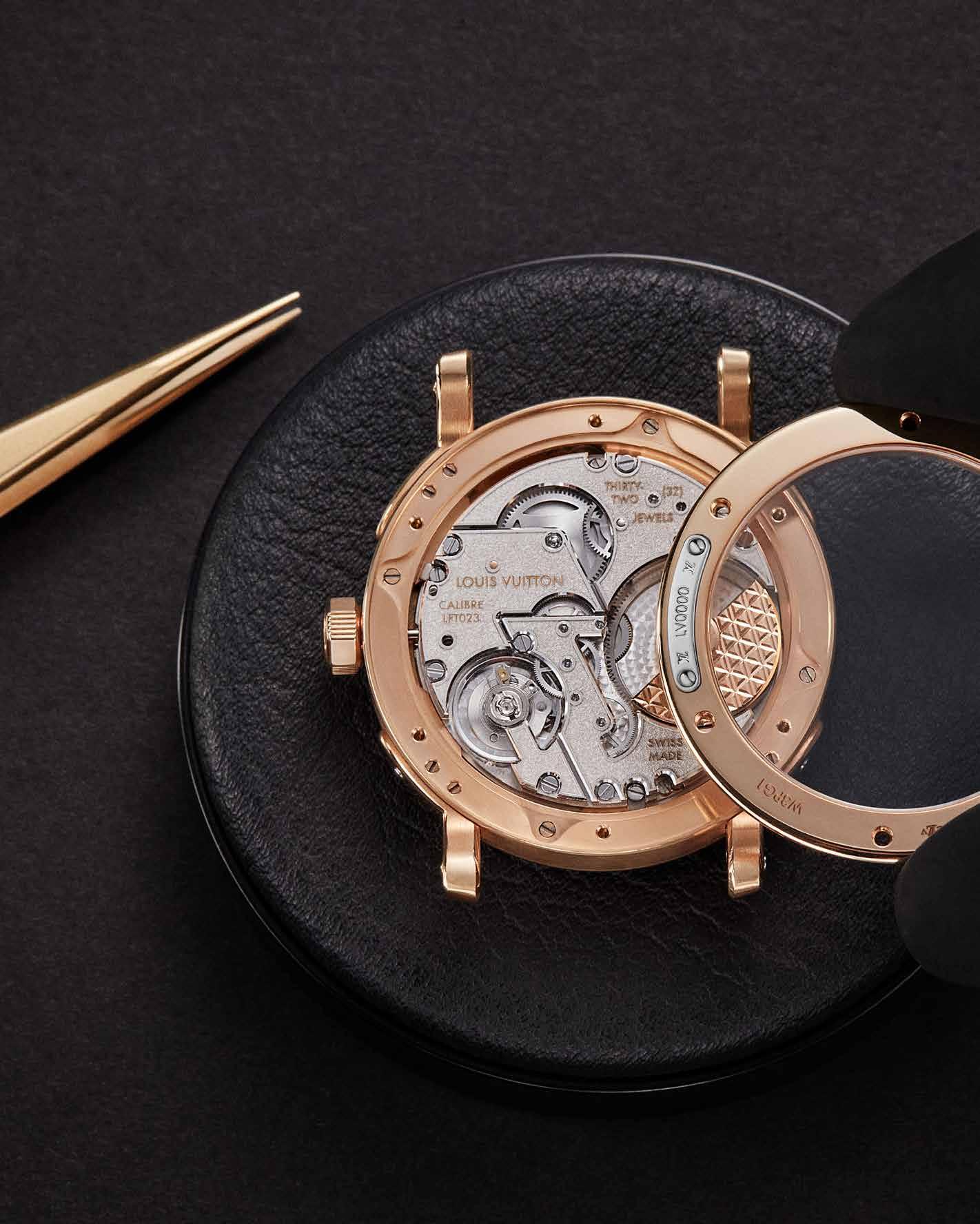

Métier d’Arts: The Louis Vuitton Escale collection includes four expressions: (this page) rose gold with silvery dial or blue dial, diamond-set platinum with onyz dial, and (next page) platinum with meteorite dial
The latest Escale collection introduces four sophisticated time-only watches, two in rose gold with textured dials and two in platinum with precious stones. Inspired by Louis Vuitton’s origins as a maker of luxury travel bags and trunks – Louis was the first to create rectangular trunks that could be easily stowed away on ships and trains – the watch design is awash with historic references, from colourways and materials inspired by exterior and interior linings to markers shaped like the metal features that reinforce the exterior of each trunk.
“Escale is synonymous with the art of travel, the philosophy that lies at the heart of Louis Vuitton,” the brand said in a statement. “When travel transcends its utilitarian purpose and opens the way to self-discovery, destination is secondary and the journey itself rises primacy. An escale is more than just another stopover evokes the imagination and the memory of a moment that lingers in the mind; it captures the essence

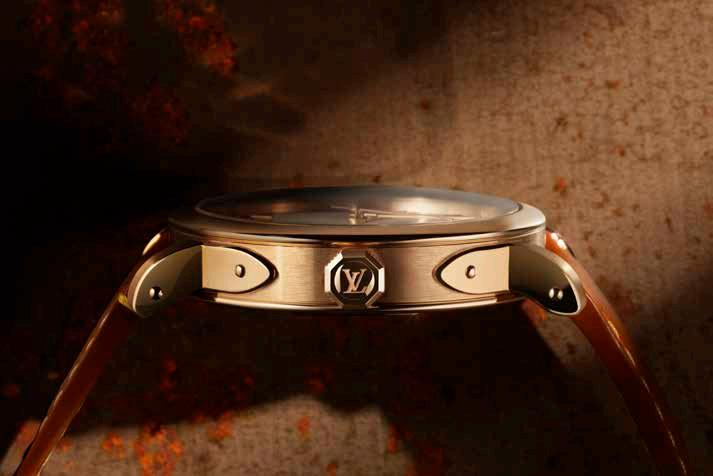
Each timepiece in the impressive collection shares core similarities. The 39mm time-only watches are all powered by Louis Vuitton’s in-house LFT023 – a selfwinding mechanical movement that boasts a 50-hour power reserve and is a high-precision chronometer certified by the Geneva Chronometric Observatory. Interestingly, this movement was first introduced in the 2023 Tambour models, and is the first proprietary automatic three-hand movement designed by La Fabrique du Temps in collaboration with movement specialists Le Cercle des Horlogers.
Aesthetically, each references the timeless Louis Vuitton trunks in subtle but deeply satisfying motifs – the octagonal crown is topped with a trunk rivet adorned by the Louis Vuitton monogram, the hour hands are designed as finely tapered needles used in Paris leather ateliers and, most beautiful of all, the quarter hour markers are shaped like the instantly-recognisable bracket lugs that adorn each trunk, holding the central dial in place just as they hold the structure of the iconic courrier lozine. The dial is further decorated with gold studs, which emulate the nails that run along the trunk’s exterior. »
REFERENCES THE TIMELESS LOUIS VUITTON TRUNKS IN SUBTLE BUT DEEPLY SATISFYING MOTIFS
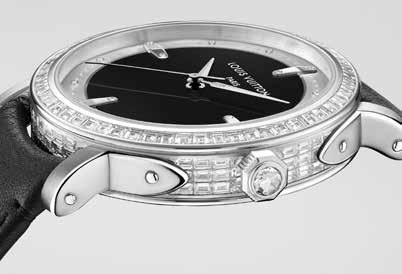
With the structure so perfectly defined, La Fabrique du Temps was able to play with untold materials and fabrics to pay homage to almost two centuries of design. The Louis Vuitton Escale in Rose Gold, Silvery Dial features an 18-carat rose gold case, bezel, lugs, hands and indexes, with a silvery stamped centre dial and satinfinished tilted flange. Its VVT camel calf leather strap is a sophisticated nod to the brand’s classic colourway with its characteristic yellow stitching. Similarly, the Escale in Rose Gold, Blue Dial features the same case specifications – including open case-back in white gold and water resistance up to 50m – but with a bold blue stamped centre dial and silvery satin-finished tilted flange. Both dials showcase a new dial texture, inspired by the finely grained surfaces of the Louis Vuitton Monogram canvas. The watchmakers developed custom dial stamps to perfectly reflect the tactile experience of canvas on the metal dial.
In the platinum expressions, the Escale Platinum, Meteorite Dial further showcases La Fabrique du Temps’ exceptional range – and mastery – of material. Indeed, the Métiers d’Art department is full of precious metals, gems and other materials – including a significant fragment of a meteorite that Dick has displayed in pride of place.
With bezel, case and lugs all in platinum, and 18ct white gold hours and indexes, the extraordinary patterns of the Gibeon Meteorite, from Namibia, take centre-stage on the dial. As the dial is made from a single slice of precious stone, each watch is entirely unique. The elevated monochrome effect is finished with a refined black calf leather strap.
Finally, the Escale Platinum set with baguette-cut diamonds sees the platinum edition adorned with 189 baguette-cut and brilliant-cut diamonds – 161 on the bezel alone – for a total of 6.41cts. The dial is cast in precious onyx, also from the Métiers d’Art team’s expansive collection, and finished with a black calf leather strap.
Turn each watch over and the open case-back allows a glimpse inside to where the calibre’s 147 components, 32 jewels and 22ct rose gold microrotor power the watch at 28,800 vibrations every hour – as well as glimpses of the continued artistry of Louis Vuitton watches, in the engravings and decorations that reference some of the brand’s best-known designs in a collection designed to celebrate the art of travel.
After all, as American essayist Robert Waldo Emerson famously said: “It’s not the destination – it’s the journey.”
louisvuitton.com
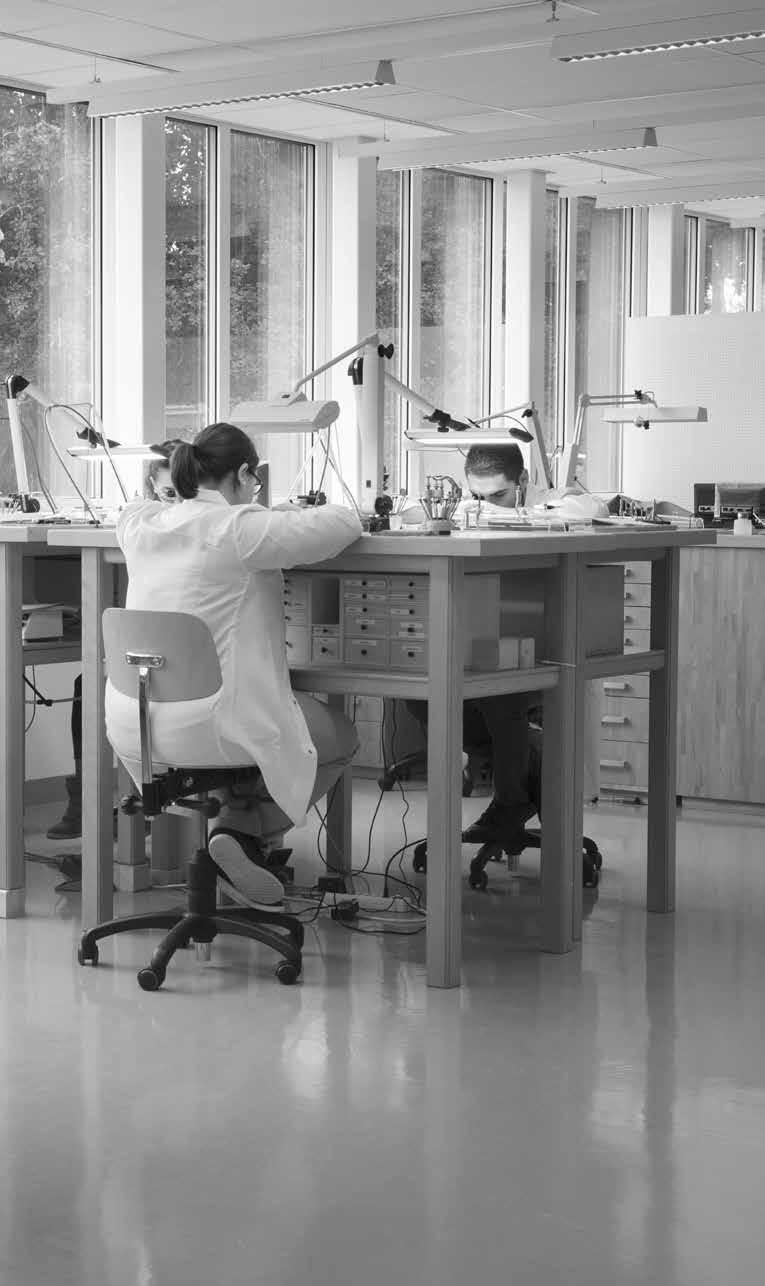

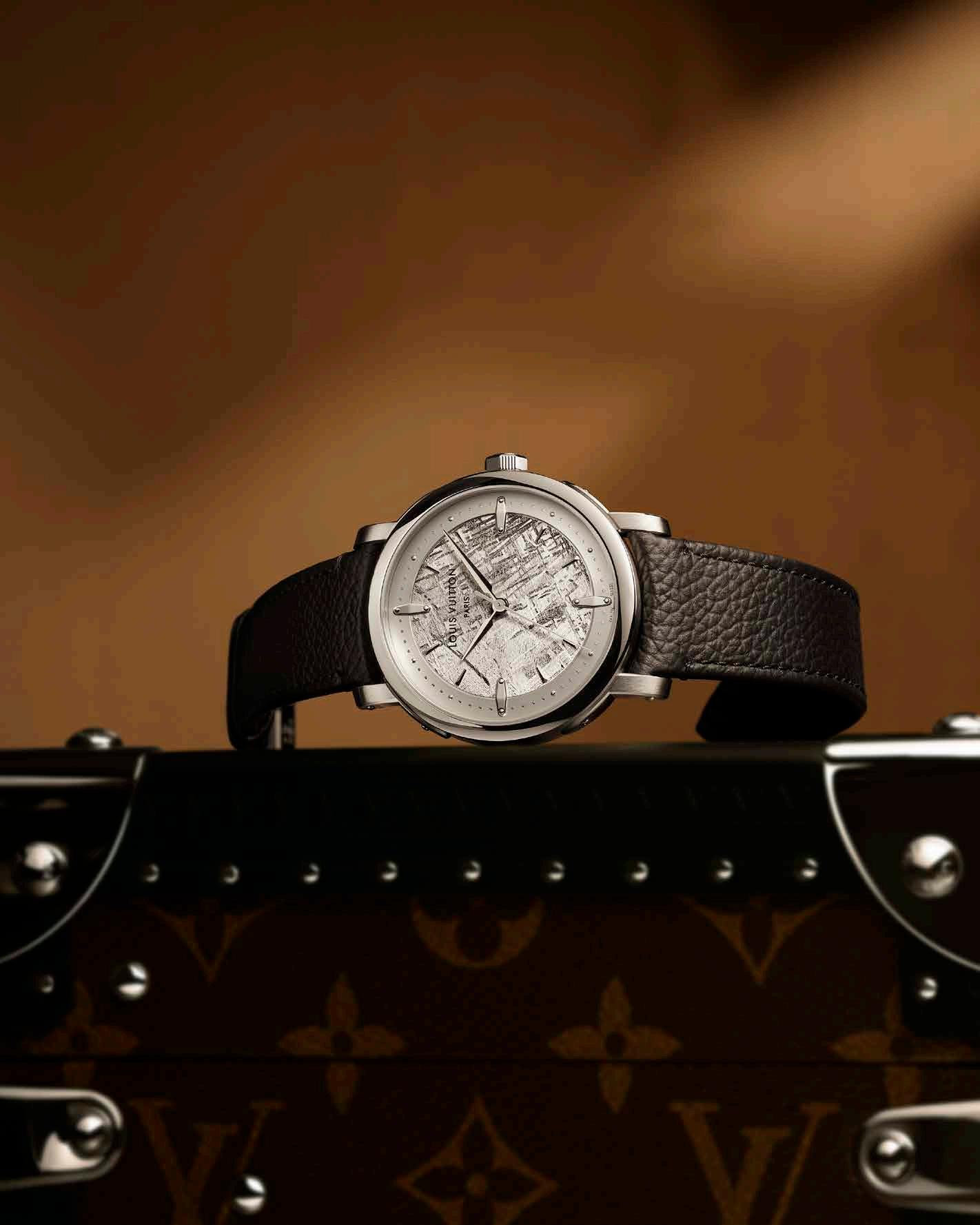


Tempus joins forces with J.P. Morgan Private Bank’s Oliver Gregson for our 2024 Wealth Report, to discover the key financial trends to know today

Oliver Gregson (left) is the region head for the UK, Channel Islands & Ireland at J.P. Morgan Private Bank
For more than 200 years, J.P. Morgan has been working with individuals and their families to help them achieve the full possibility their wealth can create.
The last few years have been transformative for JPMorganChase in the UK. Today, the firm has offices in London, Manchester, Bournemouth, Glasgow, Edinburgh, Leeds and Bristol. Along with the launch of the new digital retail bank Chase, we’ve made investments in Europe’s leading digital wealth manager Nutmeg, as well as J.P. Morgan Workplace Solutions (formerly Global Shares) — one of the best employee equity plan providers. For millions of individuals, companies and families across the UK & Channel Islands, JPMorganChase has become the advisor of choice. It makes me immensely proud.
This doesn’t happen alone. Our success is linked to the strength of the communities we serve, the talent of our people and the quality
of our relationships. The challenges of the last few years have made it clear that while our work is important in good times, it is even more significant when the going gets tough.
From our new state-of-the-art technology centre in Glasgow, to new private bank offices in Manchester and Edinburgh, Great Britain is a strategically important country for JPMorganChase. At a pivotal moment for the UK, we’re continuing to invest. Most recently, we’ve expanded our commitment by announcing £40m in new investments over a five period to help connect young people and underserved communities to economic opportunities across the country. This commitment focuses on improving access to job opportunities and helping families build stronger financial future.
As we continue to deepen our roots, our vision is clear: we are here to invest and partner with the people and communities that make the United Kingdom unique.
As I think about the future, there are four themes that often arise during my conversations with our clients. Here, I delve into what’s powering change in the UK. »
We know the future will be shaped by the impact of climate change, demographic changes and our collective response to these – as reflected in evolving business practices, policy measures, technological advancements and shifting consumer preferences. The way our clients address impact is pivoting from a siloed “impact vs investment” view towards a holistic approach with the full spectrum of their wealth plan reflective of their goals.
As trusted partners, we educate, advise and provide access to the landscape of opportunities, while managing the risks that these transitions will inevitably create. We offer our clients solutions to invest in some of the most important impact themes shaping the future – like inclusive growth, climate solutions, and health and wellness – in diverse ways and across geographies.
To this end, we recently held our annual Sustainability and Impact Summit in London. We focused on key themes like the energy transition, circularity and natural capital. We also shone a spotlight on emerging sectors with leading subject matter experts and some of the most exciting impact investing opportunities we’re finding. Our goal? To give access to invaluable knowledge, perspectives and connections on these topics in order to effect change today.


In 2018 we set a clear aim to be the private bank of choice for women across the UK. It was clear that female wealth was poorly served and understood, so we strive to reverse these trends by fuelling female ambition and advancing financial equality.
There’s a pressing need to better understand the vital roles women play in business. Over the last four years J.P. Morgan Private Bank has commissioned a report focused on the Top 200 Women-Powered Businesses in the UK in partnership with Beauhurst, celebrating the high-growth companies that are founded, led or managed by women. The report celebrates the positive impact that women-powered businesses are having on the economy with £104 billion total turnover in 2022 — as well as some of the challenges they face.
While progress has been made, much work remains to be done. We facilitate industry leading networking opportunities that foster collaboration and learning – essential elements of the women powered ecosystems. The firm’s Women on the Move (WOTM) global initiative expands women-run businesses, improves their financial health, empowers career growth and supports local communities.

The great wealth transfer is here. Over the next few decades, the next generation (next gen) is set to inherit $90trn (£70.4trn) of assets. Alongside this shift in capital is a huge transformation in the values and services this demographic will require. Equally, money is being made and transferred between generations at an earlier age.
At J.P. Morgan Private Bank we strive to support, educate and inspire the next generation, helping them realise their full potential. Our cross-generational experience helps us create productive ways of addressing generational nuances such as the next gen’s broader definition of philanthropy. For those looking to carry out strategic reviews of their family’s giving, we provide tailored advice for a burgeoning generation of philanthropists.
We’ve always been intentional about engaging future generations. Our ‘Emerging Family Leaders’ conference brought together almost 100 next gen clients, who are hungry to exchange ideas, learn more from our diverse agenda and most importantly create impact.

In an increasingly digital age, technology and AI have become more impactful than ever before. These developments offer a multitude of benefits that enable us to innovate and make our lives even more efficient. But while the opportunities are substantial, it is crucial that both current and future generations understand the ever-evolving risks that exist today.
The economic cost of cyber crime to UK citizens is currently estimated at £3.1bn.
With the increased frequency, sophistication and complexity of cybercrime, we work with families to identify risk and devise efficient mitigants across three key aspects: asset security, physical security and reputation management.
As these trends continue to shape the UK, our unifying values of service, heart, curiosity, courage and excellence are at the core of everything we do. Although needs and markets will certainly change over time, we are here to ensure our clients will always be able to access advice they can trust.
In the world of finance, creativity is making a comeback as firms such as BlackRock are hiring liberal arts grads for their fresh ideas and critical thinking skills. And with AI taking over routine tasks, creative thinking is becoming more valuable by the hour
Words: Lysanne Currie


BlackRock, the world’s largest investment firm, is used to making waves. Ever since the morning of January 2018, in fact, when BlackRock CEO Larry Fink sent a letter to the world’s top leaders urging them to make “a positive contribution to society” – quite the reverse-ferret from a CEO who just four years previously had claimed that activism harmed job creation – historically seen as one of the key moments in the rise of ‘conscious capitalism’.
Now, the company is making headlines again.
In May 2024, BlackRock COO Robert Goldstein announced the firm was looking to hire more diverse candidates – in particular, liberal arts graduates: a sharp swerve from the usual STEM majors. Interviewed at Fortune’s Future of Finance: Technology and Transformation conference, Robert said: “We have more and more conviction that we need people who majored in history, in English, and things that have nothing to do with finance or technology.”
The thinking goes that, while business concepts can be taught, liberal arts graduates bring unique perspectives, and creative and critical thinking skills that can drive innovation and growth. These skills, of logic and innovation, are highly valuable and harder to teach. For example, liberal arts grads are adept at reading critically – a skill essential for analysing complex financial documents.
And BlackRock isn’t the only firm hiring against type: other investment banking and financial giants such as Goldman Sachs, JP Morgan (where liberal arts grads comprise a good percentage of the workforce) and Deloitte are increasingly interested in moving beyond their traditional preference for finance, economics, and math majors, to embrace the

power of cognitive diversity.
As a 2017 report from McKinsey confirmed, diversity is good for business, with statistics revealing that employing people of varied backgrounds, including career backgrounds, helps bring fresh and unique perspectives, which ultimately drives innovation and unlocks growth.
“People from different backgrounds often have different thought processes,” says Deloitte recruiter Rob Dyer. “If they’ve studied history, for example, their research skills give them a huge boost. They’re self-starters – they’re used to going away, studying on their own, and coming back with a view. These are important skills for us.”
In fact, many current CEOs of major financial institutions have liberal arts backgrounds, including Ken Chennault (American Express), Lloyd Blankfein (Goldman Sachs), Brian Moynihan (Bank of America), and Stephen Schwarzman (Blackstone Group).
There’s a deeper spur behind this, in the form of two little letters with huge implications: AI.
As Robert Goldstein says, artificial intelligence is “the most significant technology, innovation, evolution, revolution of my 30-year career.”
As AI takes over routine and analytical tasks, it has created a space for other kinds of skills that are just as important. Questioning, creativity skills and innovation are going to be hugely important as AI begins to free up the capacity for creative thought processes.
As George Lee, co-head of Goldman Sachs’ Global Institute, told Bloomberg TV, “Some of the skills that are really salient to cooperate with
this new intelligence in the world are critical thinking, understanding logic and rhetoric, the ability to be creative. It will allow non-technical people to accomplish a lot more — and, by the way, begin to perform what were formerly believed to be technical tasks.”
With the unstoppable evolution of AI, this demand for creative thinkers to maintain a competitive advantage is only going to grow –as evinced by retreats offering environments that inspire out-of-the-box thinking. Phoebe Vela-Hitcox, managing director of The Lakes by Yoo has seen a huge increase in c-suite teams hiring their lakeside homes for creative thinking and top-level strategy retreats. Likewise, hotels such as Hotel Castello di Reschio in Umbria encourage participants to step away from their usual routines and think creatively, offering (alongside activities such as horse-riding, foraging workshops and Italian cookery lessons) two ‘conversation baths,’ in which spa-goers can sit and share ideas.
Ennismore founder and CEO Sharan Pasricha, agrees that “the best place to spark creativity is outside of the office. When we really want to go left-field we go up to Gleneagles – the only hotel where I can hang out [but also] dive into deep issues”.
So, as the value of creative thinking skyrockets, and bankers hire English majors over STEM grads, it all spells, as Lee cheerfully puts it, the “revenge of the liberal arts”. Will this fusion of technology and academic diversity herald a promising new era in finance? As Robert Goldstein says, “It’s that diversity of thinking and diversity of people, and diversity of looking at different ways to solve a problem, that really fuels innovation.”
WE NEED PEOPLE WHO MAJORED IN HISTORY, IN ENGLISH, AND THINGS THAT HAVE NOTHING TO DO WITH FINANCE OR TECHNOLOGY
– Robert Goldstein, COO, BlackRock




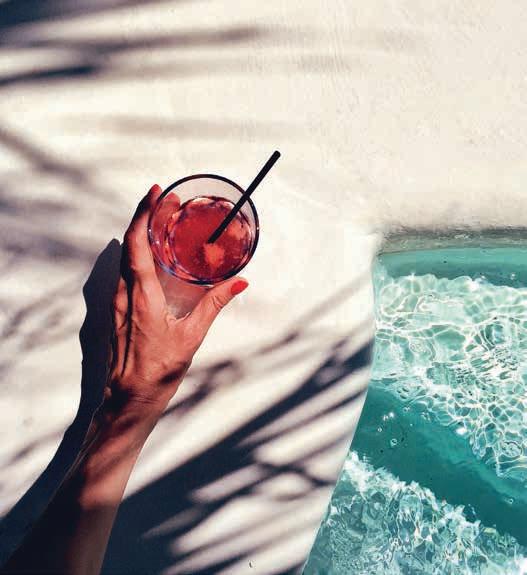

Emma and Alex Watson celebrate the first anniversary of Renais
• V&A exhibition celebrates supermodel Naomi Campbell
• David Oyelowo treads the boards in Coriolanus
• Cannes Yachting Festival gets ready to drop anchor
• Save the Date: your global luxury events calendar
Renais co-founder Alex Watson on the fine gin brand’s first anniversary – and working with his sister Emma
According to Renais founder Alex Watson, gin is best enjoyed with friends and family. This principle is one of the founding messages of the brand, created by Emma and Alex Watson, and which is celebrating its first birthday with a new Édition Anniversaire.
The exclusive bottle even comes with birthday pins, inspired the original brand illustrations by Harry Potter actor, activist and co-founder Emma. Following in the footsteps of their father, winemaker Chris Watson – who established his award-winning Chablis estate in the 1990s – Alex and Emma were inspired to use the grape skins from wine production to create a sustainable luxury gin.
In fact, with sustainability one of the siblings’ key areas of focus, there is a lot to love about this creative gin brand. Here, Alex looks back on a year of Renais, the joy of working with family, and his favourite summer serves.
Alex, congratulations on Renais’ first anniversary. Please tell us about the Édition Anniversaire?
Thank you. To mark our first birthday in style, we launched a striking limited-edition black and foiled gold bottle and sleeve that comes with birthday badge sets featuring a grape, a shell and a flower – which are nods to our previous sell-out edition, with artwork designed by Emma.
The idea behind Édition Anniversaire was to inspire a decadent evening of celebration and togetherness with a stylish and sophisticated design that would make a glamorous addition to any drinks trolley, and the perfect choice to celebrate and toast.
What sets Renais apart?
As a brand founded by family, we
want Renais to bring friends and family together. Renais’ flavour profile is unique, cultivated in France and distilled in the UK. It’s a vibrant amber-hued modern gin inspired by the produce and provenance of Northern France. The spirit is sustainably distilled from upcycled French wine pressed grapes, then tastefully infused with all-natural, rare botanicals – including hand-picked Grand Cru grapes, cubeb berries, Kimmeridgian stone, acacia honey, linden flower and rock salt.
What inspired you and Emma to establish Renais?
We have a rich family history of winemaking. My dad planted our vineyards, Domaine Watson in Chablis, and Emma and I spent most of our childhood trips there. These memories hold a special place in our hearts. Our dad went on to become an award-winning winemaker, so I learnt a lot from him around the craftsmanship of wine.
As I got older, I spent time working at the winery in France and came to the realisation that a career in the drinks industry was my calling. I had worked with luxury spirits brands for almost a decade and was drawn to brands with a strong sense of place. Inspired by two generations of winemaking at Domaine Watson, I saw an opportunity to create a gin inspired by the winemaking traditions in our family – and do something sustainable by reusing the grape skins and giving them a second life. I chatted my idea through with Emma, who also felt that pull of family and tradition.
What has it been like to work with together as family?
Working with Emma on a passion we both share has been a huge blessing. We have formed a great
team and Renais has seen some great successes despite only being one year old – the brand was awarded Gold at the Spirits Business Gin Masters in 2023 and 2024, and received great responses from critics, bartenders and even the broader community. It’s now available in 18 countries.
Emma and I complement each other very well, as we each focus on our areas of strength. I mainly focus on the operational and business side of things due to my 10 years’ experience in the drinks and hospitality industry. Emma has been massively involved in the creative side of things – so almost all of the creative you may have seen would have been directed by her. Emma’s artwork for last year’s limitededition summer sleeve featured her original illustrations, and we took these illustrations to create the pin badge motifs that come with each bottle of Édition Anniversaire.
What are your favourite ways to enjoy Renais?
In celebration of the Renais Édition Anniversaire bottle, we crafted the Crusta Anniversaire, a bespoke cocktail reimagining the classic Crusta — the height of luxury in its era, when sugar and champagne were a rare commodity. This serve is unashamedly decadent and dry, with crisp green apple notes of champagne and layers of minerality, citrus and spice.
Recently we crafted new summer cocktails, and our hero serves include the Poire Spritz, Frozais and Renais Cup – perfect sundowners to enjoy in the heat. Emma’s favourite, I think, would be the Emma Spritz – she has a bit of a sweet tooth, so we wanted to make something long and refreshing to suit her palate.
renais.co.uk

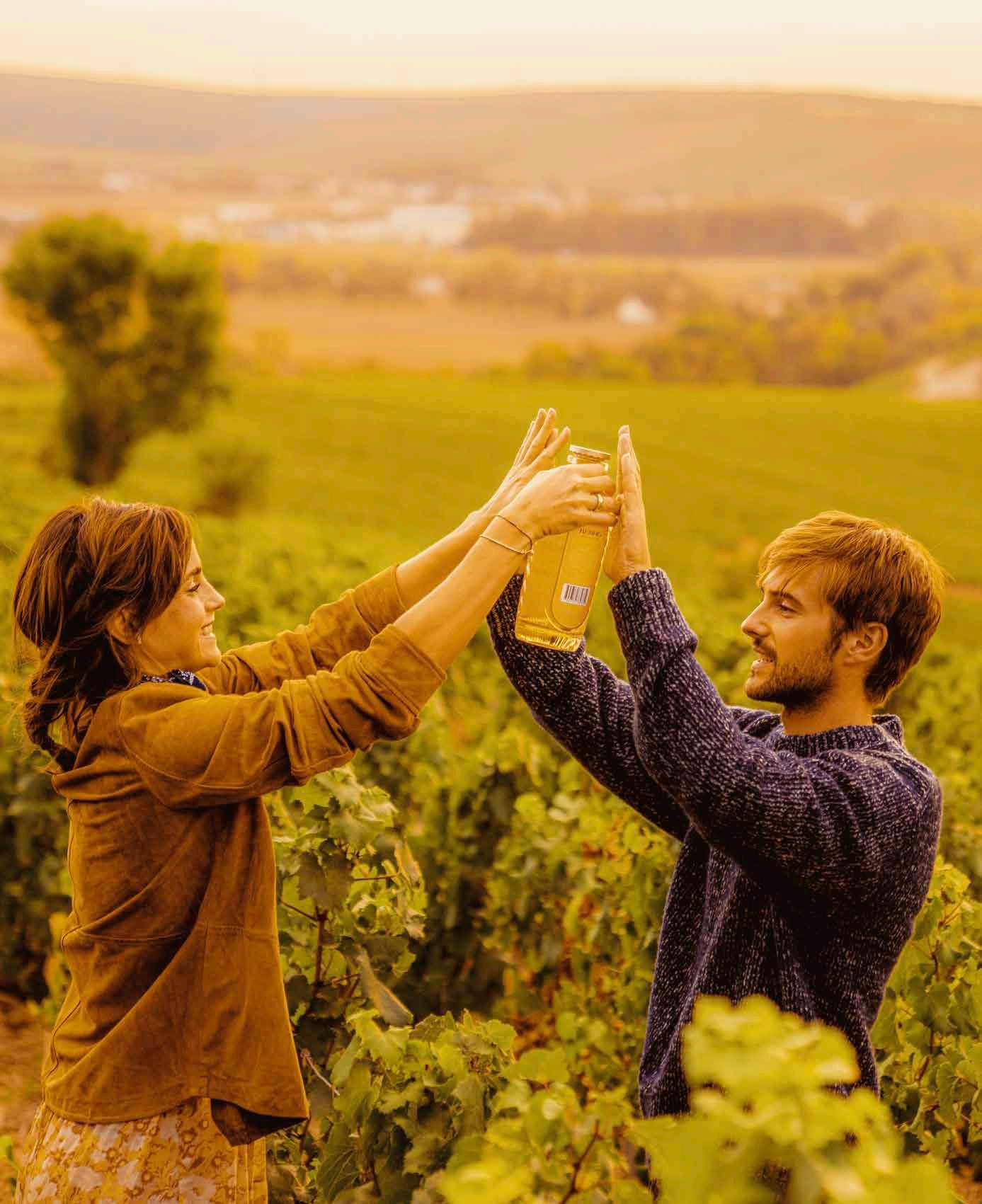

The term ‘fashion icon’ is often thrown about too liberally. But when it comes to Naomi Campbell (pictured) and her four decade legacy in the fashion industry, those words don’t come close – as London’s Victoria and Albert Museum discovered in curating its landmark exhibition, Naomi: In Fashion.
The first exhibition of its kind, curators at the V&A collaborated with British supermodel Naomi to produce this retrospective look at the model’s career. The exhibition features ensembles from the model’s personal archives, as well as her most exceptional and recognisable fashion moments – such as her look from Sarah Burton’s last Alexander McQueen show, the pink Valentino ensemble she wore at the 2019 Met Gala and a pair of staggeringly high Vivienne Westwood platform shoes from her famous 1993 catwalk fall.
“The exhibition charts Naomi Campbell’s career through clothes and image, from her South London roots to the supermodel era, right up to the present day,” says Sonnet Stanfill, senior curator of fashion at the V&A. “Her career represents almost 40 years in the business – and counting.
“A trailblazer in the field, her celebrated ability to walk the catwalk, along with the special alchemy she creates with every major fashion house, publication and photographer she works with, is captured within this project,” she adds.
Apart from her life in fashion, the exhibition also highlights Campbell’s cultural leadership, activism and passion for championing emerging designers – something that “transcends the traditional parameters of the fashion model role”, says Sonnet.
Naomi: In Fashion features designs by Azzedine Alaïa, Burberry, Chanel, Dolce & Gabbana, Gianni and Donatella Versace, Jean Paul Gaultier, John Galliano, Karl Lagerfeld, Virgil Abloh, Vivienne Westwood, Yves Saint Laurent and many others. There is also a selection of photography curated by former Vogue editor-in-chief Edward Enninful.
Victoria and Albert Museum, London. Until 6 April 2025 vam.ac.uk
David Oyelowo makes his anticipated return to the stage this year in The National Theatre’s new adaptation of Shakespeare’s Coriolonaus. Taking on the titular role of Rome’s greatest general, David (right) breathes new life into the Bard’s most complicated tragic hero. Directed by Lyndsey Turner, this political tragedy sees Coriolanus stand for election after a legendary victory brings the opportunity of high office. But while populist politicians tell the people what they want to hear, he refuses to do the same. Now, the man who was once Rome’s most celebrated warrior has become its most dangerous enemy, leaving the future of the city and its hero hanging in the balance.
National Theatre, London. 11 September-9 November nationaltheatre.org.uk
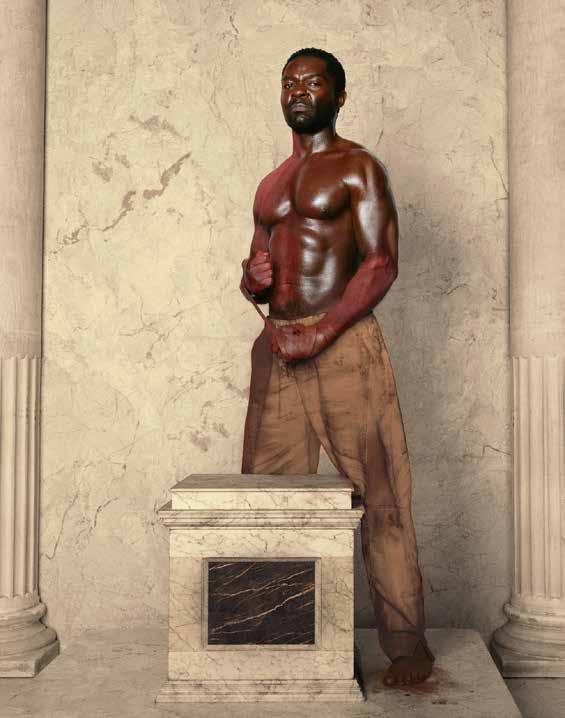
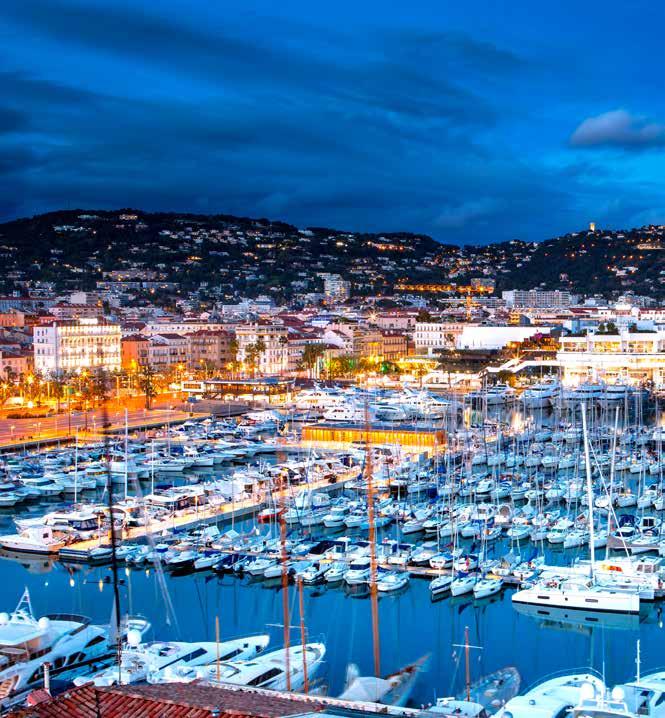
The annual Cannes Yachting Festival returns for its 47th edition in September, spanning the sparkling Bay of Cannes across two ports – Vieux and Canto. This year, in addition to featuring the most famous international superyacht manufacturers from around the world, who will be back exhibiting their luxury vessels, Europe’s largest yachting festival will also see the launch of a new area entirely dedicated to new motorboats. 170 boats up to 8m will be exhibited on land and water. With an ocean of the world’s most prestigious yachts to choose from (and test drive), there are few better ways to take in the scenic beauty of the Cannes Riviera.
Vieux Port & Port Canto, Cannes, France. 10-15 September cannesyachtingfestival.com
Your luxury events calendar for this season
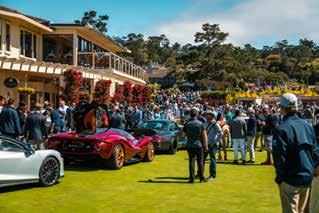
16 - 18 Aug 15 - 18 Aug 28 Aug - 7 Sep
PEBBLE BEACH AUTOMOTIVE WEEK
Delivering unmatched automotive excellence since 1950, Pebble Beach is California’s most exciting gathering for classic car fans. Take part in the Tour d’Elegance and explore the RetroAuto exhibition of rare collectibles, before enjoying the 73rd Concours d’Elegance. pebblebeachconcours.net


LONGINES GLOBAL CHAMPIONS TOUR
Celebrate the best of British equestrianism at the London leg of the Longines Global Champions Tour. Enjoy top-tier eventing including show jumping, dressage and much more at the iconic grounds of the Royal Hospital Chelsea. fiaformulae.com

4 - 7 Sep 13 - 17 Sep

FRIEZE SEOUL
The newest art fair by Frieze returns to South Korea’s capital for its third edition with more galleries and a new performance programme. Exciting exhibitions include a celebration of 10 emerging Asian artists, and installations by this year’s Artist Award winner Choi Goen. frieze.com
LONDON FASHION WEEK
The best of Spring/Summer womenswear, menswear and gender-neutral style hits the runways of London this September. Don’t miss additional programmes of virtual showcases, future stars and talks with the biggest names in global fashion. londonfashionweek.co.uk
While every effort has been made to ensure accuracy, changes to event calendars may occur. Please check with individual event organisers for more information.
VENICE FILM FESTIVAL
The star-studded celebration of international cinema returns to the Lido di Venezia, opening with Tim Burton’s Beetlejuice Beetlejuice. Angelina Jolie’s Maria is one to watch in competition and Sigourney Weaver will receive the Golden Lion lifetime achievement award. labiennale.org

25 - 28 Sep
MONACO YACHT SHOW
Monaco Yacht Show returns to Port Hercule in Monte-Carlo with more than 120 superyachts and 60 tenders exhibiting. With immersive programmes and new areas for visitors to enjoy, this is a sea-faring celebration like no other. monacoyachtshow.com
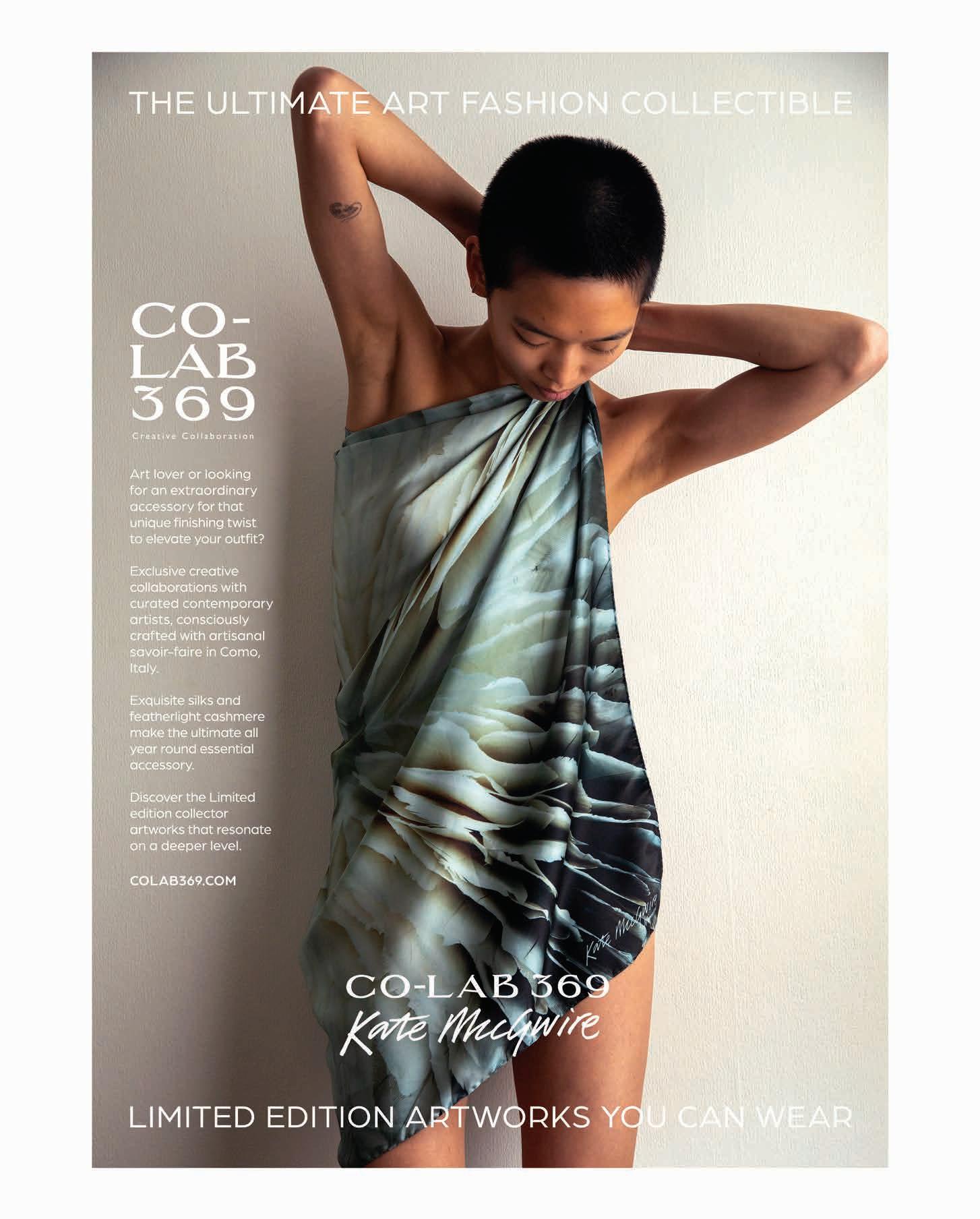
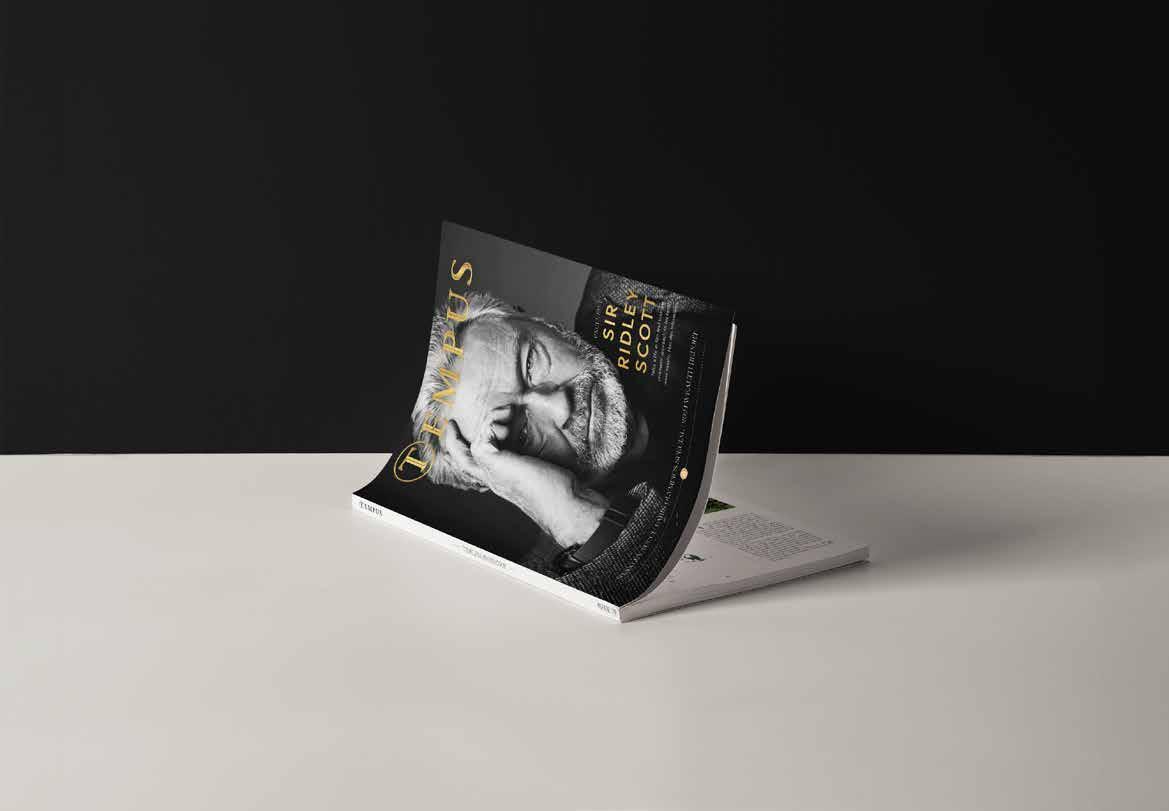
Get all the essential news and views from the world of luxury delivered direct to your door FOR YOUR DAILY DOSE OF THE BEST IN LUXURY NEWS, FEATURES AND EXCLUSIVE CONTENT
Four copies of Tempus magazine delivered to your address every year
Exclusive invitations to private events, from shoot days and polo matches to supper clubs and boutique showcases
Access to exclusive digital content
Regular newsletters featuring the latest news, reviews and exclusive member benefits

Visit tempusmagazine.co.uk/subscribe tempusmagazine.co.uk

Tempus style columnist Rikesh Chauhan
heads to Pitti Uomo for Italy’s take on this season’s preppiest serves
Twice a year, the world’s best-dressed men and women set up camp in Florence for a week of eating and drinking – and being photographed eating and drinking. Restaurants are booked months in advance, bars are overflowing well into the early hours of the morning, and the city’s dependency on coffee goes up three-fold. At least, that’s what Pitti Uomo looks like on social media. For those on the ground, it’s a playground for tastemakers and designers obsessed with craftmanship. It’s the only place where a suitable icebreaker involves slowly caressing someone’s suit lapel and softly asking: ‘What cloth is that?’.
As a photographer and menswear writer, it’s a chance for me to assess what people around the world are wearing and, particularly, how they are wearing it. It’s also another opportunity for me to see firsthand that tailoring is still thriving – and people still look significantly cooler in suits than

Generous
any other mode of dress. Even actor Jeff Goldblum, who looks good in basically everything.
This year, the three major trends really hark back to 1990s-era Ralph Lauren with a touch of ’70s nostalgia for good measure – or, as someone on Instagram put it: ‘Old money meets skater boy’. Slightly but not too-oversized doublebreasted jackets, baseball caps and wide-legged trousers are what we’re going to get into this time around.
There’s no one that cuts a suit quite like the Edward Sexton team. It’s been over a year since Mr Sexton passed away, but the team now at the helm are ensuring his legacy remains in good hands. One of their new offerings this summer is the return of the Oxford Bags. In white linen perfect for summer, these wideboys are voluminous and incredibly fun. Beautifully proportioned, they’ll look just as good on someone who’s 5ft 6in as they

do on someone who’s 6ft 5in (I certainly fall into the former category).
If you’re looking for something in a more traditional two-piece but want to be comfortable in summer as well as autumn, a heavy linen suit in a darker colourway will be your go-to. J Mueser seems to do no wrong at present, and this Olive Wool-Linen Blend Waverly Suit is certainly my pick of the brand’s incredible lookbook.
Finally, if you’re anything like me and have no time to groom yourself in the way you deserve, something to stick atop your head is usually a great solution. I have really gotten into baseball caps and, fortunately, it seems every brand in the world has, too. When there’s almost too much choice, I revert to old favourite, Drake’s. This cap is punchy, well-constructed and will look relatively in-keeping when worn with neutral, muted tones. Bad hair days, be gone.

Mueser
A single-breasted Waverly suit structured from the softest wool linen blend from Madison Woolen. This is a suit that’s appropriate for any occasion, thanks to its classic lines, beautiful colours and effortless style. It’s the J Mueser way. jmeuser.com

Yellow Chambray Baseball Cap by Drake’s
Inspired by vintage souvenir hats and sports caps picked up by the Drake’s team on their travels, this will certainly add a pop of personality to your preppy athletics. This six-panel baseball cap is constructed from a fine needlecord with a soft crown. drakes.com
